Get Daily Travel Tips & Deals!
By proceeding, you agree to our Privacy Policy and Terms of Use .
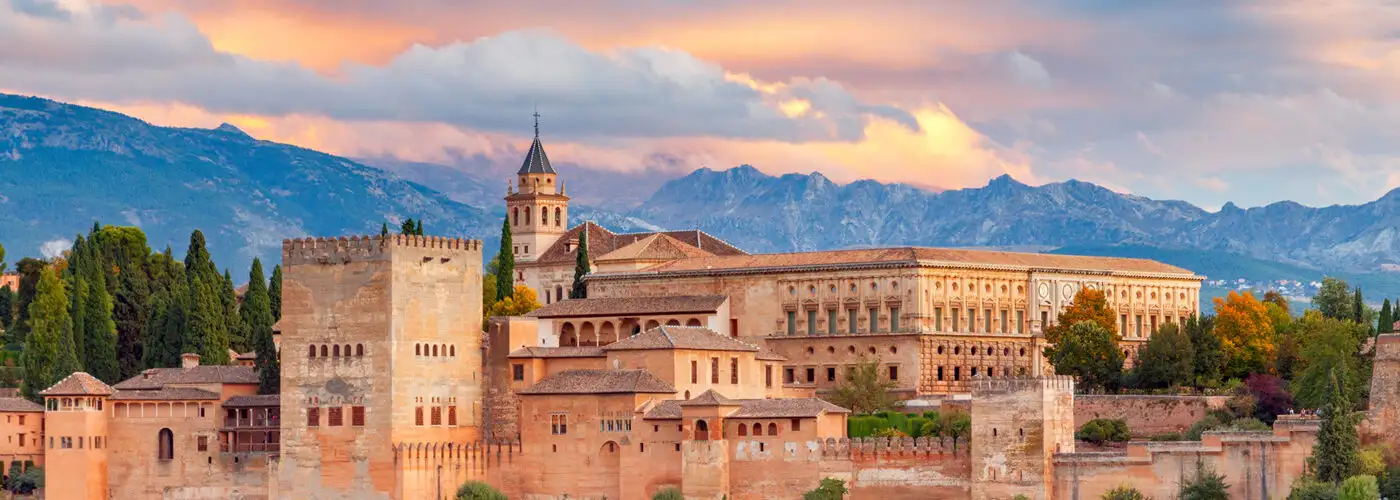

Portugal vs. Spain: Which Country Is Right for You?
Kayla Voigt
Always in search of adventure, Kayla Voigt hails from Hopkinton, Massachusetts, the start of the Boston Marathon. You can usually find her at the summit of a mountain or digging into a big bowl of pasta. Say hi on Instagram @klvoigt.
Travel Smarter! Sign up for our free newsletter.
While both Portugal and Spain occupy the Iberian Peninsula in southwestern Europe, you may be wondering: Which one should you visit? The best answer is both, of course, but which one to choose depends on what kind of vacation you want to have. Here’s the ultimate rundown on Portugal vs. Spain so you can make the best decision.
Portugal vs. Spain: Language
Portuguese is the official language of Portugal. It’s fairly similar to Spanish, but a word that goes far is obrigado/a for “thank you” (not to be confused with the Spanish gracias ).
Spain gets a bit more complicated. While the predominant language is Spanish, and you can hear and see that everywhere, Spain has several semi-autonomous regions that are proud of their heritage and language. I once hopped into a cab in Barcelona and received a grouchy “Catalan or English—no Spanish!” when I tried to give my address. Catalan is spoken widely in places like Barcelona and Valencia, but there’s also Galician in Galicia, and Basque in places like Bilbao.
The good news? English is also widely spoken in both countries, especially in the bigger cities.
Winner: If you speak Spanish, Spain is much easier to navigate. But for simplicity’s sake, Portugal wins this round.
Portugal vs. Spain: Food

Portugal offers some of the best seafood in the Mediterranean, with delicious cod, octopus, prawns, and sardines. It’s less known than other “fine dining” destinations like France, so as a result, incredible multi-course dinners are fairly affordable. This is changing quickly though, with Michelin awarding its first stars to Portuguese restaurants in 2019.
Most restaurants open late—if you can get in at 7:00 p.m., you’re likely in a tourist spot—with dinners stretching into the wee hours of the morning.
One famous dessert you can find in Lisbon is pasteis de nata , an egg custard tart sprinkled with the tiniest bit of powdered sugar. It’s heaven in a bite, and worth the long wait at Pastéis de Belem , around the corner from Jeronimos Monastery.
Spain is globally known for its delicious food, especially its avante-garde fine dining scene made famous by Ferran Adria. But Spanish food is equally delicious in its simplest form: cured meats, cheeses, and olives. You’ll find regional specialties from jamon iberico in Andalusia to paella in Valencia and sea urchin in Costa Brava.
Like Portugal, restaurants are open late. But Spain also enjoys a thriving tapas and pintxos scene—small plates at tiny standing-room-only bars—where you can start your dinner as early as 4:00 p.m.
Winner: This one is close—you won’t go wrong! Portugal is easier for vegetarians and pescetarians, but Spain continues to produce globally renowned restaurants and high-quality food across every region, making it the winner.
[viator_tour destination=”562″ type=”3-mod” tours=”16637P1,25359P1,16168P1″]
Portugal vs. Spain: Wine
In Portugal, head north to Porto, the birthplace of port. You can take a river cruise through the Duoro Valley and sample not just tawny but also ruby, rose, and white port. While you’re there, try vinho verde or “green wine,” which is crisp, acidic, and perfect to pair with seafood, not unlike a sauvignon blanc. Or you can explore the island of Madeira for a wine you’d rather drink than cook with (trust me!).
Spain is known mostly for bold, fruity tempranillos from the Rioja region (similar to a pinot noir or a cabernet sauvignon, depending on how they’re aged), but you’ll also find sparkling cava in Penedes and bright sherries from Jerez. You’ll generally find delicious, surprising options anywhere in the country.
Winner: This one depends on your wine preferences! If you’re a red wine drinker, Spain. If you’re a white wine drinker or into fortified wines, it’s Portugal all the way.
[viator_tour destination=”26879″ type=”3-mod” tours=”7372P30,30924P6,8413P19″]
Portugal vs. Spain: Key Destinations
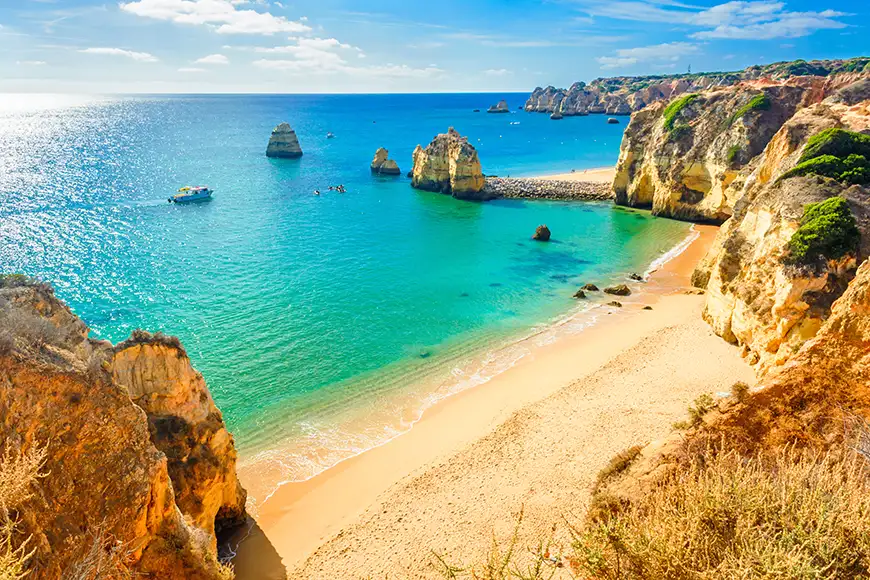
Start your Portugal trip in the capital city of Lisbon. Covered in tiles and palm trees, it doesn’t feel like the major metropolis it really is. Climb up to the historic Alfama neighborhood, listen to fado fading through the alleyways, ride an iconic yellow tram, or head to Belem to explore monasteries and palaces of old.
Portugal’s charm comes from its laid-back cafe culture. Nearby Sintra offers colorful castles and palaces that inspired Hans Christian Andersen. You’ll find delightful small towns across the country, especially Cascais, Sortelha, and Amarante. Explore medieval Obidos or the Roman ruins in Coimbra.
Portugal’s coastline boasts deep cliffs and gorgeous views. Whether you explore the caverns of Lagos, surf or sea kayak in Albufeira, or hop over to the Azores Islands, you’ll find less crowded beaches than elsewhere in the Mediterranean.
In Spain, you’ll have your pick of big cities between Madrid and Barcelona. Madrid offers cosmopolitan hustle and bustle, world-class museums, and imperial palaces; Barcelona has funky Gaudi architecture, wide-open avenues, and plenty of delicious food.
Head south to Andalusia to slow down and experience Moorish architecture or Granada’s famous Alhambra . Another alternative: Head north to Pamplona to watch the running of the bulls or make the pilgrimage by foot on the Camino del Santiago to the Santiago de Compostela. Try your hand at world-class rock climbing in the Pyrenees, cheer for your favorite team at a soccer match in Barcelona, or watch flamenco dancers twirl and stomp in Seville.
Then, when you’re ready to relax, head to the beach: Spain has nearly 5,000 miles of coastline for you to choose from. Whether you want to hang out in the sleepy fishing town of Cadiz or island hop to nightlife centers like Ibiza or Mallorca, you’ll find perfect cliffside beaches across the country.
Unlike Portugal, Spain struggles with overtourism, which has made it more difficult to visit due to long lines and crowds from cruise ships dropping thousands of visitors overnight. All that really means is you’ll have to adjust your expectations, be willing to pay for a tour to skip the lines, or travel during the shoulder or off-season.
Winner: This one also depends on what you like. For big cities with medieval charm and pristine, relatively empty beaches, Portugal’s the winner. For outdoor enthusiasts and art and architecture lovers, Spain wins this round.
[viator_tour destination=”554″ type=”3-mod”]
Portugal vs. Spain: Cost of Travel
I’ll use two of the most popular destinations in both countries as a proxy for cost—it does vary between high season and low season, and depending on whether you’re in a more popular tourist area. Porto, Portugal, for example, is much cheaper than Lisbon; the little white village of Ronda in Spain is much cheaper than bustling Madrid.
Is Portugal cheaper than Spain? Overall, yes. In Lisbon, you can find a great hotel for around $100 a night depending on the neighborhood, averaging out around $175/night. The average hotel in Barcelona is closer to $200 or $250 depending on the neighborhood.
For restaurants, you’ll pay between 10 and 15 euros for a main course in Lisbon, while Barcelona tends to be between 20 and 30 euros, especially if you’re trying to bag bucket-list dining experiences like a table at Tickets .
Attractions in Portugal also tend to be cheaper—for example, a ticket for the Tile Museum in Lisbon costs 5 euros, while the Prado in Madrid costs 15.
Winner: If you’re on a budget, you won’t beat Portugal’s value. While Spain is definitely still on the cheaper side for most of Europe, Portugal’s the winner.
[viator_tour destination=”538″ type=”3-mod”]
The Bottom Line
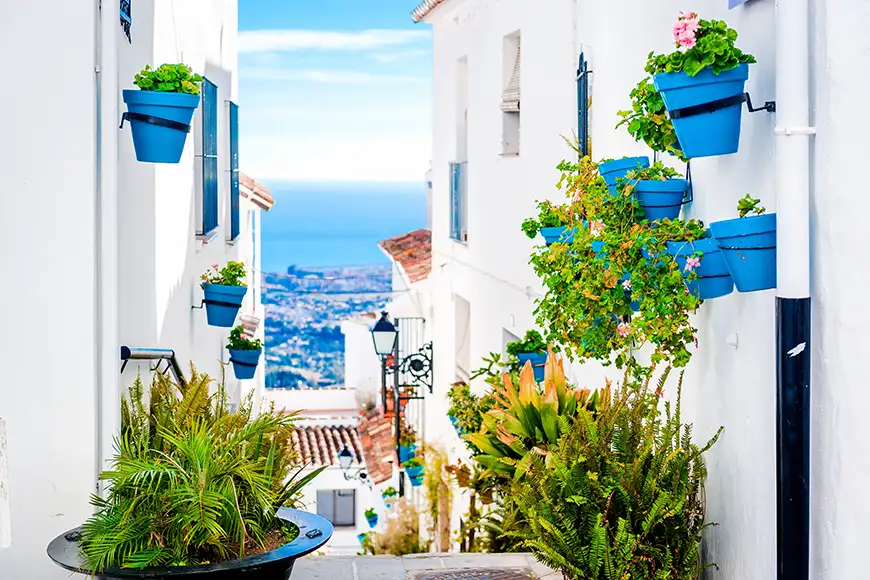
Both Portugal and Spain offer a wide variety of exciting attractions and delicious food.
Head to Portugal if you’re a seafood fanatic wary of crowds, or if you’re on a budget. Portugal is an up-and-coming destination that will surprise you.
If you’re really into fine dining, world-class museums, or rock climbing and hiking, Spain is a great choice. It’s the type of destination you can visit again and again and experience something new.
More from SmarterTravel:
- The 13 Best Shoes to Wear in Europe
- Planning a Trip to Europe: Your 10-Step Guide
- 27 Awesome Natural Wonders in Europe
[viator_tour destination=”566″ type=”3-mod”]
Always in search of adventure, Kayla Voigt hails from Hopkinton, Massachusetts, the start of the Boston Marathon. You can usually find her at the summit of a mountain or digging into a big bowl of pasta. Say hi on Instagram @klvoigt .
We hand-pick everything we recommend and select items through testing and reviews. Some products are sent to us free of charge with no incentive to offer a favorable review. We offer our unbiased opinions and do not accept compensation to review products. All items are in stock and prices are accurate at the time of publication. If you buy something through our links, we may earn a commission.
Top Fares From

Don't see a fare you like? View all flight deals from your city.
Today's top travel deals.
Brought to you by ShermansTravel
Southwest Ireland: 8-Night Trip, Incl. Guinness...
Specialized Travel Services

Luxe, 7-Night Caribbean & Mexico Cruise...
Regent Seven Seas Cruises

Ohio: Daily Car Rentals from Cincinnati

Trending on SmarterTravel
Top Destinations
- Food + Drink
Explore the best of the world. Access insider tips and hotel recommendations from our travel tastemakers
By proceeding, you agree to our Privacy Policy and Terms of Use .
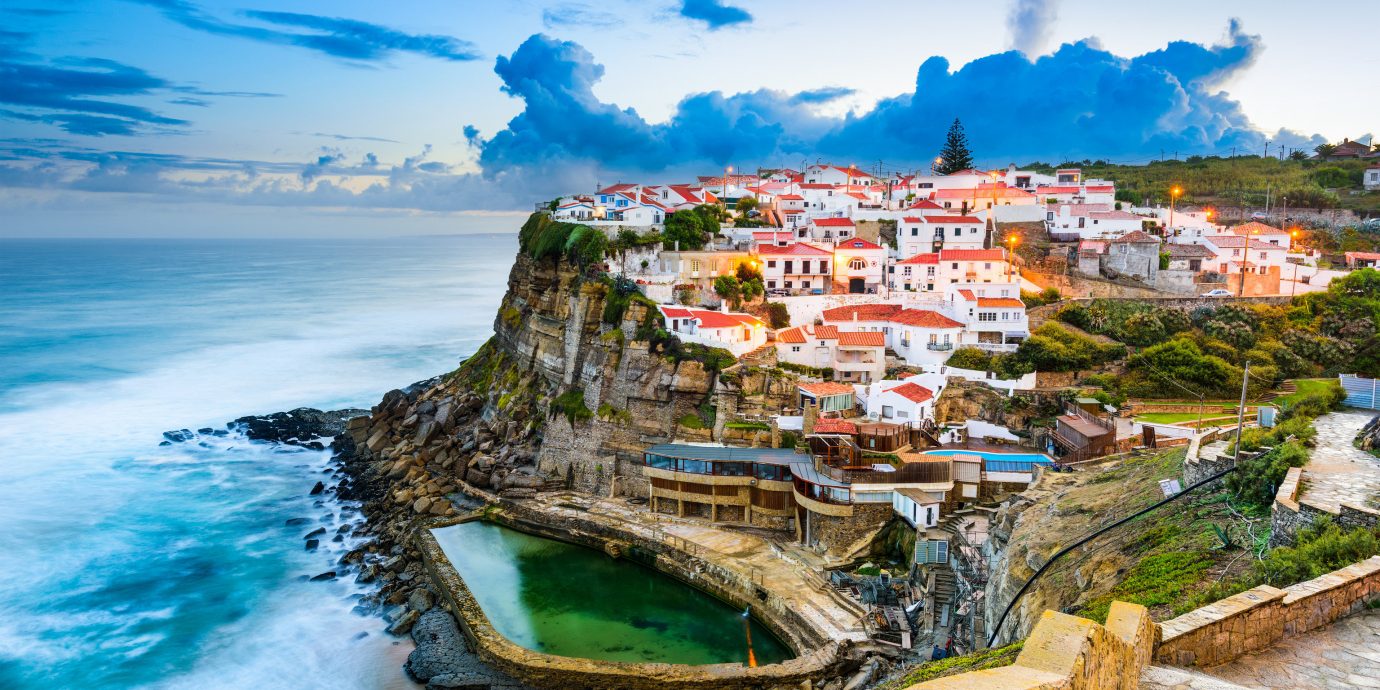
Face Off: Spain vs. Portugal
When it comes to planning your next European vacation, it’s easy to see why Spain and Portugal might vie for your attention. The Iberian neighbors share a temperate Mediterranean climate, historic cobblestone streets and terra cotta rooftops, and many of the same culinary pleasures. (It also doesn’t hurt that both destinations are endlessly photogenic.) But there are a few key differences, too. Spain, for one, is five times the size of Portugal, making it difficult to see it all in one go. And while Portugal’s infrastructure is on par with that of other European nations, its relatively slow development has made the country a bargain compared to other EU member states. Which to choose? We compiled this head-on comparison for the two in-demand locations to help you narrow down your decision.
Jen has been a staff editor at Architectural Digest, Travel + Leisure, and Martha Stewart Weddings, and her work has appeared in The Wall Street Journal, Afar, and Elle Decor. When she's not snowmobiling in the French Alps or tasting scotch straight from the barrel in Scotland, she's at home in Brooklyn with her husband and daughter.
See recent posts by Jennifer Fernandez
Getting There
Spain’s sheer size and number of major cities make it easily accessible from most major hubs in the United States and Europe via air and rail, especially during the peak summer season. Many domestic and international airlines fly direct into and out of Barcelona and Madrid, including Iberia, the national carrier, American Airlines, United, Delta, and British Airways. Smaller companies like EasyJet and RyanAir, based out of London, are best for affordable connections from major European cities to secondary Spanish outlets, such as Seville and Valencia. Once in Spain, you can easily reach cities by taxi or train.
See flight deals to Barcelona via Airfarewatchdog >

On the other hand, Portugal, while still easily accessible from most European cities and the East Coast of the United States, is still slightly underserved, and reaching Lisbon, the capital, can be subject to more limited—and sometimes more expensive—timetables. TAP, the national airline, offers direct routes to Lisbon from New York and London; other airlines, including United, Delta, and American Airlines, offer non-stop flights through New York, Boston, or Washington, D.C. Smaller airlines, like RyanAir and EasyJet, and other major carriers like British Airways and Lufthansa offer connections from Europe to Porto, Portugal’s second largest city. But unlike Spain, high-speed rail travel is less established here; you’re better off renting a car or taking a taxi from the airport.
See flight deals to Lisbon via Airfarewatchdog >
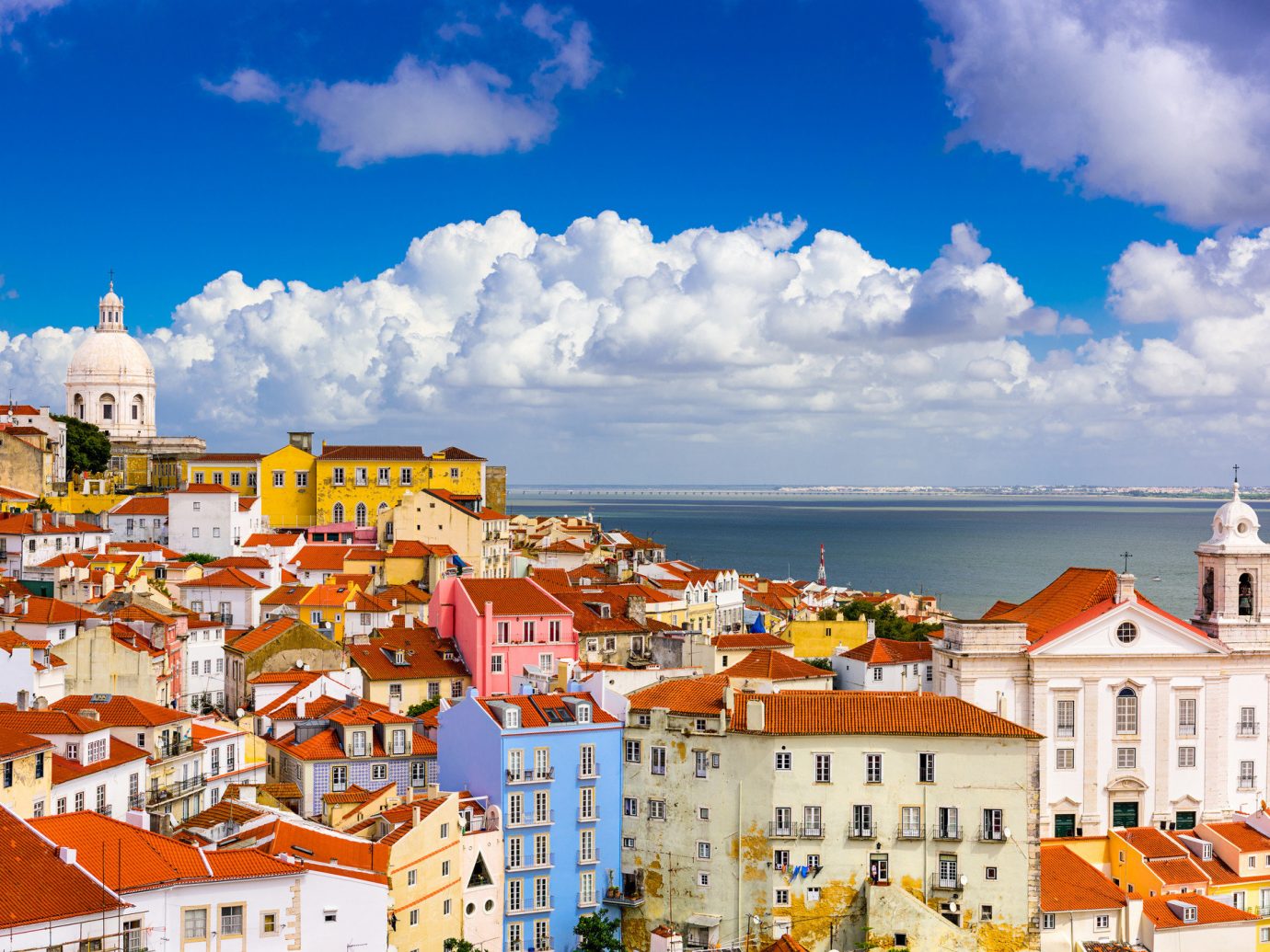
History & Culture
While Spain and Portugal share a similar historical timeline—from the countries’ ancient occupancy by the Romans to the invasion of the Moors in the 8th century, years of exploration and colony-building in the 15th and 16th centuries to periods of dictatorship after World War I—the cultures have evolved independently.
A visit to El Prado or any of the country’s world-class museums reveals that Spanish experience is dominated by creative expression. Some of Spain’s greatest contributions are in the realms of art, from the surrealist spires of Antoni Gaudí’s La Sagrada Familia to the magical realism of Don Quixote to the cubist works of Pablo Picasso. The north is known for its modernist, avant-garde architecture by the likes of Frank Gerhy and Santiago Calatrava, while the influence of Moorish settlers is visible in the grand palaces of Andalusia ( La Alhambra is a feast for the senses). And for a transportive experience that feels like a direct route into the beating heart of old España, a traditional flamenco dance performance is a must-see.
See hotels in Spain >

Where the lively claps and twirls of flamenco flourish in Spain, fado music is haunting and downright melancholy, a metaphor for the subdued pleasures that exist in Portugal. The country’s diminutive size makes it easy to explore its diverse interests. Surfers are lured to Portugal’s Atlantic coast by laid-back fishing villages and some of the world’s best waves, while history buffs prefer to see the romantic 19th-century summer residences of Lisbon’s elite in Sintra. But to truly understand the depth of the country’s national pride, be sure to visit Lisbon’s neighbor Bélem—with its famous tower and immaculate monastery—where Vasco de Gama and other 16th-century explorers once set sail for the New World.
See hotels in Portugal >
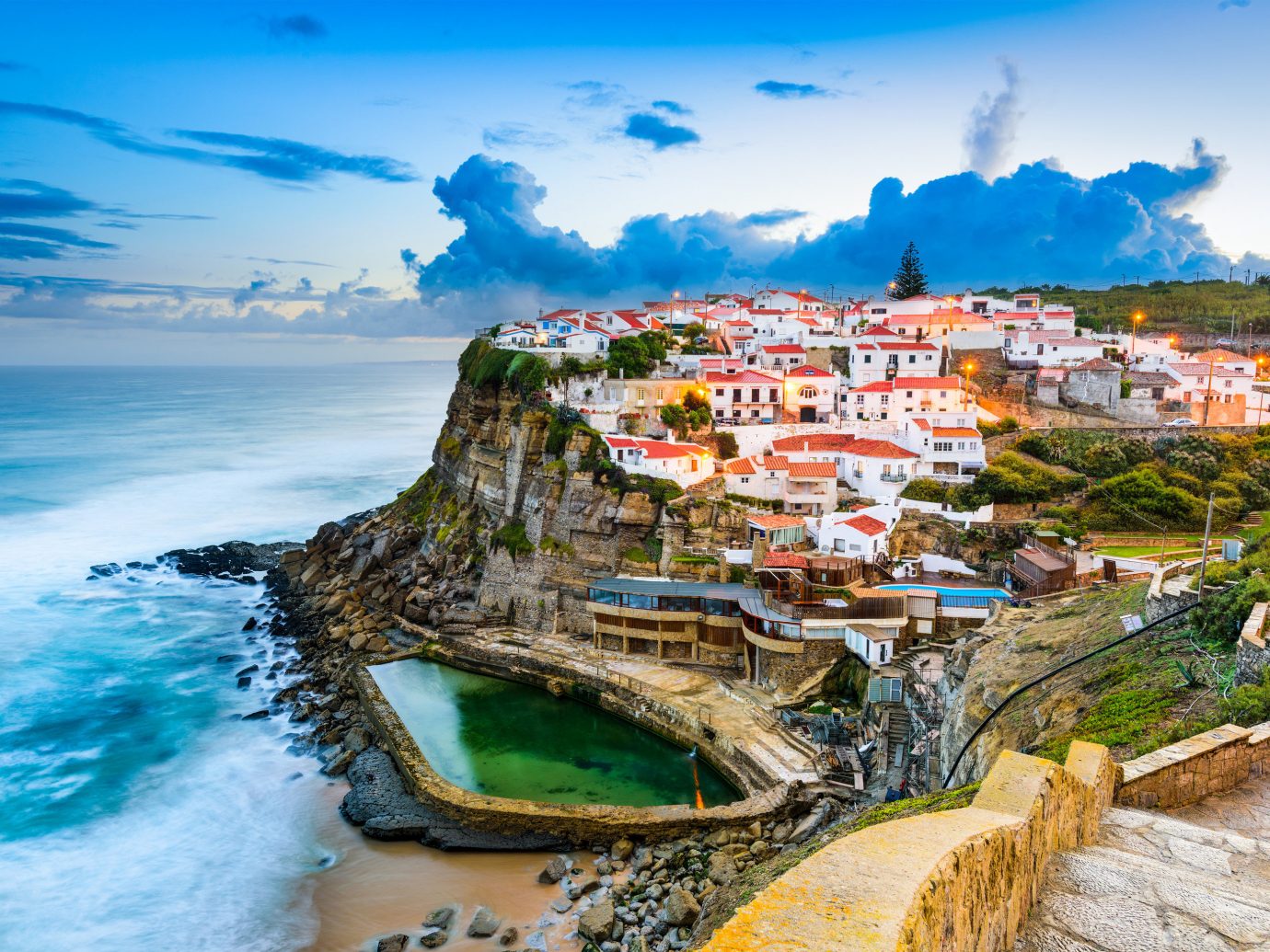
Dining and Nightlife
The culinary prowess of Spanish chefs is no secret among the epicurean cognoscenti. Today, tapas are one of Spain’s most beloved exports—and along with it specialties like pan tomate, jamón Ibérico, and gambas al ajillo (garlic shrimp). But these rustic dishes find their counterpoint in the inventive molecular gastronomy that is typified by such forward-thinking Michelin-rated stalwarts as El Celler de Can Roca and Arzak . (Don’t even think of going unless you’ve made reservations months in advance.) Given the country’s vastness, delicacies vary from region to region. Like the architecture, food in the south is infused with Moorish flavors, from saffron-scented paella to creamy ajo blanco, a cold garlic soup; the north features heartier staples with humble ingredients such as fabada asturiana, a peasant pork-and-bean stew, though seafood also plays a strong role.
Spanish wines need no introduction, as once obscure varietals like albariño, tempranillo, and rioja have gained international acclaim—and with it, the kind of in-the-know tourists who book intensive wine holidays. Less well known is the sweet yet medicinal vino de naranja, or orange wine, that comes exclusively from Andalusia. And no whiskey lover would miss tasting the Spanish sherries that flavor many of the oak barrels in which the spirit is often aged.
RELATED: The 10 Most Charming Towns in Spain
Meanwhile, Lisbon’s café culture rivals that of many other European cities. In keeping with the country’s 1,100 miles of Atlantic coastline, Portuguese cuisine centers on the fruits of the sea, namely cod, which is prepared in any number of ways: as salt-cured Bacalhau croquettes, in seafood stews with sausage and potatoes, or simply grilled with lemon and herbs. In fact, simplicity is a hallmark of Portuguese cuisine, and the flavors are typically fresher and lighter than their meat-laden Spanish counterparts.
But like Spain, Portugal is also home to a thriving wine industry. Porto is the historic birthplace of port, a sweet varietal that’s typically enjoyed after dinner. Northeast of the city the Douro Valley is renowned for its terraced vineyards and approachable touriga nacional, touriga franca, and tinta barroca grapes used in table wines across the country. For an even less traversed wine region, head south to the sleepy quintas of the Algarve and Alentejo regions east of Lisbon.
RELATED: 7 Regions in Portugal Worth Visiting (Before the Crowds Come)

With their powdery sands and azure waters, Spain’s southern shores are some of the world’s sunniest—they don’t call it Costa del Sol for nothing—and, also, some of the continent’s busiest, especially during the warm summer months. Nowhere is that truer than on the island of Ibiza, where the jet set mingle with party people into the wee hours. What that means for you? Expect a crowd. You can, however, find peace in the unassuming fishing villages of Galicia and Andalusia, as well as the Ballearic Islands and Mallorca.
RELATED: The 7 Most Underrated Places in Spain
In Portugal, unassuming fishing villages are the norm. The Azores are a chain of nine volcanic islands with primordial hot springs, lava fields, and some of the best whale watching in the world, but they can be difficult to get to unless you’re flying direct from Lisbon. Better to head to the Algarve, a quiet region south of Lisbon where the views are just as picturesque. And surf’s up on the west coast, where competition-worthy waves draw boarders both domestic and international.
RELATED: Where to Stay in Portugal: Our 10 Favorite Hotels
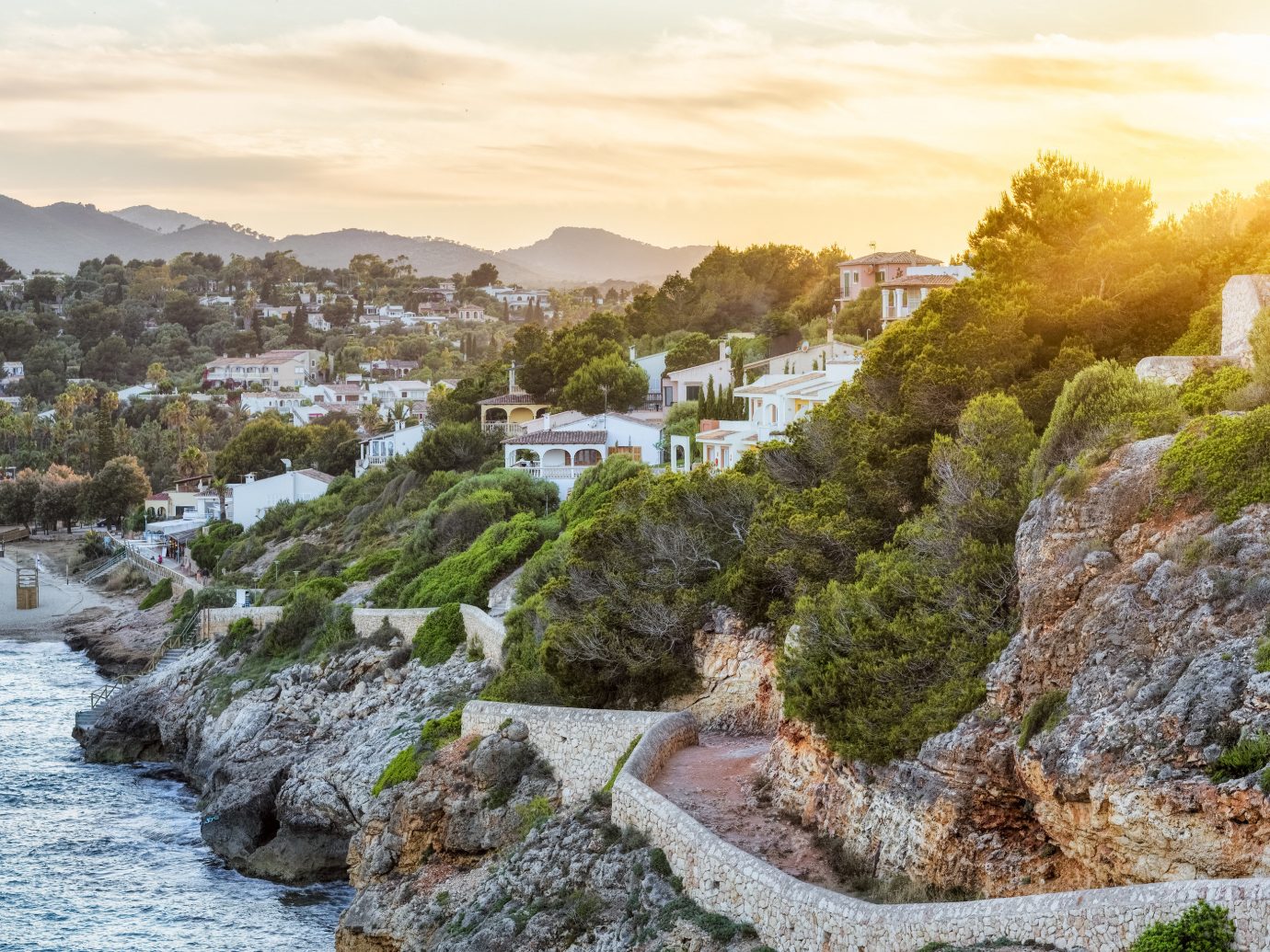
What to Wear to Spain & Portugal
Women’s dress outfit for dinner in portugal, shop the look.

Gradient Lens Sunglasses

Mango Dress

Glow Face Pallete

Wedge Sandals
Older men’s dressy outfit for a vacation in your 60’s.

Riviera Short Sleeve Shirt

Stretch Washed Chinos

Bold Bracelet Watch

Women’s Swimwear for Azores

Leopard Print Swimsuit

Ravena Beach Caftan

Round Sunglasses

Men’s Day Outfit to Wear in Azores

Button Down Shirt

Chino Shorts

Leather Belt

Arizona Soft Footbed Sandals
Women’s day outfit to wear in azores.

Whisper Cotton Tank

Drapey Shorts

Maldives Shell Necklace

Strawberry Bag

Greece Sandals
Men’s outfit for spain.

Collared Shirt

Ripped Jeans

Women’s Two Piece Outfit for Spain

Floral Bottoms

Lemon Slice Earrings

Shirley Bag

Heeled Sandals
Men’s semi-casual dinner outfit for curaçao.

Regular Fit Shorts

Leather Strap Watch

- The 6 Most Affordable Cities in Europe to Visit Right Now
- 22 Travel Accessories to Buy on Amazon This April
- The 24 Most Beautiful Places in the World to Add to Your Bucket List
All products are independently selected by our writers and editors. If you buy something through our links, Jetsetter may earn an affiliate commission.
Become a Jetsetter.
Use our insider connections to know where to go and what to do.
Thanks for Signing Up!
Related Tags
Explore more.

Hotel Granvia
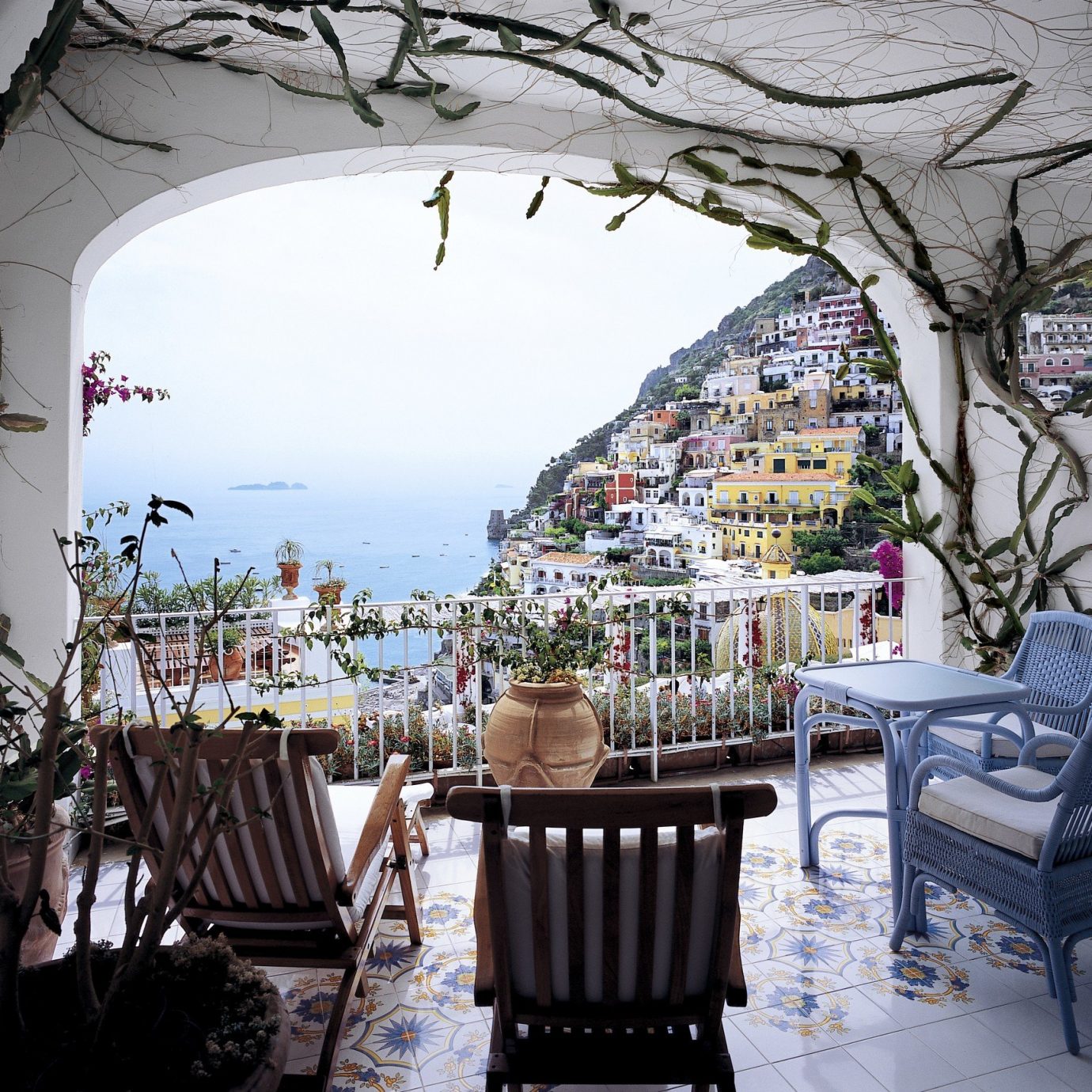
11 Most Stunning Waterfront Hotels in Europe

All the Fabulous Places JS Editors are Vacationing in 2019


Spain vs. Portugal: Which Iberian destination is right for you?
Travelers often ask: Should I visit Spain or Portugal on my next trip to Europe? At first glance, it’s an impossible question to answer. Spain has long been a beloved destination among travelers, while a recent surge in popularity has turned Portugal into one of the world’s newer tourism powerhouses.
How do you decide whether a trip to Spain or a Portugal tour is right for you? Travel to Spain and Portugal are defined by a lot of similar experiences, namely great food, rich history, fascinating culture, and inspiring nature. So, if you’re looking for a mind-blowing European destination, these countries will tick all the right boxes. But if you dig a little deeper, you might learn that one country is better suited to your interests.
Curious to learn the difference between Spain and Portugal for your next unforgettable trip with us? Read on to find out whether one of our Portugal tours or Spain tours will make for the best vacation ever.

Explore our tours Spain and Portugal tours

4.6 out of 5 stars
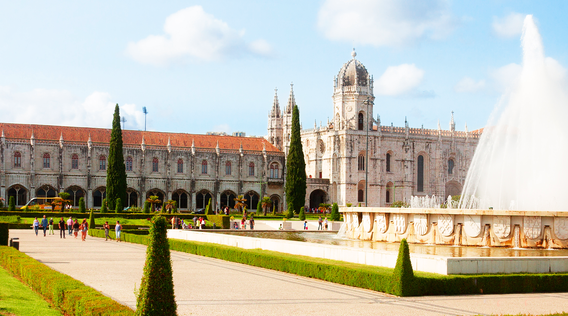
4.3 out of 5 stars

4.7 out of 5 stars

More travel inspiration


Portugal vs Spain: Which Travel Destination is Right For You?
February 26, 2020
Portugal and Spain are often compared and their close proximity to one another may have travelers wondering "which destination is right for me?"
While there are many similarities between the two countries, Spain and Portugal have some interesting distinctions that may make your decision easier.
Or if you're still undecided by the end, consider a trip that visits both !
- Consider Portugal if you have a shorter amount of time and want to cover a lot of ground
- For a shorter trip in Spain, don't expect to see the whole country

If you’re looking to tour a whole country, Portugal is significantly easier to see more of. Spain is nearly five times the size of Portugal. While you can easily see most “key” spots in Portugal within a week or two, it would take at least a month or two to be able to cover all of Spains hot spots!
If you’re on a tight time frame, seeing most of Portugal is fairly doable . Physical travel time is shorter, and within a couple hours, you can bounce between the major cities of Portugal (Porto, Lisbon, and Faro). The train between Porto and Lisbon is around 2.5 hours long, and Lisbon to Faro is around 3 hours.

For Spain, while you can take a high speed train to Madrid from Barcelona in around 3 hours, you’re cutting through the country and missing so many awesome cities. There is no “direct” route to hit all the major cities of Spain, like there is for Portugal. In terms of size, Portugal is much easier to cover most of the country.

Spain and Portugal share many general landscape similarities, since they are both on the same peninsula. Portugal is known for its coastline, so there are plenty of beaches.
Up north, there are mountains and further south in the Algarve , there are plains with the beachy Algarve region. Spain is a much larger country, so there is a bit of difference in landscape variety. Spain is filled with mountain ranges, rivers, plains, and beaches.
- Portugal is great for surfers
- Lots of choice, easy to find beaches with smaller crowds
Both countries have some truly awesome and beautiful beaches. The waves off of the Atlantic make the coasts ideal for surfers, which is why Portugal is a popular choice for anyone trying to catch some waves. Spain (especially southern Spain) boasts sun, sand, and incredible azure water. Major cities will attract crowds, and some of the best beaches will be packed in the warmer months.
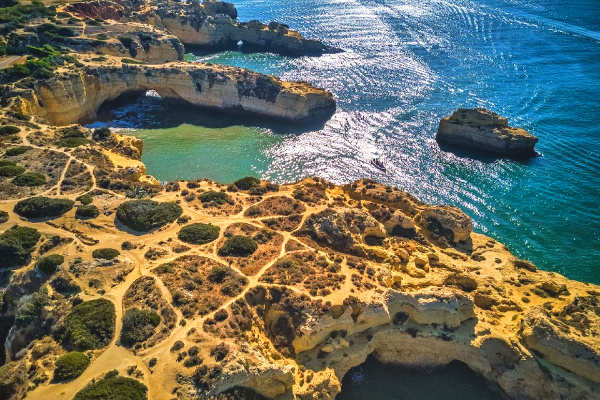
The Algarve is quieter than Spain beach towns, so visitors may find smaller crowds in Southern Portugal. The water off the Atlantic will be fairly chilly compared to the Mediterranean beaches. There is also the option of islands.
Portugal has the Azores , while Spain has the Canary Islands , Ibiza , and Majorca . The latter two are known for your traditional beaches. Both the Canary Islands and the Azores are known for its luscious and unique landscape.
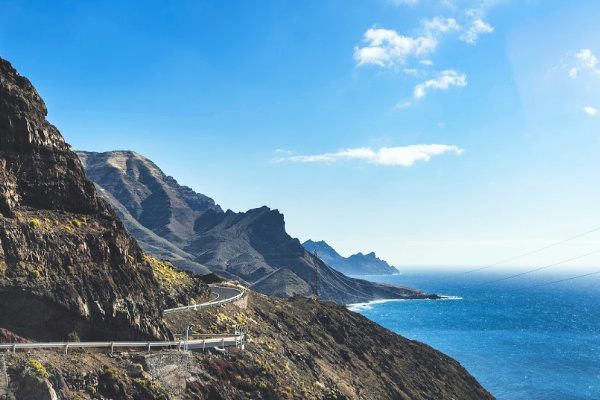
The beaches in Tenerife (Canary Island) are extra special. Most of the beaches have black sand, except for Playa de Las Teresitas. This beach sitting right outside of Santa Cruz de Tenerife has sand that is imported from the Sahara Desert.
Beaches in Northern Spain (such as Costa Brava ) are filled with cliffs and rocky coves, making for some great photography opportunities. Regardless of which country/beaches you visit, both offer postcard-worthy views.
- Spain is great for art lovers
Tourist Destinations in Spain and Portugal

If you love checking off tourist destinations, and you’re big on attractions, Spain definitely takes the win here. Simply because there are so many more major cities in Spain, Barcelona and Madrid beat out Lisbon.
That doesn’t mean that Portugal is lacking attractions. There is plenty to see, such as Sintra and other palaces. If you’re an art fanatic, Spain is definitely the place for you.
Known as the golden trio, Madrid is home to three incredible art museums. Head over to Barcelona and you can see numerous famous art creations from Gaudi, including the Sagrada Familia.
- Portugal is more affordable when it comes to food and accommodation
If you’re looking to travel on a budget, and you’re hitting the major cities, Lisbon is a more affordable destination compared to Barcelona and/or Madrid. Hotels can be found for around $100 a night in Lisbon, and these are good hotels.

For your typical hotel in Spain, get ready for nearly double that, if not more. Food is also more affordable in Lisbon. A main dish in Portugal is around 10-15 euros, where Spain nearly doubles that.
Attractions are also generally cheaper in Portugal than in Spain. Both cities are generally cheaper than others in Western Europe, but the value you get in Portugal makes it the winner for budget travelers.
See all Portugal Budget tours
Transportation
- Spain is easiest to get to
- There are fewer airports in Portugal
- Train travel is less convenient or readily available in Portugal
In terms of getting to Spain from abroad, there is no lack of international flights from North America, and within Europe. Many airlines fly directly to Barcelona or Madrid, and it’s easy to hop on another domestic flight to get to whatever city you’re trying to reach.
Thanks to smaller budget airlines, there are plenty of cheap flights from within Europe to various cities across Spain, including Seville, Valencia, and Malaga. If you’re looking to get to some of the islands in Spain, budget airlines offer affordable flights.
Flying to Portugal is a little more difficult, since there are fewer airports. Direct flights across European cities are becoming more common, but Spain definitely takes the cake on flight options.
One of the best perks of traveling within Europe is most major cities are accessible by rail! Once you reach Spain, whether it be through Madrid, Barcelona, or another outlet, it’s easy to get where you’re going by jumping on a train.
Portugal isn’t as up to speed with rail travel, so besides major cities, it’s hard to get around the country. In this sense, you’re better off renting a car.
Verdict : If you’re relying on public transportation, or you have a wider travel period, Spain is a good choice. If you’re short on time, just visiting the three major cities, and/or don’t mind renting a car, Portugal should be considered. You can drive from top to bottom of Portugal in 6 hours or so.
- Portugal is great for wine lovers
- Be sure to taste Tapas in Spain, but also explore other regional dishes
- Seafood lovers will find many unique dishes in Portugal
- Both countries have many delicious options for vegetarians
- Typically dinner meals are eaten much later in the evening than in the US

Both Spain and Portugal offer delicious but different cuisine opportunities. If you’re interested in seafood, Portugal is a treat. Experience some of the best seafood found in the Mediterranean , including options such octopus, prawns, and cod.
Because the food scene in Portugal is still growing, you can find most of these dishes at fairly affordable prices. Spain, on the other hand, has a food scene that focuses on cured meats and cheese. Vegetarians may prefer Portugal, but even if you’re not big on meat, Spain has some world-renowned restaurants.

Portugal’s wine country sits on the northern side of the country, north of Porto. A special wine that must be tried when visiting Portugal is the acidic yet crisp “green wine.” Vinho verde pairs well with seafood. In Spain, the wine is often fruity and bold, grown in the Rioja region.
Wine options are plenty in Spain, with wine regions found throughout the country. If wine tasting is a deciding factor, head to Spain for red wine, and Portugal for white wine.

If you’re a chocolate lover, a hot chocolate from Spain is a must try! The drink is much thicker than American's will be used to, resembling a liquidy, sippable chocolate pudding. If you’re trying the hot chocolate, make sure to add a plate of churros to dip in the chocolate.
Churros often come with a dipping sauce, usually chocolate and/or caramel. If you’re in Portugal, stop by a bakery and try an egg tart. These tasty treats are usually only one or two euros. Most people enjoy them with a latte, but if coffee isn't your thing, they are still yummy on their own.
Something to be noted
In both countries, many locals dine late into the night. Some places open up early to accommodate tourists, but dinner is normally eaten much later.
If you need a quick bite to hold you over while waiting for a late night dinner, tapa dishes are popular in Spain. Small bites offer the opportunity to try various foods, and are often meant to be shared among a group. Even if you’re by yourself, tapas are generally small enough you can order a couple and try a few different options.
- Portugal tends to be more laid back
- Spain's big cities are hot spots for art and history
Spain’s culture is heavily influenced by art. This is especially apparent through the architecture. Take La Sagrada Familia for example, and the other architectural masterpieces of Gaudi that float around Barcelona.
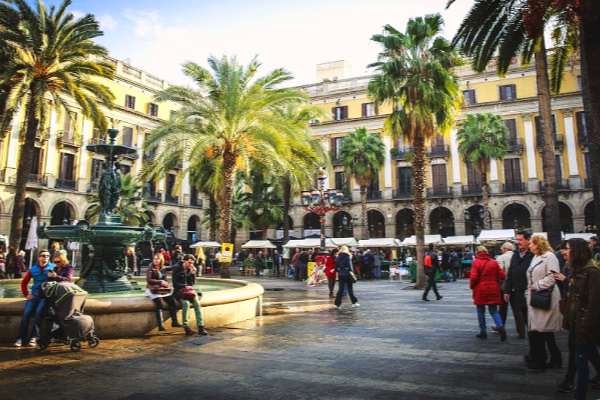
Portugal has a more diverse culture, depending on which area of the country you’re in. Down south near Faro and along the coast, you’ll find villages and beach vibes, thanks to some awesome waves that bring great surf. History floats through Lisbon and Portugal, which is apparent through the architecture.

Portugal is more laid back with small towns and castles to visit. Since most of the major tourist spots are near the coast, you’re not very far from the water and beautiful views. Jump on one of the yellow trams that take visitors across the cities, often onto tight streets. Weave through the city and up the hill (Lisbon is steep!) via the tram, and soak in the views over the ocean. The tram is cherished by both locals and visitors.
Spain has bigger cities filled with hustle and bustle, including museums, shops, world-class food, and famous art. Once out of the big cities, it’s easy to find smaller coastal towns with some relaxation opportunities.

You don’t have to go far from the big cities, if you want to do a day trip. Consider heading down to Sitges, about a 30 minute train ride south of Barcelona. The white wall architecture sits on the coast. Enjoy a meal in a café and spend some time popping in the shops, or relaxing near the water.
- Spain is the better destintion if you're after a lot of nightlife activities
Both cities offer great options for nightlife. It’s no secret that Barcelona is one of the biggest party cities in Europe. Many of the cities in Spain offer various forms of nightlife, including late-night tapas bars, rooftop bars (incredible in the warmer weather!), and plenty of clubs.
Anyone looking to go to a party in Spain should also be aware of the party scene of Ibiza Island. Ibiza is one big party. Spend the day hanging on the beach, and get ready for world-class DJs to perform late into the night.

Be prepared to pay a pretty penny to join the Ibiza party/nightlife scene. If you’re looking to stay on the cheaper side, stay on mainland Spain or head over to Portugal.
Portugal also has bars and clubs, but most of them are found in Lisbon and there is less to choose from. If finding a good night club is a priority when trying to decide which country to go to, Spain is the clear winner here.
Weather / Climate
- Mediterranean climate
- Portugal is warmer year round on average

Both Portugal and Spain have Mediterranean climates, so the weather shouldn’t be a deciding factor for which country you choose. Both offer mild winters, with winter temperatures range in the 50s-60s, while Summer can jump up to the high 70s-low 80s.
If you’re looking for sunny days and warmer weather, consider visiting through April-October, when temperatures are warm and the sun is plenty. The cooler months (November-March) bring a fair amount of rain.
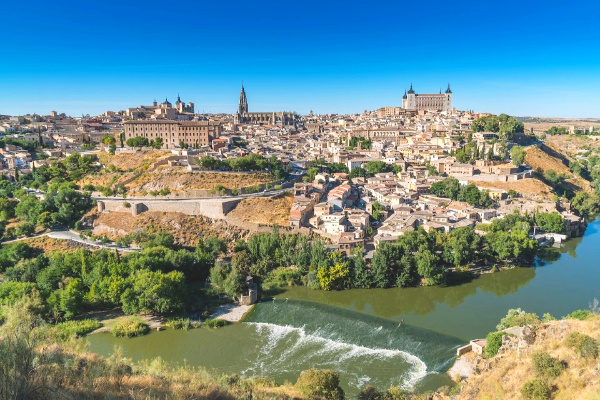
Because of Portugal’s size, the weather is more balmy and coastal, where Spain is larger so it has a bit more variety. Both destinations are popular in the colder months, as it’s an easy “winter escape” from the cold. Similarly, you can’t go wrong in the summer months. Hot temperatures with awesome beaches provide the perfect summer getaway.
Overall Verdict
The country for you depends on what you’re searching for! If you want go-go-go action, always looking to bounce between tourist attractions, and want major city action, Spain is probably the route to take. If you want some relaxation and a laid-back vibe (but still fun!) Portugal may be more your scene.
Portugal offers a laid-back charm, while Spain is great for architecture enthusiasts and art lovers. Spain has a much larger tourism scene, meaning long lines and crowds during peak season. Cruise ships also dock in Spain, which can bring in even more visitors.
Shoulder season helps ease the crowds and long lines. If you want smaller crowds but you’re traveling during summer, consider Portugal. Shoulder season and winter, both places are good options. Both countries share a lot of similarities, including gorgeous beaches, incredible food, and good weather.
Portugal is up and coming, and as their tourism industry expands, Portugal will be a top contender for European vacations, like countries including France, Italy, and Spain. With that, consider visiting Portugal while it’s an up-and-coming destination, while prices are still reasonable and it’s not overcrowded with visitors.
If time allows it, consider joining a tour that visits both countries ! There are numerous tour companies that offer the opportunity to visit both Spain and Portugal. Neighboring countries and budget airlines make it incredibly easy to visit both countries in one trip.
See all Spain Tours
See all Portugal Tours
How well do you know the world?

Connect & Share
" Portugal vs Spain: Which Travel Destination is Right For You? "
Popular posts

15 Top Bucket List Destinations

Best Tours & Trips to Ecuador & Galapagos Islands 2023

10 Reasons Estonia Should Be on Your Travel Bucket List

Top Tips for Planning a Trip to Machu Picchu

Italy vs France: Which Travel Destination is Right For You?
Recent posts

River Cruise Experience with American Cruise Lines

Top Travel Trends for 2024

The BIG January Sales Are Here!

10 Top Travel Destinations For 2024 - Where To Go Next!
- Visit Oyster on Facebook!
- Visit Oyster on Pinterest!
- Visit Oyster on Instagram!
- Visit Oyster on Twitter!
- Subscribe to stay up to date!
Yes, send me expert tips and deals!
By proceeding, you agree to our Privacy Policy and Terms of Use .
- Subtract one room 1 Rooms Add one room
- Subtract one adult 2 Adults Add one adult
Portugal vs. Spain: Which One Is Right for You?
See recent posts by Katherine Alex Beaven
At first glance, Spain and Portugal seem like two peas from the same pod. Both countries share space on the Iberian Peninsula, exude an old European feel, and are known for their tasty cuisine, which features many of the same core ingredients. We love Portugal for its charm -- something you can still find in many parts of Spain, but is lacking in other European countries. Meanwhile, we have a soft spot for Spain, due to its healthy art scene, diverse landscape and activity offerings, and balance of history and modernity. So, which country deserves a spot on your must-visit list? The short answer is both. However, deciding which one to tackle first and why is another story. Luckily, we've laid out how both countries stack up in a number of important categories, so you can decide where to go on your next vacation.
Getting Around Spain and Portugal
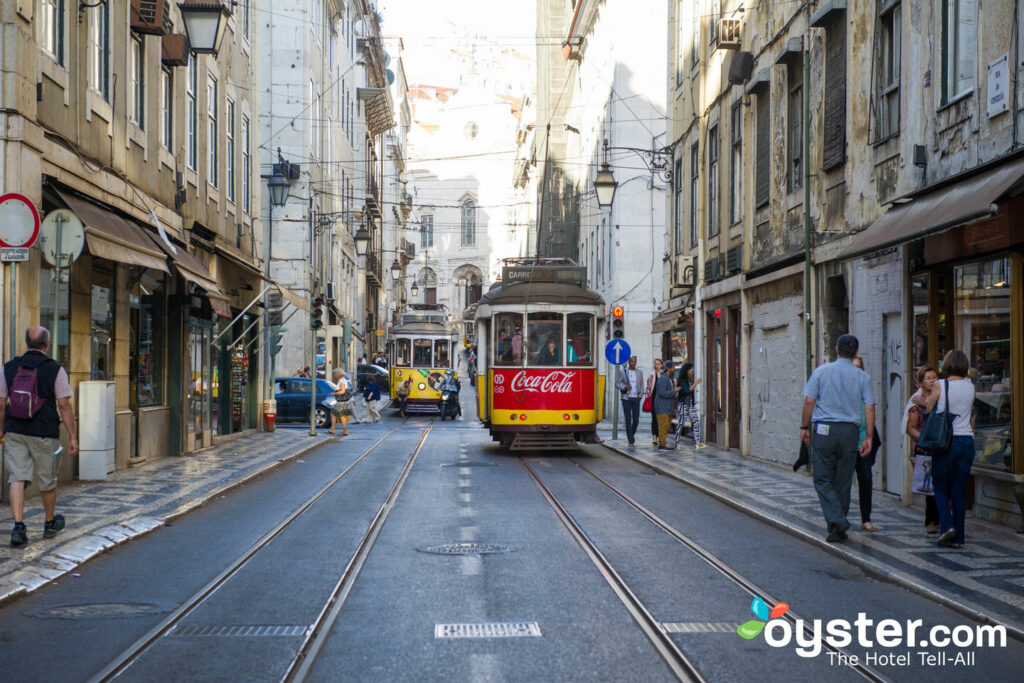
Tickets from the U.S. to both Spain and Portugal are easy to come by and, as long as you stick to major city airports, the cost is just about the same. However, Spain is home to several big city airports (Barcelona, Malaga, Ibiza, and Madrid), while Lisbon is your only option in Portugal. Traveling through both countries is easy by bus or train, and driving is also an option. While trains are comfortable and affordable, they are basic, as are buses. Most tickets can be booked at the train station, or online for buses, and you’ll need to print it out for certain companies.
Verdict: Spain has more affordable flight options and a wider train network, making it an easier pick for transportation to and between cities. However, if you’re short on time, Portugal’s smaller size is worth considering. The drive from tip to tip is about six hours, while that time nearly doubles for a journey across Spain.
Food in Spain and Portugal

Spain and Portugal have excellent food and wine scenes, and visitors with a penchant for savory snacks will be satisfied in both. Don’t expect too many vegetables in either county, although you are likely to find greens popping up in tapas or side dishes (Portugal’s caldo verde soup and Spain’s charred Padron peppers are worth trying). More often than not, you’ll find tomatoes, potatoes, and onions in supporting roles for main dishes. Spain and Portugal do share one exceptional delicacy, though: Iberico ham. This expensive and highly-coveted cured ham is produced from Iberian pigs who freely roam the forests on the central and southwestern regions of the Iberian Peninsula, right between Portugal and Spain.
Eggs, rice, and pork also frequently appear in Spanish dishes. Popular meals include paella in Valencia, shellfish such as razor clams and barnacles in Galicia, and octopus, fried croquetas, or potato and egg omelette known as tortillas. For dessert, the national sweet treat is warm churros dipped in a cup of melted chocolate.
Over in Portugal, dishes tend to be more protein-forward, with a heavy lean on pork and seafood, particularly cod — the country is marked by a long coastline, after all. Expect to see tasty dishes like salt-grilled sardines, bifana (simple pork sandwiches), Francesinha (gravy-drenched ham and cheese sandwiches from Porto), and suckling pig. The national dessert here is pastel de nata, a warm custard egg tart with cinnamon. Don’t be surprised if you see folks lining up for hours at Pastéis de Belém, just outside of Lisbon.
When it comes to wine, Portugal is more famous for its whites, particularly Vinho Verde, though Porto’s port wine is a huge draw as well. Meanwhile, most Spanish wines come from red varietals.
Verdict: Both countries offer delicious grub, though you’ll have a slightly stronger chance of finding vegetables on the table in Spain.
Things to Do in Spain and Portugal
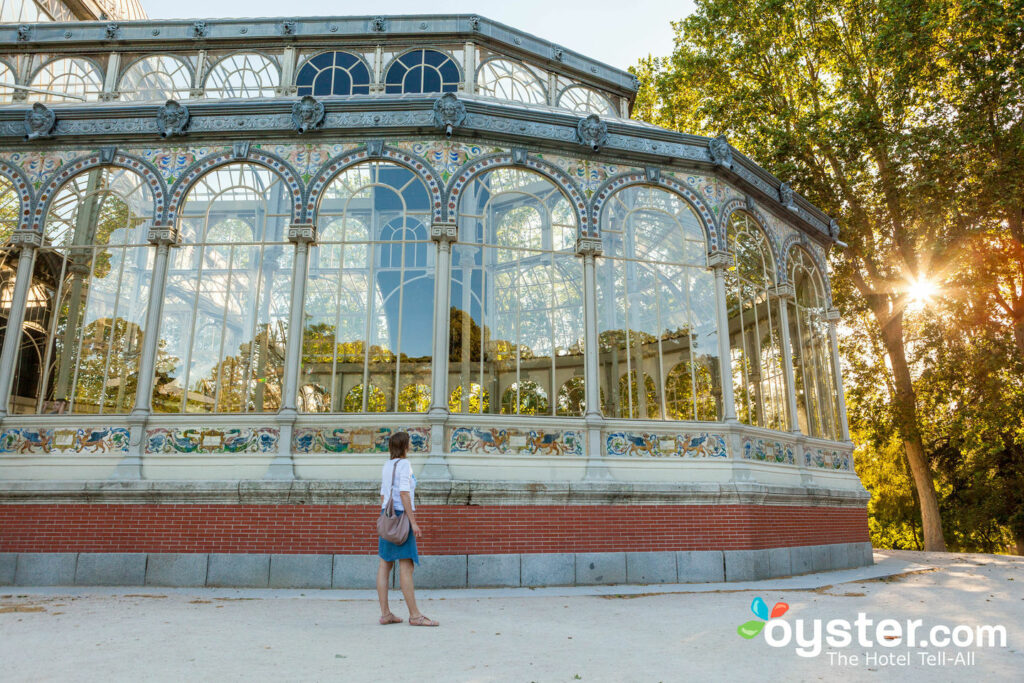
Spain and Portugal are packed with museums, art, culture, and architecture. However, there is more ground to cover in Spain, which is over five times the size of Portugal.
Madrid , Barcelona , Valencia , Seville , and Bilbao are some of the more touristic cities in Spain, though smaller spots, like historic Toledo, shouldn’t be overlooked. Birthing great artists like Gaudi, Picasso, and Dali, Spain is unsurprisingly an art lover’s dream come true. Visitors will find world-class museums here, from Museo Nacional del Prado in Madrid to the Guggenheim in Bilbao. However, the country is filled with so much architecture that you need not venture indoors to appreciate that the country is a creative mecca. Other popular things to do in Spain include eating, hiking along the Camino de Santiago, dancing at a top-notch nightclub, taking in a flamenco show, or running with the bulls.
Like Spain, most Portuguese cities are walkable, meaning you can spend hours upon hours exploring the different neighborhoods. The cobblestone streets winding through Porto are picture-perfect at every turn. Porto’s walkable streets lead to world-class contemporary art galleries, understatedly chic coffee shops, and markets filled with local meats, cheeses, and sardines Sampling Portuguese wines can also become a full-time hobby while here, either with trips around the Douro Valley or to the port cellars and wine caves opposite the river in Porto. While Spain’s museums have Portugal beat on the whole, there’s a smaller art scene worth checking out here. While in Lisbon , visit the 11th-century Castelo de Sao Jorge on a hilltop overlooking the city. Then, head down to explore the mosaic-cobblestone sidewalks in the 18th-century center. Other activities in Portugal include fishing, hiking, and day trips to small villages stocked with castles.
Verdict: If you’re short on vacation days, Portugal’s smaller size and relative accessibility make it a smarter pick. If you’ve got the time, or have a particular penchant for the arts, Spain is where you’ll want to be.
Beaches in Spain and Portugal
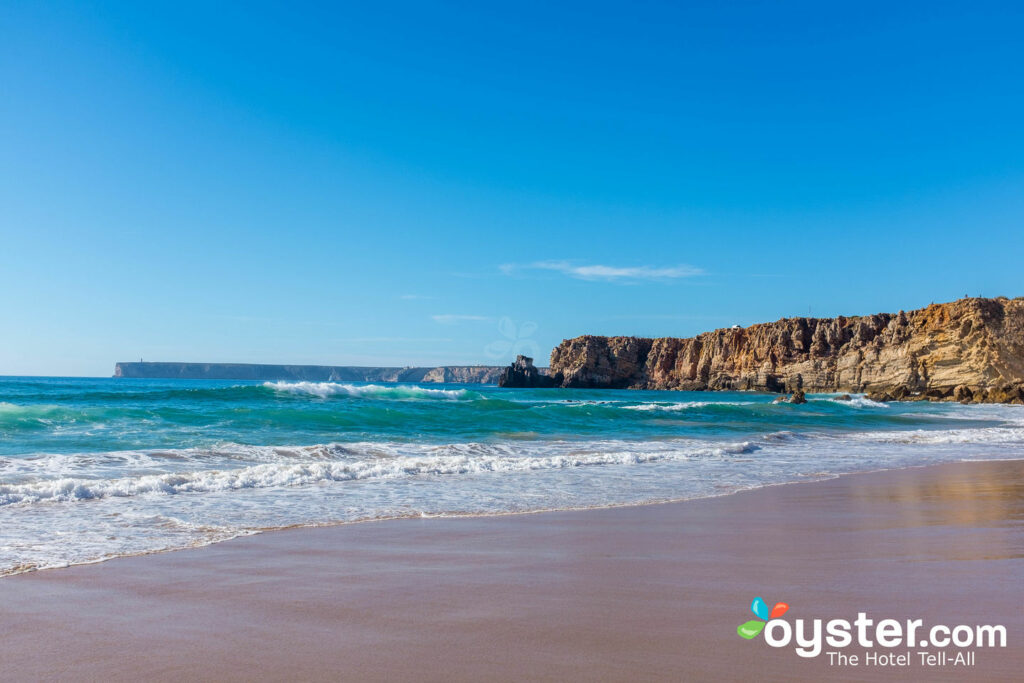
Both Spain and Portugal are home to long stretches of coastline. However, Spain has more variation since it has two coastlines — one in the northwest, off the Atlantic Ocean, and one along the Mediterranean that wraps around the southern tip. On the Atlantic side, you’ll find a slew of natural, wild beaches with frigid waters and soft sand. The favorite beach town here is San Sebastian , famous for its wide stretch of sand, beautiful ocean views, and striking city backdrop. Over on the Mediterranean side, there’s the ever-popular Costa Brava , which extends from Barcelona up to France. This gem is full of intimate rocky coves, sandy beaches with beautiful water, small villages, and gorgeous cliffs. From the stylish Formentera scene to the dramatic natural stone arches of Playa de Las Catedrales in Galicia , you’ll have plenty of options in Spain.
Portugal only has beaches on the Atlantic coast, since its eastern side borders Spain. That being said, it’s a slim country, so a beach is never too far away. Being up against the Atlantic also means that you’ll find waters that are colder than on the Mediterranean (and more waves, which are great for water sports, but not so much for swimming). Although Portugal’s coast stretches all the way up its west side, most folks flock to the southern Algarve region, where the scenic rocky coastline, warmer temps, and picturesque setting are big draws. Specifically, Praia da Rocha in eastern Lagos offers caves for exploring with the kids (and isn’t too busy). And, when in Lisbon , don’t miss Praia do Guincho, featured in the Bond movie “On Her Majesty’s Secret Service” and just 30 minutes from the city. Lastly, for pure beauty and swimmable water, Praia de Marinha is right up there with the best beaches on the continent.
Both countries are home to plenty of islands, though Spain’s selection, including Ibiza , Tenerife , and Majorca , features more of your typical beaches. The Azores in Portugal are gorgeous, but the main focus is on the emerald lakes and lush landscapes. To help plan your beach getaway, check out our stories on the best beaches in Spain and Portugal .
Verdict: Thanks to a larger variety of islands (and two coastlines), Spain rings in with more traditional beach options. If you take comfort in knowing that you’re only ever going to be three hours from the beach (at most), then Portugal is your pick.
Safety in Spain and Portugal
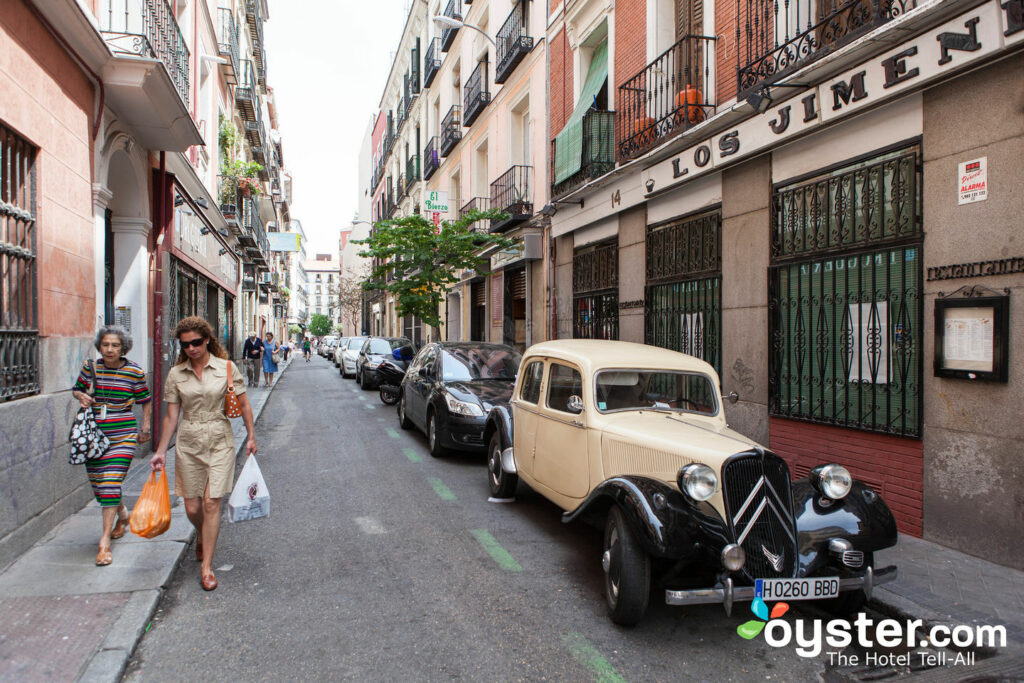
Generally speaking, Spain and Portugal are both safe countries and have a low to non-existent rate of violent crimes. However, like many places in Europe, you’ll need to watch your wallets, pockets, and personal items as pickpocketing and petty theft are par for the course here. If you’re driving, it’s worth noting that roads in Portugal aren’t as up to snuff as they are in Spain. In fact, Portugal has one of the highest number of road accidents in Europe, partially due to aggressive, fast drivers on highways and main roads. On the other hand, Spain is known for its car scammers, so keep your wits about you if someone flags you down or offers to help change a tire. Take all of the usual safety precautions: Don’t flash expensive items, secure your wallet, don’t abandon your belongings, and don’t get roped into conversations or situations where you can be easily distracted.
Verdict: Portugal may have more dangerous roads, but you’ll likely encounter less day-to-day petty crime in the big cities.
Weather in Spain and Portugal
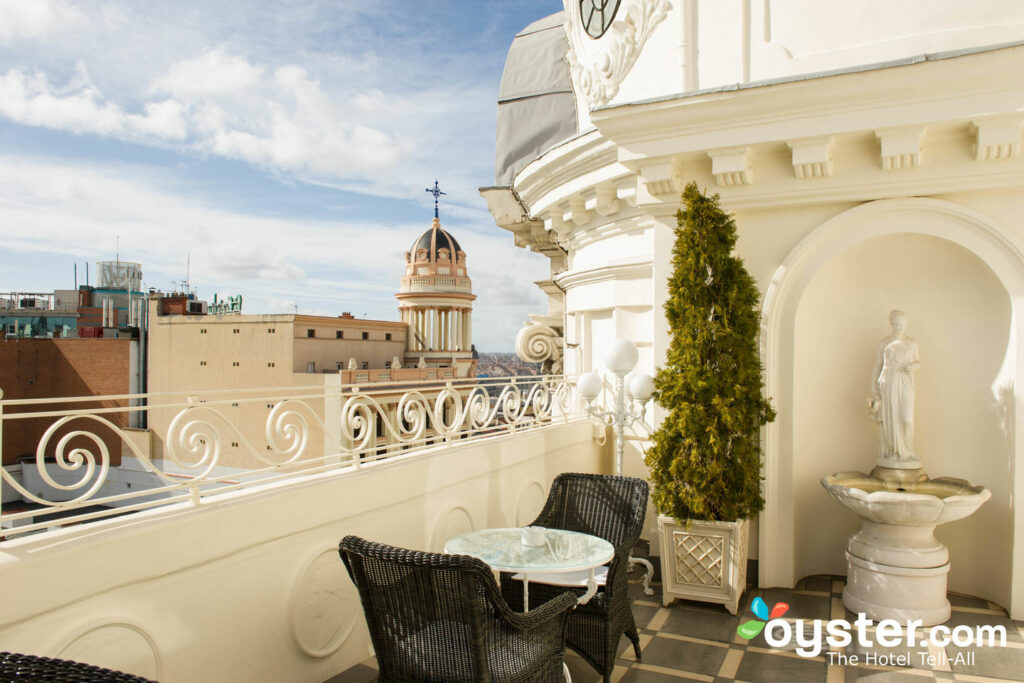
Both Spain and Portugal have Mediterranean climates, so weather isn’t a big differentiator when deciding between the two destinations. You can expect average summer temps around 75 degrees Fahrenheit, and winter temperatures typically bounce between the 50s and 60s. These are both fairly humid countries, especially during the winter rainy season, though Portugal’s Algarve region has a dry and sunny climate all of its own. Spain’s northwestern Galicia region also tends to have an oceanic climate with slightly warmer temperatures in both summer and winter. The best time to visit both of these countries tends to be in summer or spring, since fall and winter bring lots of rain.
Verdict: It’s a tie! Portugal comes out on top for its slightly balmier coastal weather, though Spain’s larger size means you’ll find a little more variation when trying to navigate shoulder seasons.
Costs to Travel in Spain and Portugal
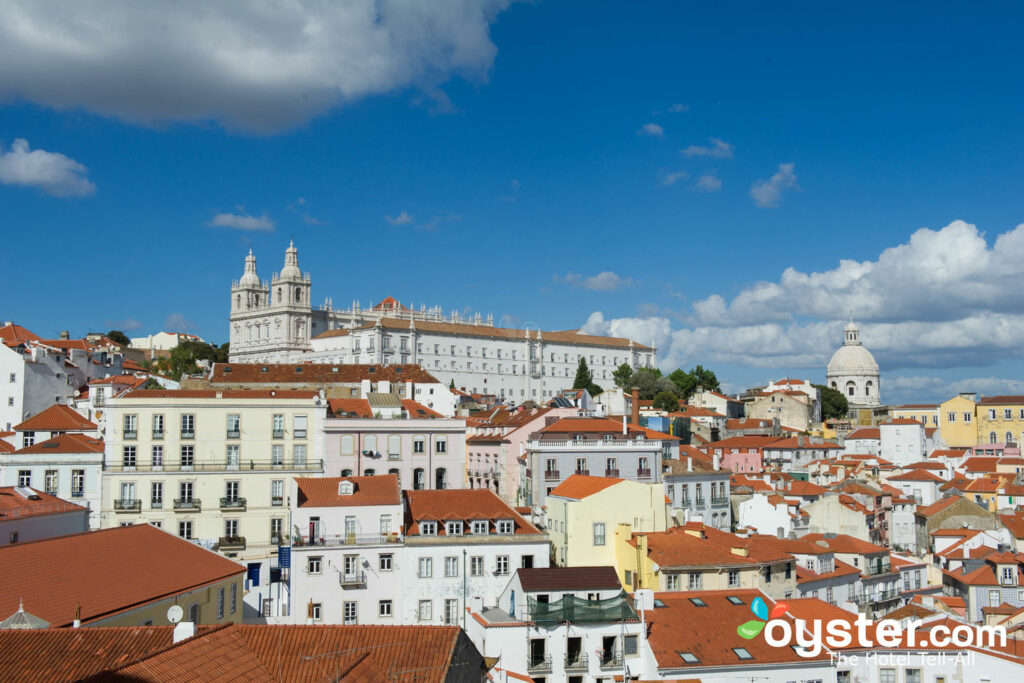
Madrid and Barcelona are both known for their late-night party scenes that draw revelers of all ages. So, whether your idea of a night out includes endless tapas and glasses of wine at a street-side Barcelona cafe, or cocktails and champagne on a sleek hotel rooftop terrace in Madrid (try The Principal ), Spain will probably exceed your nightlife expectations. And these aren’t the only two cities in Spain worth your nighttime attention. For an eclectic and increasingly sophisticated scene, including wine bars in historic mansions and craft beer bars, head to Picasso’s home city of Málaga. Antigua Casa de Guardia, a bar where local wines are poured straight from the barrels, has been around since 1840 and is said to have been one of the artist’s favorite spots.
Meanwhile, Lisbon also has some of the liveliest nightlife scenes in Europe. Things do not start early here (travelers will find they often have restaurants to themselves if they show up to dine any time before 9 p.m.). Post-dinner, enjoy casual drinks at a local bar. Even better, Lisbon doesn’t have laws against open containers. In the Bairro Alto neighborhood, you’ll be elbowing your way through crowds of revelers clutching all manner of beers and cocktails in take-out cups. On the weekends, the party heads to the nightclubs around 2 a.m. — don’t show up earlier or you’ll be quite lonely.
Verdict: Spain gets the nod for nightlife in our book, thanks to its variety of nightlife venues across the country.
Our Hotel Picks
In Spain: Hotel 1898
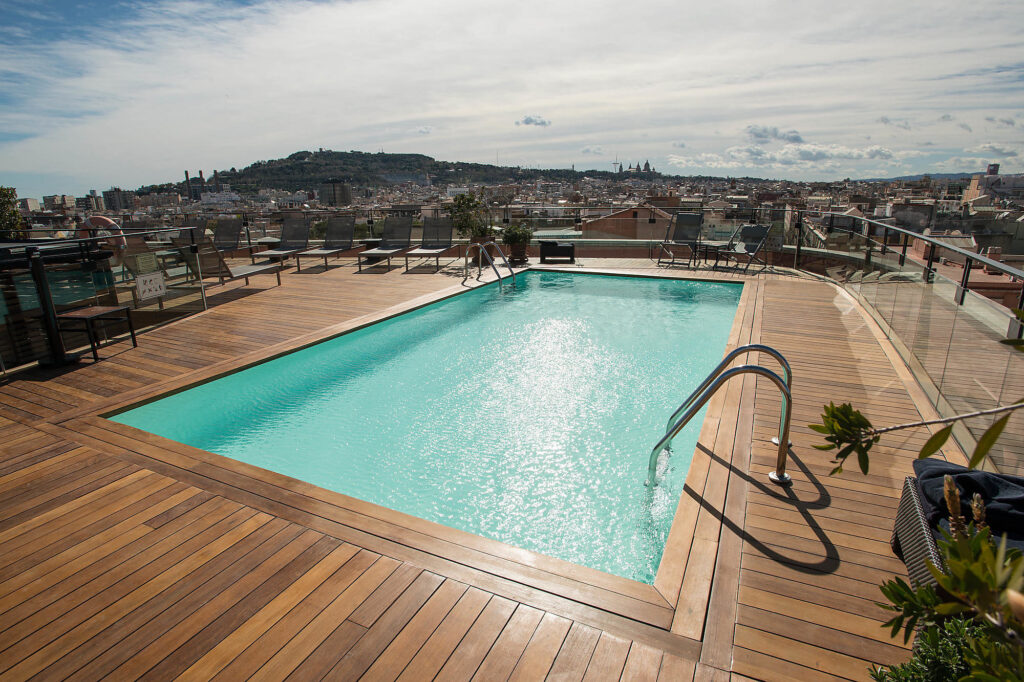
Hotel 1898/Oyster
Located on a prime piece of Las Ramblas real estate, the Hotel 1898 evokes Spain’s opulent late-19th-century past with its architecture and decor. But guests get thoroughly modern pampering, with sterling service, plush rooms, a spa, and fine dining. And unlike other Las Ramblas area hotels such as Casa Camper, Hotel 1898 has not one but two pools: an indoor pool in an atmospheric grotto and a rooftop pool with panoramic Barcelona views. The property is the perfect pick for travelers willing to spend more for historic style and upscale comfort in a location right on the bustling Las Ramblas, near Passeig de Gracia shopping.
Pricing for Hotel 1898
In Portugal: Grand Muthu Oura View Beach Club

Grand Muthu Oura View Beach Club/Oyster
The Oura-View Beach Club is billed as a five-star property, but in reality it’s an upper-middle-range resort complex overlooking the sea, with direct access to the popular Praia da Oura beach and a location a short walk from the strip. The 177 apartment-style rooms all feature well-equipped kitchenettes, dining and living areas, and terraces, though they’re in need of renovation and housekeeping isn’t every day. The outdoor pool is lovely, with ocean views, waterslides, and a splash pool.
Pricing for Grand Muthu Oura View Beach Club
Traveling? Consider the Carry-On from Away
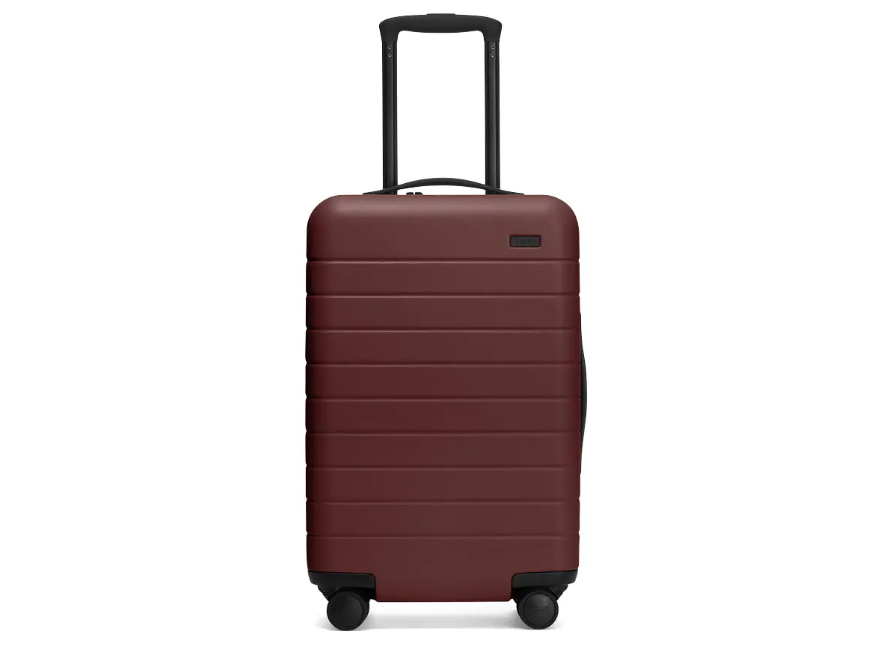
The Carry-On from Away
Still lugging around that outdated carry-on from 2006? It’s time for an upgrade. With 360° spinning wheels, a TSA-approved lock, a super hard exterior shell, and a USB-port for charging whatever it is you need charged, the Carry-On from Away is built to be your last.
Related Stories:
- The 11 Most Beautiful Beaches in Portugal
- Barcelona vs. Madrid: Which is Better for You?
- 6 Insider Secrets Every Visitor to Lisbon Needs to Know
Additional reporting by Sarah Amandolare.
All products are independently selected by our writers and editors. If you buy something through our links, Oyster may earn an affiliate commission.
Top Stories

- Travel Tips
Top 11 Las Vegas Hotels on the Strip for Every Type of Traveler
By Christina Vercelletto
- Tips & News
Escape to an Adults-Only Paradise: Win a Luxurious Trip to Hotel Three Sixty in Costa Rica
By Caroline Morse Teel

12 Best LGBTQ-Friendly All-Inclusive Resorts Around the World
By Lauren Dana

Which Bahamas Island Is Right for You?
By Kyle Valenta

The 16 Coolest Themed Hotel Rooms in the U.S.
By Gwen Pratesi
Spain vs Portugal: Where Should I Travel?
Customers rate Zicasso's travel referral service 4.9 on a scale of 1 to 5 based on 1549 reviews on Trustpilot
We match you with top tour companies that specialize in the trip you want, whether it's a customized private tour or a group tour.
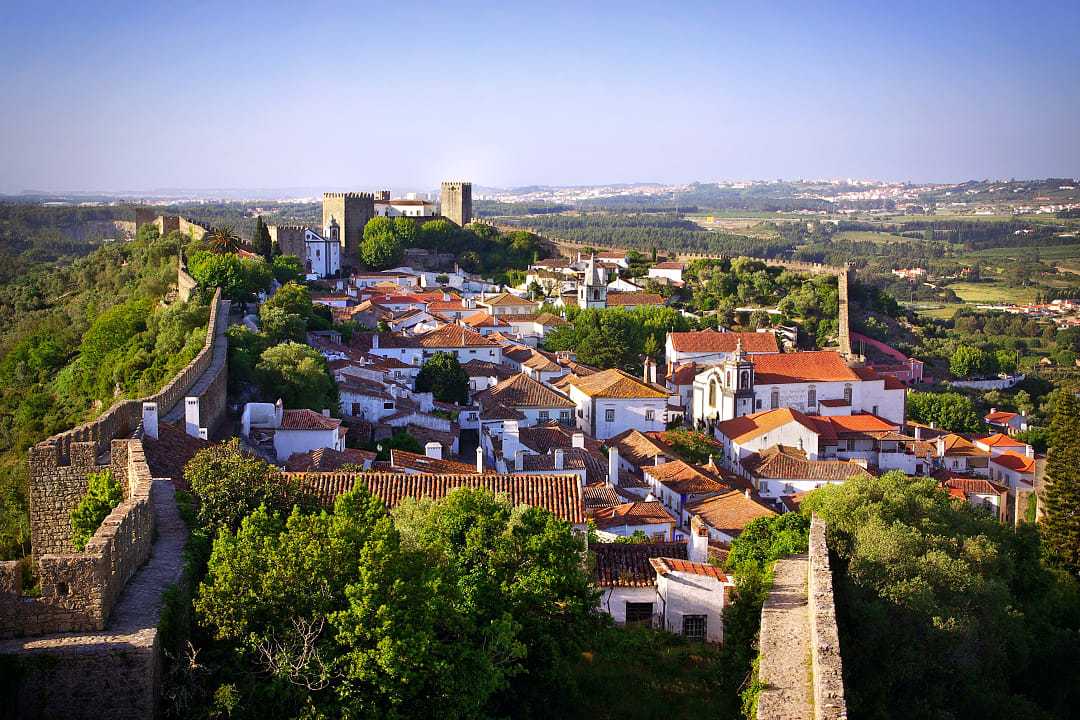
Medieval village of Obidos in Portugal
When choosing between Spain and Portugal for your vacation on the Iberian Peninsula, you can find breathtaking beaches, awe-inspiring historical towns, and mouthwatering food and wine experiences.
From fairytale castles to Moorish palaces, Michelin-starred restaurants to antique wineries, Spain and Portugal share an entangled history and similar weather patterns. With diverse coastlines, famous wines, and established tourism infrastructure, both countries provide the makings of an unforgettable Mediterranean trip.
The following information can help make choosing between Spain and Portugal easier when looking to plan, book, and enjoy a custom-tailored vacation.
Where is Spain?
Where is portugal, what are the similarities between spain and portugal, what are the differences between spain and portugal, does spain or portugal have better beaches, what are the top activities in spain and portugal, is spain or portugal a better food destination, is spain or portugal a better wine destination, is it easier to travel to spain or portugal, is spain safer than portugal, can i visit spain & portugal, choose spain if you prefer, choose portugal if you prefer, discover spain or portugal.
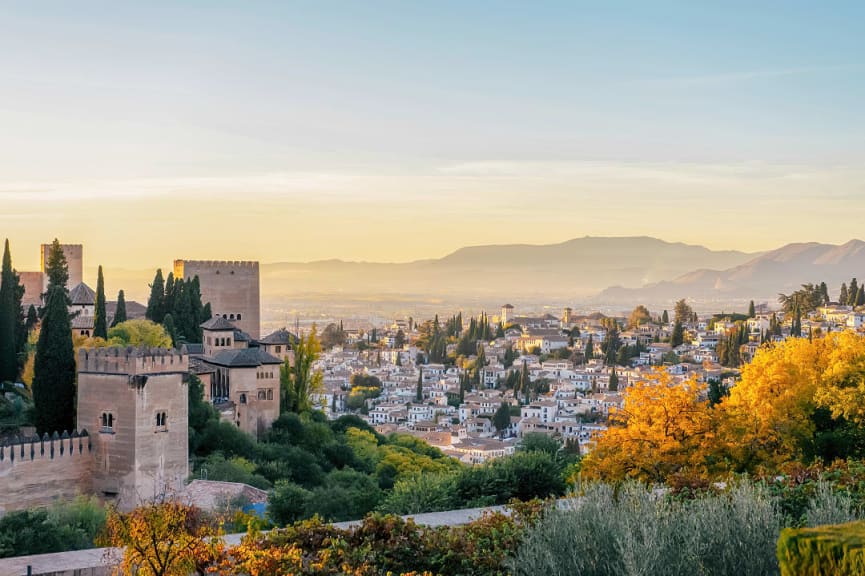
The Alhambra palace in Granada, Spain
Spain is located in western Europe, occupying the majority of the Iberian Peninsula. The borders stretch from France and the Pyrenees Mountains in the east to Portugal in the west, and the Strait of Gibraltar in the south.
Touching the Atlantic Ocean and the Mediterranean Sea, Spain’s proximity to the water has shaped its history, culture, and weather, as well as providing it with a unique identity amidst the Mediterranean Basin. Sun-kissed beaches, Moorish influence, and Catholic traditions all combine to create a captivating blend of heritage and natural beauty.
Expert Tips for Discerning Travelers
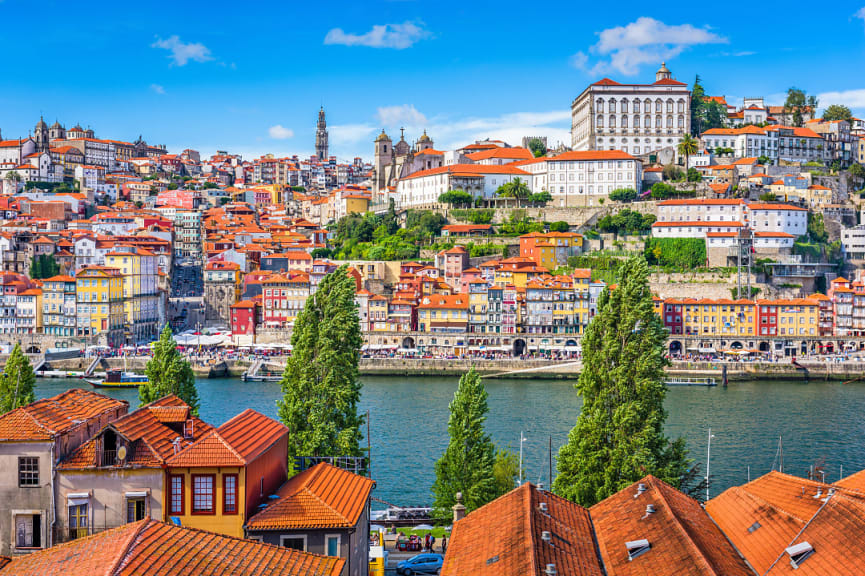
Porto old town in Portugal
Portugal is located on the western edge of the Iberian Peninsula. Bordering Spain to the east and north, and the Atlantic Ocean to the west and south, the country represents the most southwestern corner of the greater European continent.
Picturesque beaches, charming historical fishing villages, dramatic coastlines, historical cities, and storybook castles demonstrate the vibrant natural and civil history influenced by the edging waters. From the medieval charms of Lisbon’s streets to the richness of historic vineyards, natural splendor to fascinating heritage, Portugal has shared history and borders with Spain, but maintains its independent culture.
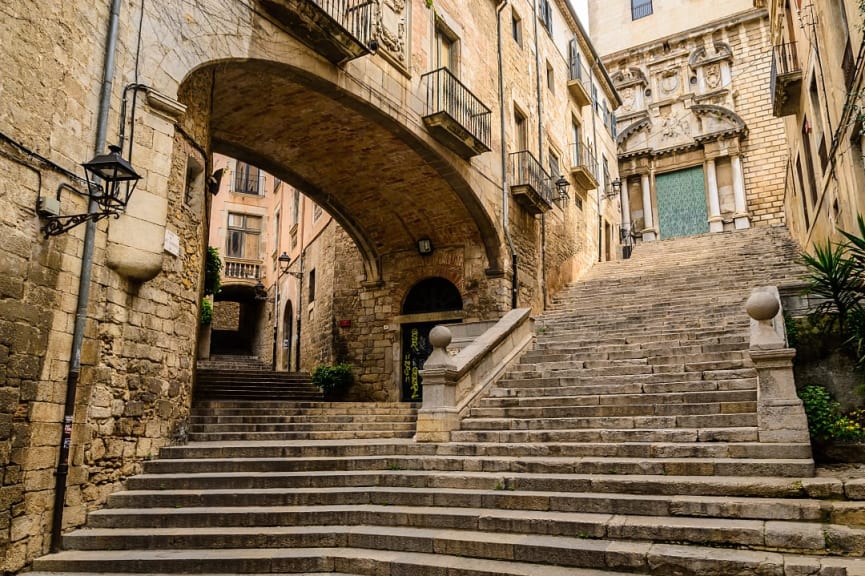
Medieval street in Girona old town, Spain
Spain and Portugal are neighboring countries on the Iberian Peninsula that share several cultural and historical similarities. Both have vibrant Mediterranean heritages, evident in shared traditions, from Catholicism to seafaring.
Because of their southwestern positions on the European continent, the weather around southern Portugal and Spain is similar, as well as that between northern Spain and Portugal. Certain areas in both countries also have ancient Roman foundations and Moorish influences.
There are shared ingredients and traditional dishes across the Spain and Portugal borders, and while both countries have famous wines, the ultimate flavors of the cuisine and wines are specific to certain regions in each country. The end result is that while Spain and Portugal are neighbors, they have fewer things in common than most travelers realize.
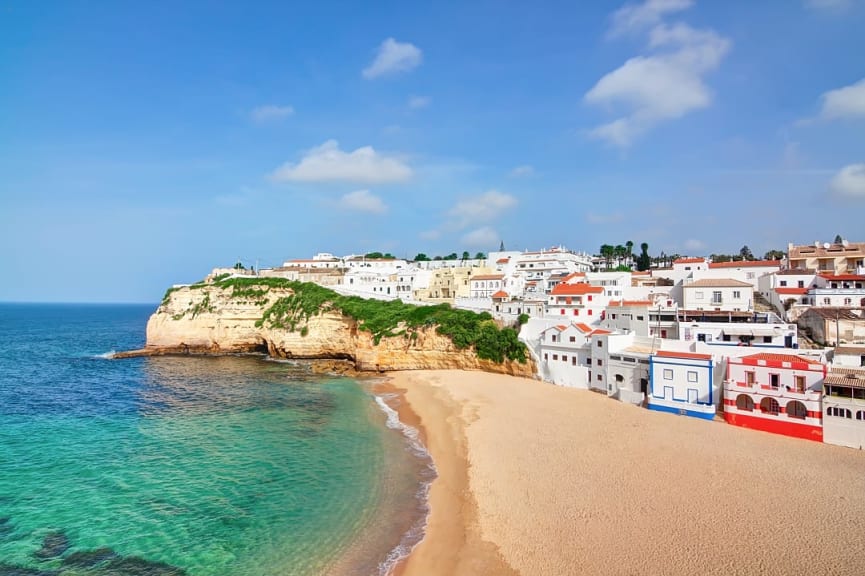
Carvoeiro town in Algarve Portugal
Spain and Portugal shine in their respective differences by exhibiting unique cultural, culinary, and ancestral identities. The most noticeable difference is linguistic, with Spanish acting as Spain’s national language and Portuguese representing Portugal’s.
Spain's architectural legacy ranges from the Moorish-influenced grandeur of the Alhambra Palace in Granada to the whimsical curves of Gaudí's Sagrada Familia in Barcelona, demonstrating a specific aesthetic evolution in art and design.
Portugal's architectural heritage is evident in the Manueline-style of Jerónimos Monastery in Belém, which stands as a testament to its maritime prowess. The charming whitewashed villages of the Algarve also reflect the region’s and the country’s coastal charm.
From flamenco in Spain to fado in Portugal, Spanish artists like Velázquez and Goya to the Portuguese azulejo tiles, the diverse histories, heritages, and cultures reveal the many differences between the countries.
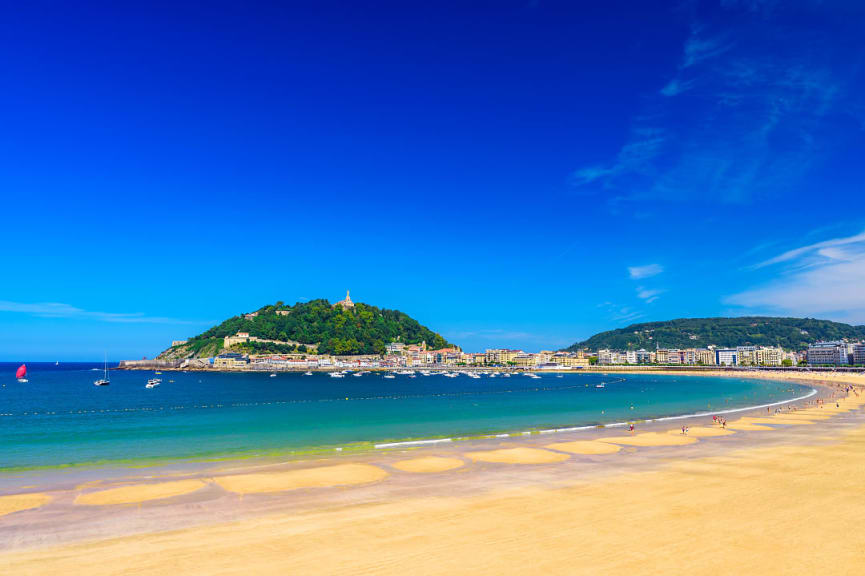
La Concha beach in San Sebastian, Spain
When considering beach vacations, it’s important to note that both Spain and Portugal have stunning beaches. Each country’s coastline has its own unique appeal and your preferred beach in Spain or Portugal depends on your travel goals and interests.
Spain has nearly 3,000 miles of coastline, with a wide array of beaches, from stretches of white sand to smooth pebbles, rocky coves, and corners bordered by greenery. The beaches are famous for their warm waters, which make them ideal for swimming, sunbathing, and watersports.
Portugal's beaches are popular for their pristine beauty, with many hidden coves and unspoiled stretches of sand. The coastline covers nearly 1,115 miles when accounting for the mainland, the Azores archipelago, and Madeira Island. Along with the illustrious gold-sand beaches and crystal-clear waters, Portugal’s coastline is also a haven for surfers because of the consistent waves and variety of breaks.
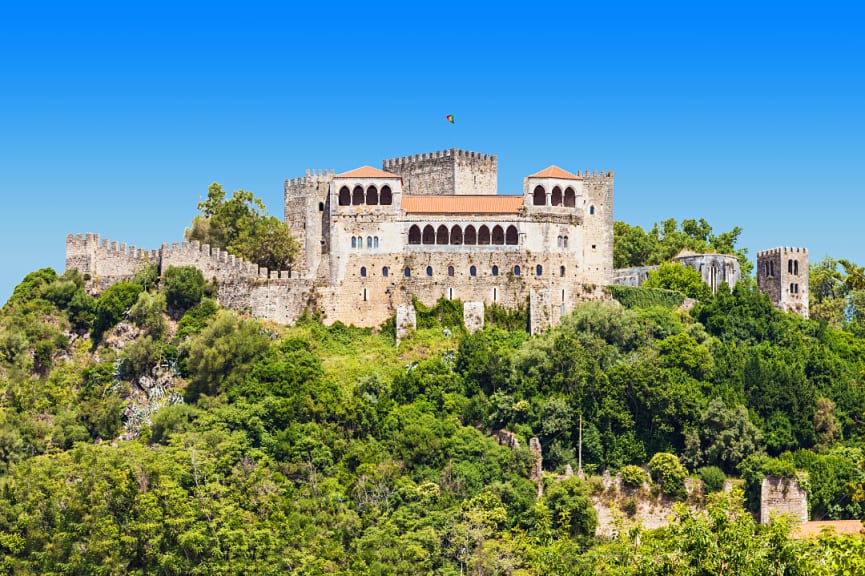
Castle of Leiria in Portugal
The top things to do in Spain include visiting ancient sites, sampling the variety of flavors, and tasting the eclectic wines. The number of activities you can enjoy when visiting Spain can take you cycling through the countryside or learning how to prepare traditional dishes. From admiring master artists in world-famous museums to viewing surreal architecture, the way you experience Spain is specific to your interests and sets the country apart from neighboring Portugal.
The top things to do in Portugal represent the diverse natural and cultural charms of the small country. From visiting remarkable Roman or Moorish ruins to exploring castles that inspired fairy tales, uncovering celebrated vines in historic vineyards to exploring trails connecting dramatic coastal cliffs with winding valley panoramas, Portugal is a singular experience that quickly sets itself apart from its neighbor.

Freshly made seafood paella in Spain
Spain and Portugal have rich, celebrated, and mouthwatering culinary traditions, but deciding on which food is better depends on your preferred flavors and ingredients. Comparing the culinary landscape in Spain and Portugal is about what dishes each country is known for, what spices are typical, or what ingredients are traditionally used.
Spanish cuisine is renowned for its regional diversity, with each region boasting its own signature dishes and flavors, such as the world-renowned food culture in San . Portuguese cuisine, while influenced by Mediterranean flavors, often emphasizes seafood and simple preparation.
Knowing the most popular dishes in each country and their specific region may help you choose which to visit when deciding on Spain vs Portugal for your trip.
The most popular foods in Spain include:
- Paella - rice with saffron, chicken, and seafood
- Gazpacho - chilled tomato soup
- Jamón Ibérico - cured ham
The most popular foods in Portugal include:
- Francesinha - a sandwich filled with meat, sausage, cheese, and a tomato-beer sauce
- Pastel de Nata - flaky pastry filled with custard
- Arroz de Pato - duck and rice
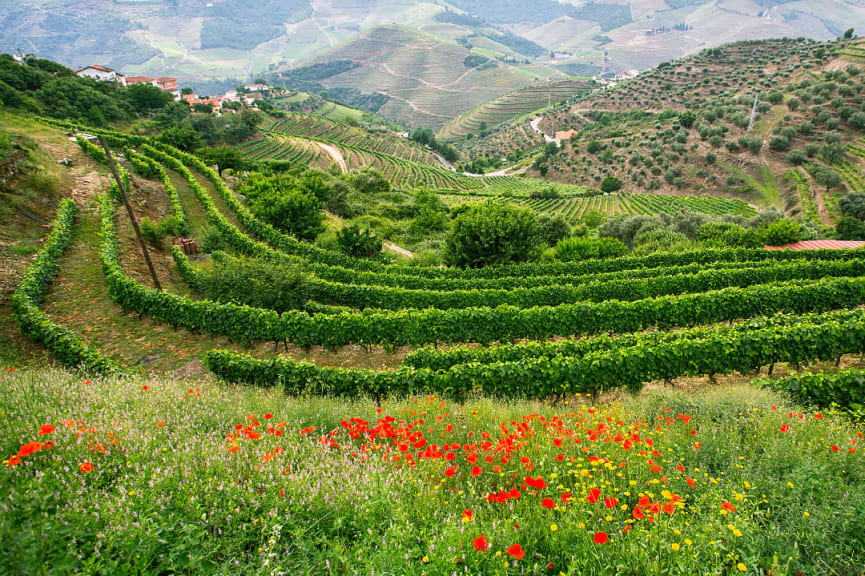
Vineyards in the Douro Valley in Portugal
Spain and Portugal are known for their exceptional wines. Each type has its own unique style, shaped by the grape, the region, and the terroir. Deciding which country is the better wine destination depends on your personal preferences and the type of wine you enjoy drinking or wish to try during your trip to the Iberian Peninsula.
Spain is a global leader in wine production, with the best wine regions representing a diverse range of styles. From the powerful red wines of Rioja and Ribera del Duero to the crisp whites of Galicia and the refreshing rosés of Catalonia, Spain has something for every palate.
The best wine regions in Portugal also demonstrate the country’s major contribution to wine production, with a focus on creating balanced and elegant vintages. From the rich and intense red wines of Douro to the lively whites of Minho and the slightly sweet dessert wines of Madeira, Portugal offers a variety for you to discover.
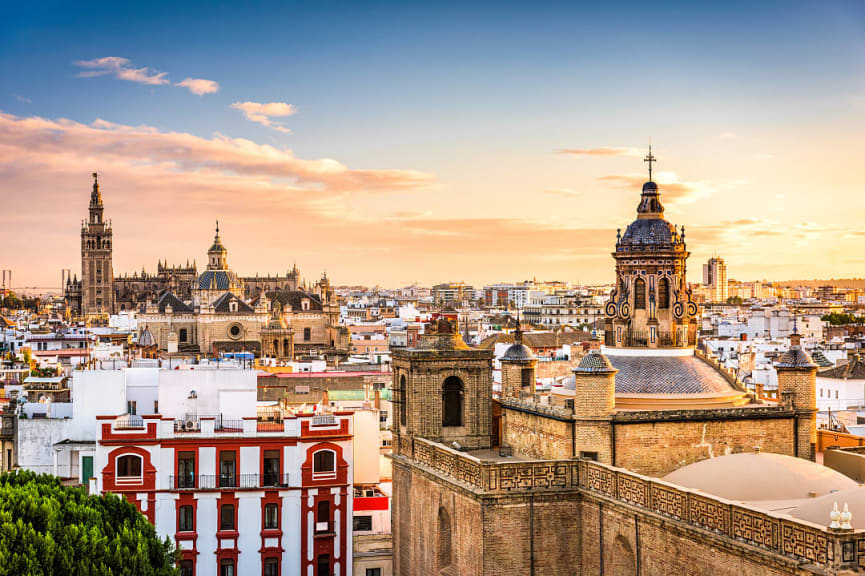
Seville skyline in the old quarter, Spain
When thinking about traveling to Spain or Portugal, how to reach the country can be a major consideration in your decision. Traveling from major North American cities to either country is relatively easy and straightforward, with both offering a wide range of direct flights.
Spain has a slightly larger number of direct flights from North America and major US cities, making it easier to travel without requiring a connection. Portugal is well-connected to Europe and many North American cities, providing for easy flights and quick flight times, but often requiring a stop when traveling from the west coast.
Flight times to Spain and Portugal from North America are typically around eight to 12 hours, depending on your departure city, airline, and number of stops.
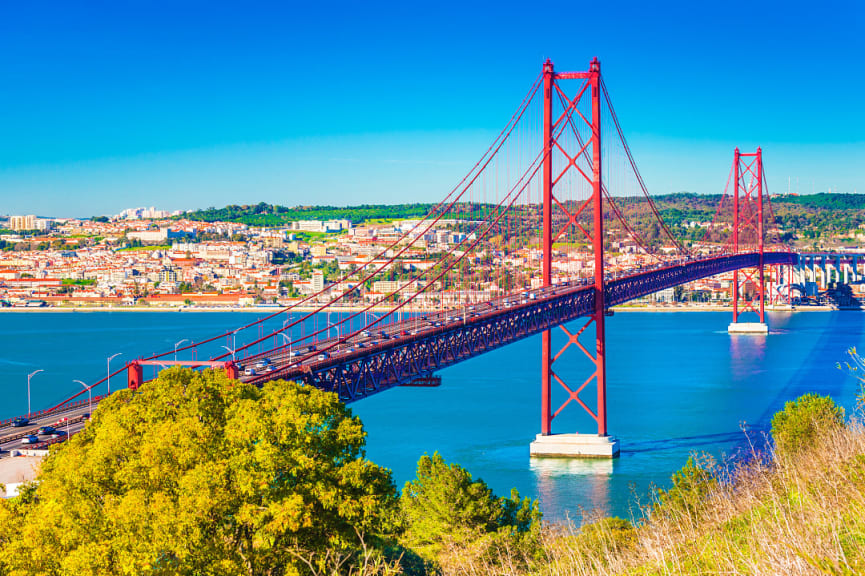
The 25th April bridge in Lisbon, Portugal
When thinking about your Spain vs Portugal vacation, Portugal is considered safer than Spain.
Both countries have low crime rates and travelers are generally safe walking around at night, exploring the coastlines, and even driving through the scenic countryside. Portugal, however, holds a slight edge in terms of overall safety.
Despite these minor differences, both countries have implemented measures to enhance traveler safety. These initiatives include focusing on tourist infrastructure, supporting local safety measures, and streamlining information for access to essential services.
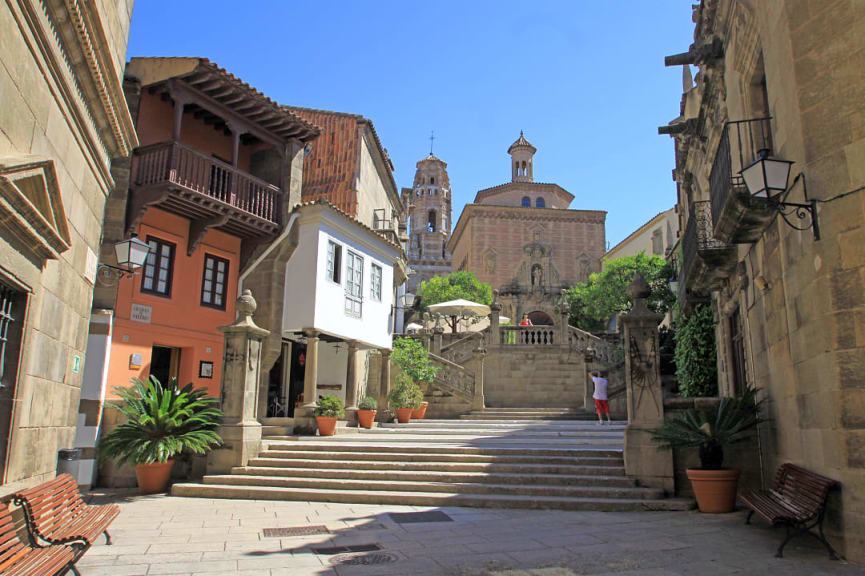
Poble Espanyol in Barcelona, Spain
Rather than visiting Spain or Portugal, you can visit both during your trip. Whether you are interested in a 10-, 14-, or 21-day trip , you can tour the best of both countries for an unforgettable experience in history, culture, and natural splendor. If you have limited time, we recommend no fewer than 10 days for a Spain and Portugal vacation. The more time you have, the more immersive your experience will be.

Penyal d'Ifac Natural Park in Valencia, Spain
- Diverse historical culture
- Culinary discoveries
- World-renowned art and architecture
- Coastal diversity
- Outdoor adventures
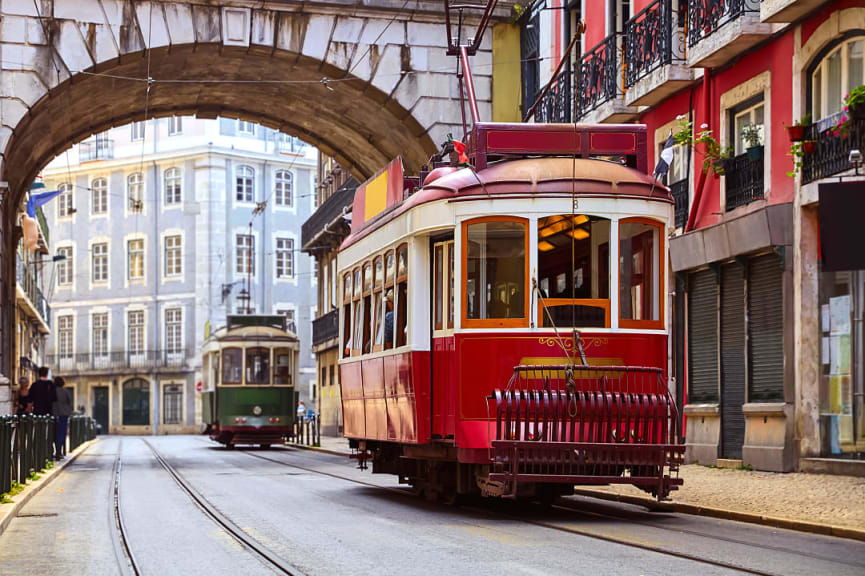
Trams in the Alfama district of Lisbon in Portugal
- Fewer crowds
- Culinary delicacies
- Architectural and artistic beauty
- Unique wine adventures
- Pristine coastal experiences
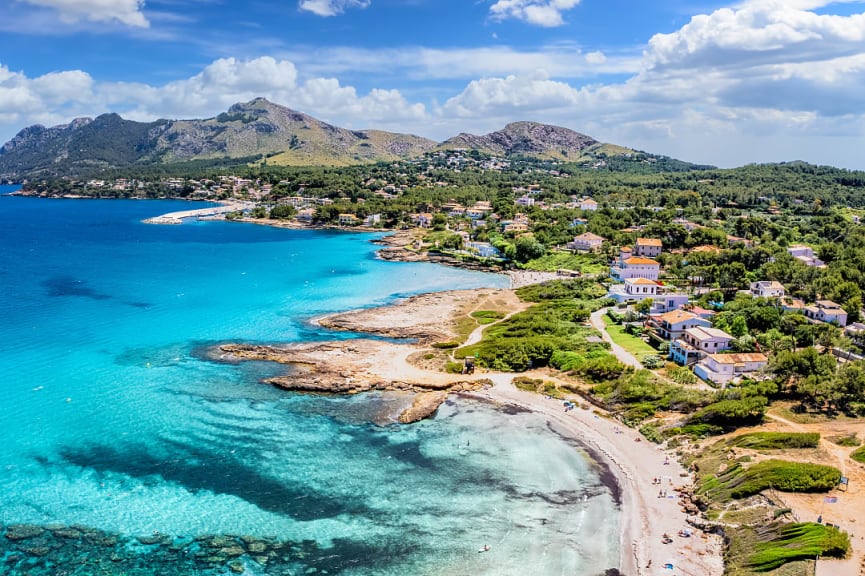
Alcúdia town in Mallorca, Spain
Whether drawn to the cultural tapestry of Spain or the tranquil charm of Portugal, each country offers a unique blend of experiences that can be tailored to your diverse interests. From enthralling architectural marvels and culinary adventures to soulful melodies and blissful coastlines, Spain and Portugal present a wealth of opportunities to discover and create lasting memories.
You can find more information for planning your custom-tailored trip with inspiration from our Spain tours and vacations and our diverse Portugal tours and vacations . For ideas on what to do, see, and more, explore our Spain travel guide and Portugal travel guide .
Life-Enriching Travel Designed Just for You
Trips curated by the world’s top destination experts
Concierge-level service leading up to and during your trip
Unique, exclusive experiences and insider access
Help Me Plan My Trip
Get Top Travel Specialists to Help Plan Your Trip


Spain or Portugal: Which Makes for the Ultimate Vacation Spot? (2024)

Many who are planning to visit the Southwestern part of Europe consider both Spain and Portugal for their holiday. This is an understandable debate, as they are close neighbors and share fundamental similarities. The two countries share the same temperate weather, much of the cuisine is similar, the language shares some key phrases, and their histories are often interwoven. Both countries boast long coastlines, many beachside towns, and laid-back vibes.
However, Spain and Portugal are very different in some crucial ways. Let’s discuss the significant differences and help you determine if you should go to Spain or Portugal for your next holiday.
Which Makes for the Ultimate Vacation Spot?
1. price: which is cheaper, spain or portugal.
Cost is one of the biggest factors to consider when deciding on a travel destination. Nothing ruins a vacation like draining your savings account just to have a good time. So which is more expensive, Spain or Portugal? According to the cost of living calculation and comparison site Numbeo , Spain is generally more costly.
Consumer prices are 9.1% higher in Spain than in Portugal, and restaurant prices are 23.9% higher in Spain than in Portugal. Groceries will also run you an extra 11.9% in Spain versus Portugal.
Pretty much the only significant exception for the average tourist is housing. Housing in Portugal is, on average, 5% more expensive than in Spain. According to Airbnb, the average price per night in Portugal is $180, and the average price per night in Spain is $168 for the same travel date. However, the average tourist will spend more in Spain than in Portugal overall.
Spain or Portugal according to price: Portugal is cheaper than Spain, and tourists will likely save a good bit of money on food, activities, transportation, and more during their Portuguese vacation.

2. Activities: Does Spain or Portugal Have More To Do?
This one seems obvious, but it has to be mentioned that Spain is considerably larger than Portugal. In fact, Spain is over five times bigger than Portugal by size. Spain has 47 million residents, and Portugal is hovering at around 10 million.
Spain also has a much larger tourism industry. Spain has one of the world’s highest numbers of international tourists annually, with about 83 million people visiting the country every year.
While the size of a country does not necessarily determine how rich and exciting the activities are, it has to be stated that Spain has a much more developed tourism industry than its tiny neighbor.
Generally, Spain is ideal for those looking for nightlife, variety of food, historical activities, and beach resorts. Portugal is suitable for those who want to explore the outdoors, try their hand at surfing, and enjoy some fresh seafood.
Spain or Portugal based on the diversity of activities: Obviously, neither country is better nor worse; it just comes down to personal preference and style of travel. But as far as tourist attractions, big cities, and a wealth of opportunities, we have to give this one to Spain.

3. Food: Who Has Better Grub, Portugal or Spain?
Spain is a foodie dream with tons of variety and unique regional dishes for tourists to enjoy. Tapas are popular, and seafood is heavily featured in the cuisine thanks to the abundant coastline. Some popular favorites are the world-famous paella, gazpacho, pisto stew, Spanish omelets, and delicious fried churros.
Portugal is also the home of some incredible and iconic dishes and flavor palates. Seafood is a prevalent staple in Portuguese food, similar to Spain. There are also some iconic Portuguese wines. And you simply cannot leave Portugal without trying the national treasure: the custard tart pastel de nata.
Our Global Foodie Index rankings include the following:
- #19th – Barcelona, Spain
- #27th – Madrid, Spain
- #41st – Valencia, Spain
- #58th – Porto, Portugal
- #66th – Granada, Spain
- #84th – Seville, Spain
- #89th – Santiago de Compostela, Spain
- #117th – Cordoba, Spain
- #122 – Bilbao, Spain
- #130 – San Sebastian, Spain
- #138 – Santander, Spain
Portugal or Spain for food: It’s hard to compare; whether the cuisine is better is another incredibly subjective metric. But if you look at the sheer volume of foodie hotspots and the variety around the country, Spain takes the prize for the best food.

4. Is Spain or Portugal Safer for Tourists?
The best food and the most exciting activities don’t really mean much if you can’t enjoy your vacation because you aren’t feeling particularly safe. So, which country is safer?
In the annual Global Peace Index released by Visions of Humanity, Inc. , in 2022, Portugal ranked #6th in the world for the most peaceful country, whereas Spain ranked far below at #29th. There are some theories as to why Portugal is considered safer than Spain, but much of that comes down to sheer size. As previously mentioned, Spain is five times bigger than Portugal and has far more large cities, and large cities tend to host the lion’s share of criminal activity. However, there are other factors to consider, like economic inequality and police presence.
If you are part of the LGBTQ+ community, Portugal is going to be slightly safer, according to our annual LGBTQ+ Travel Safety Index . Portugal ranked sixth globally for safety, while Spain ranked seventh. Both countries have significant protections and are widely recognized as good places for gay, lesbian, bisexual, transgender, and queer travelers and locals alike.

Both Spain and Portugal are amazing vacation destinations with tons of delicious food, fantastic cultural and historical activities, gorgeous beaches, and some of the nicest people. If you’re looking for a laid-back, decently inexpensive, and relaxing holiday, you could go to either destination and have a wonderful experience. Whether you prefer Spain or Portugal is a personal preference, and each country has much to offer.
Portugal is slightly better regarding safety and price, whereas Spain offers more big city amenities and foodie-friendly destinations. Portugal is ideal for the nature lover and those who enjoy a less touristy vibe, but Spain is good for the beach resort aficionado or the museum buff. Whichever country you choose, we hope you have an amazing time!

Asher Fergusson
Leave a comment cancel reply.
Your email address will not be published. Required fields are marked *
Save my name, email, and website in this browser for the next time I comment.
Portugal vs Spain: Which Country Is Better For Expats?
Portugal or Spain? If you’re deciding between these countries, it’s vital to weigh up the pros and cons of each. Our insight helps you to make a choice.

Reduce Your Health Insurance Costs Abroad
Find the best rates available by comparing quotes from the leading health insurance providers
Is it the ‘Portugal or Spain’ dilemma you are facing?
It may be a difficult choice if no prompts are coming from your heart. Culturally and climate-wise, the countries are almost equally rich and attractive. So let’s weigh up the pros and cons of each to help you make a decision.
Cost of living
Living in Portugal will cost less, as Portugal is more affordable than life in Spain . Be it accommodation, food, drinks, or traveling, you will find Portugal remarkably affordable on the whole.
For example, the average rent in Madrid for a 1-bedroom apartment in the center is around €1,000.
In comparison, in Lisbon , the average rent for a one-bedroom apartment in the city center is around €800 per month. In Porto – around €650 per month.
Travel links
Spain is more accessible from other European destinations than Portugal. Also, it’s easier to travel from Spain all over Europe compared to Portugal.
However, traveling all over Portugal is much easier due to its size, and the in-country connectivity there is more efficient.
Cultural diversity
Portugal is more homogeneous than Spain. Spain’s a mix and match of different nationalities and thus is more diverse and exciting.
This can be great if you enjoy experiencing different cultures and meeting people from all over the world.
State healthcare in Portugal comes with a moderate surcharge. In Spain, state healthcare is free at the point of use. This is an essential consideration if you rely on state healthcare.
If you prefer a private option, private healthcare providers in both countries offer a range of services, including consultations, surgeries, and diagnostic tests.
The cost of private healthcare in Portugal is generally lower than in Spain, with consultations costing around €50-€100, while visiting a doctor in Spain can cost approximately €70-€150
Health insurance in Portugal can be between €40 and €100 per month, depending on factors like age and pre-existing conditions. In Spain, it is between $50 to $200 per month.
However, obtaining private insurance if you are 65 and older is problematic in both countries. In this case, international health insurance might be your only option.
These guides will help you compare your healthcare options in both countries: Living In Portugal (Healthcare section) and Healthcare In Spain .
In Portugal, movies and television programs have English subtitles. In Spain, everything is dubbed. This can be a major advantage if you don’t speak the local language fluently.
Language barrier
You might find it a bit easier to live in Portugal with little Portuguese than in Spain with little Spanish, excluding popular expat locations. This is another important consideration if you are not fluent in the local language.
Visas and residency for retirees and passive income earners
Let’s speak about residency. Both countries have a special type of visa/residence for foreign retirees and passive income earners: D7 in Portugal and a Non-Lucrative visa in Spain.
The financial requirements for the D7 visa in Portugal and the Spanish Non-Lucrative visa differ.
For the D7 visa in Portugal, the minimum amount required is currently €7,980 per year for the main applicant, plus an additional €3,990 per year for each dependent. This can be in the form of income, savings, or a combination of both.
For the Non-Lucrative visa in Spain, the minimum amount required is currently €27,115 per year for the main applicant, plus an additional €6,778 per year for each dependent. This can also be in the form of income, savings, or a combination of both.
Golden visa programs
It is possible to obtain a Golden Visa in Portugal by investing a minimum of €500,000 in businesses, R&D, and arts in Portugal. No real estate option can qualify you for a Golden Visa.
The golden visa program in Spain requires a minimum investment of €500,000.
You can learn more about various European Golden Visa programs in our guide, Which European Golden Visa Schemes Are Best By Value .
Expats in both countries are required to pay taxes on their worldwide income. The Non-Habitual Residence Regime in Portugal, under which you pay a flat rate of 10% for the first ten years of living in the country, is not available any longer. So, expat retirees in both countries pay taxes according to the income tax rates.
You can compare the tax rates in both countries in our guides, Taxes In Spain and Taxes In Portugal .
Our guide on Retiring to Portugal is a great place to research your possible retirement options.
Other than these differences, there is little to choose between the two countries. Both offer a high quality of life, great weather, and a relaxed lifestyle. If you’re still unsure, it might be worth trying to live in both for some time and decide which suits you best.
For more information, read our Living In Spain and Living In Portugal guides.

Ola Degteva
Ola is a Content and Research Director at Expatra. Coming from a teaching and research background, she has been working in online publishing since 2010 when she became an expat. Having done 3 major international moves herself, Ola knows exactly what relocation and settling down in a new country involves and how important it is to plan ahead to make moving abroad less stressful.
Comments and Questions
Leave your comments or questions (cancel reply).

Spain Vs. Portugal (Why We Rate One of Them Supreme)
Travel author
Hi there! My name is Joe, and I am a travel writer and blogger with a passion for discovering new places and sharing my experiences with others. From city breaks to epic road trips, I am always on the lookout for my next adventure
As an Amazon Associate, I earn from qualifying purchases
Spain and Portugal are both countries in Southwestern Europe. They border each other. In fact, Spain is Portugal’s only neighboring country.
During my visit to Spain, I also crossed to Portugal and spent a few days. They are both amazing countries to visit.
However, comparatively, I would rate Spain as the supreme country for reasons I will disclose in this article.
Table of Contents
While the two countries are literally next to each other, their ways of life couldn’t be more different.
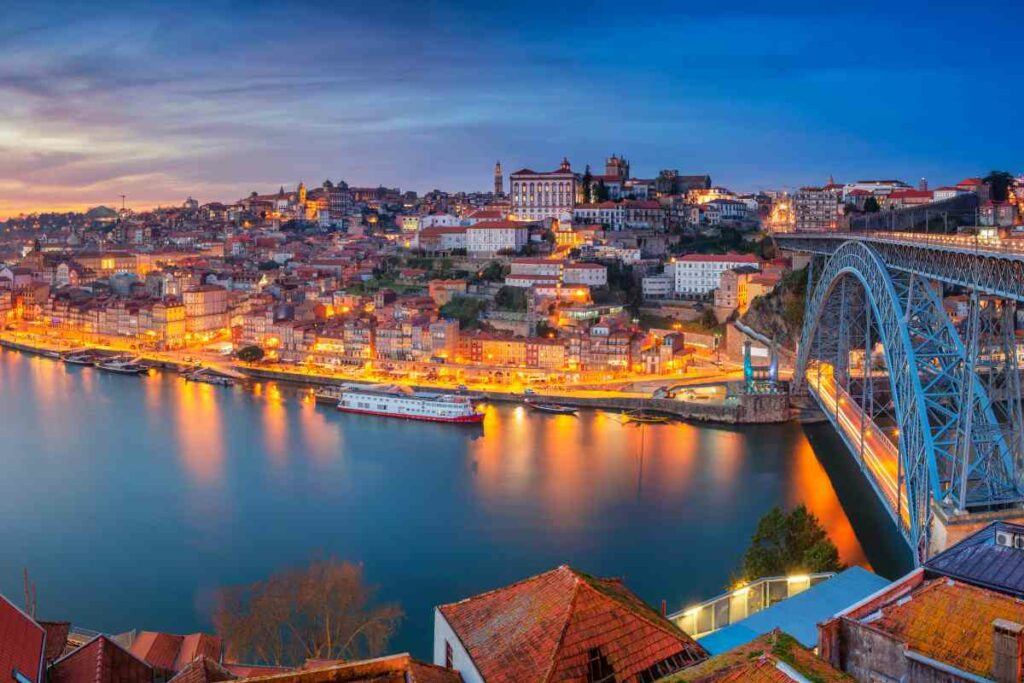
For one, Spain’s culture is not all that homogenous. It depends on the part of Spain you are in. I found that there are variations as you move from Northern Spain to Southern Spain.
Also, Spaniards are comparatively friendlier and more outgoing. The men here greet each other by happily shaking hands. As for women, kissing both cheeks for greetings is the order of the day.
In Spain, kissing is from right to left. Portuguese women also kiss the same way, but from the left cheek to the right one.
The Portuguese are more reserved and a bit more sensitive during interactions. They are also quite formal, and professional titles are a big deal.
For instance, a doctor will be referred to as Mr. Doctor, the same as an engineer.
Spaniards don’t care that much about titles – informality is the order of the day. As a laid-back person myself, I find Spain more easygoing.
One thing that I found intriguing about the Spaniard way of life is how late they have their meals:
- Breakfast is served at 8 a.m.
- lunch at 3 p.m.
- and a light dinner past 10 p.m.
Restaurants do not even open for lunch until late in the afternoon, so you would have to be prepared for that.
Food is a very crucial aspect of traveling. You want to be satiated when exploring a new region. Inherently, part of the exploration includes trying out the new place’s cuisines.
Both Spain and Portugal have tantalizing foods, albeit with different touches and tastes.
Seafood is quite common in both countries, which is no surprise as they are both bordering the Mediterranean. I could argue that seafood is a staple in southern Spain.
Spanish Cuisine
While Tapas might not be the most famous food in Spain, I must say they were my favorite.

They are everywhere, and they taste so good! They are small savory dishes, and there are different types of them.
Tapas are accompanied by almost all foods. My favorite bit is that when you order a drink in most bars, the waiters bring you free tapas to enjoy as you sip away.
Rice is also a common dish in Spain. Paella is particularly delicious and most consumed in Valencia.
You may also like 📖
- The Best Spanish Cities for Families to See the Real Spain
- 5 All-Inclusive Family Resorts for Teens In Spain
- 4 Days in Barcelona Itinerary
It is a rice dish that is cooked in a broth that consists of either chicken or seafood, beans, and saffron.
Other foods that I enjoyed in Spain include:
- Tortilla Espanola
The only concern I have with Spanish food is that there are hardly any veggies during meals, which might explain why weight-related issues are more rampant in Spain than in Portugal.
If you are a fan of red wine, then you will have a superb time in Spain, as the country is known for producing some of the best red wine in the region. Portugal predominantly deals in dry whites.
Portuguese Cuisine

Portuguese food is quite spicy. Black pepper, cinnamon, and peri peri are used in most dishes. If you’re into garlic like me, you are likely to enjoy Portuguese foods.
The most popular food in Portugal is the Bacalhau, which is a type of cod served with potatoes.
Other delicious dishes you will find in Portugal include:
- Cozido a Portuguese
- Francesinha
- Posta Mirandesa
As a coffee person myself, I enjoyed coffee in Portugal more than I did in Spain. It is stronger and easily available.
The average Portuguese person will take 3 to 4 shots of espresso throughout the day. In Spain, coffee is not as revered.
Football/Soccer
Soccer is a big deal in both Spain and Portugal. Both countries have produced some of the greatest footballers in the world.
For instance, Cristiano Ronaldo, who hails from Portugal, is a household name not only in Portugal but worldwide. The Portuguese are particularly fond of him and will never tire of talking about him.
Spain is home to one of the biggest leagues in the football world, La Liga.

There are two major teams in the league- Real Madrid and Barcelona. There is an almost even divide between the two teams in Spain and all over the world.
Being a Barcelona fan myself, I had to visit Camp Nou and watch a game between FC Barcelona and Real Madrid. This was probably one of the most exhilarating games I have ever watched.
Both Portugal and Spain have made it to the World Cup competitions. While Portugal has never won the world cup, Spain has a World Cup Championship in their name. They won the world cup in South Africa in 2010.
European countries are known for their exciting nightlife. I can confidently say that I was not disappointed at all.
The people in these two countries love partying. Madrid, Barcelona, and Lisbon are specifically impressive when it comes to bars and clubs.
That said, I will be a bit biased.
While in Portugal, I never got the opportunity to experience its nightlife there in all its glory fully. The party life starts a little later in Lisbon than in Spanish cities.
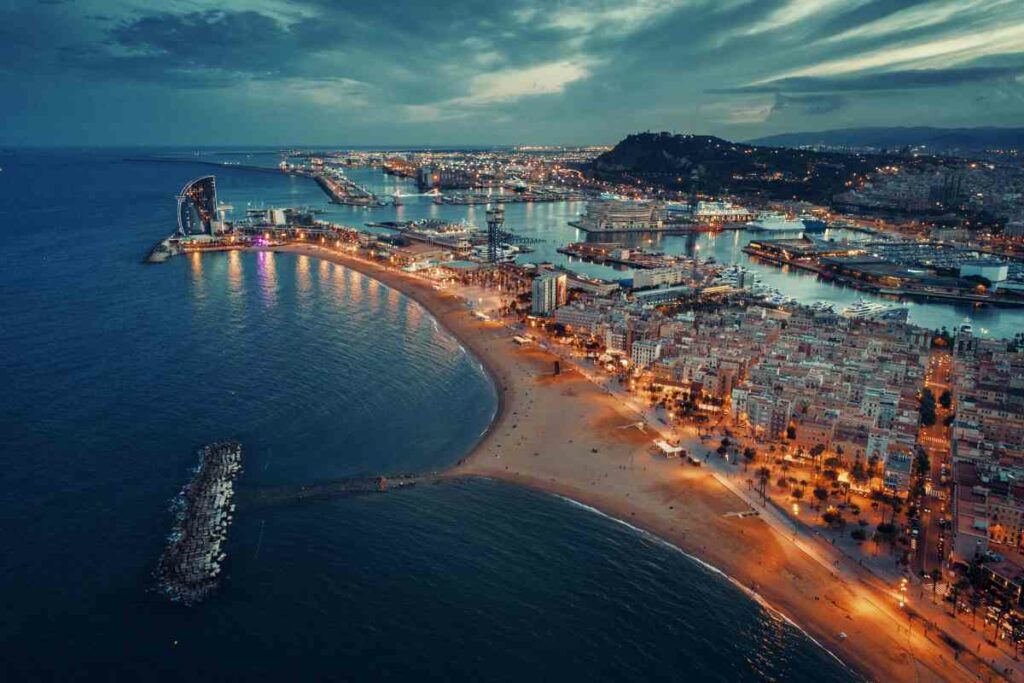
So, if you want to have a good time at the club, it is advisable to get there past midnight. During the weekends, do not go to the club before 2 a.m., or you may get bored.
However, while in Madrid, The Principal club stood out for me. The vibes are immaculate in this rooftop joint. Malaga’s nightlife scene is more sophisticated.
If you want to have wine poured straight from the barrel, go to the Antigua Casa de Guardia, which has been doing this since the 1840s.
Infrastructure
Both Spain and Portugal are quite developed when it comes to infrastructure. However, Spain boasts better and safer roads than Portugal.
I had an easier time driving around Spanish cities than in Portugal. Also, Portugal does not have the shiniest reputation regarding road safety.
There are large train networks in both Spain and Portugal, which, in my opinion, are the most convenient way to get around.
The Spanish AVE Alta Velocidad, specifically, is a high-speed train network that operates in all the major cities in the country.
Take a quick look
- Best Luggage for European Train Travel
Language can be quite a barrier when traveling to non-anglophone countries. As expected, the Spaniards speak Spanish, and the Portuguese speak Portuguese.
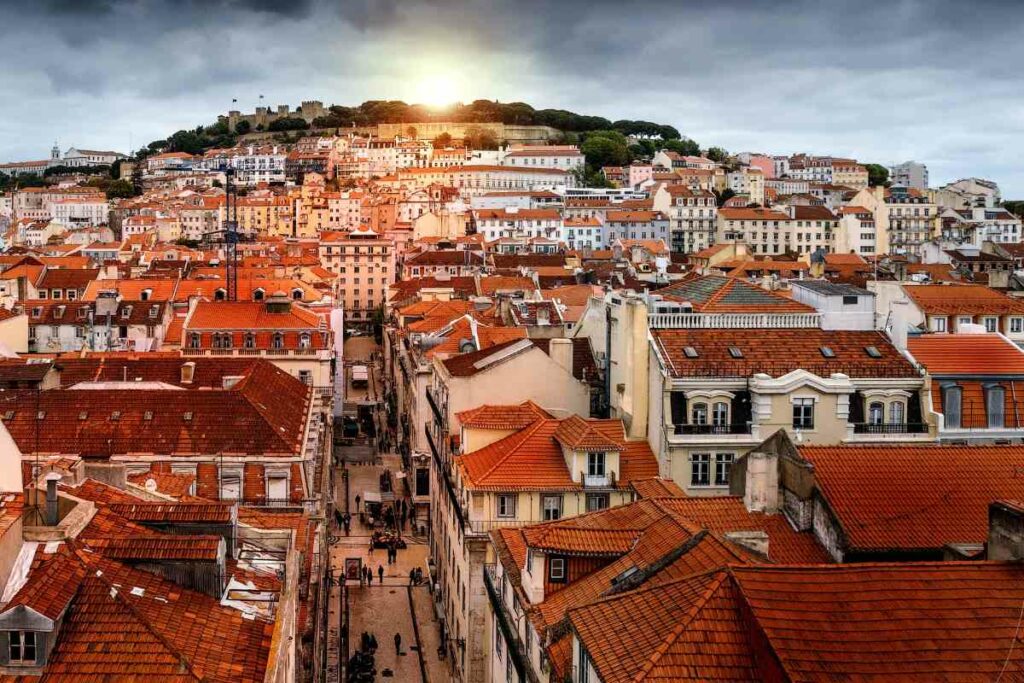
If you are traveling from North America, chances are high that your first language is English. If you are multilingual, lucky for you. Most bilingual and multilingual Americans speak Spanish.
Spanish and Portuguese have somewhat common ancestry; they are both Romantic languages.
However, they are not similar at all. So, if you speak Spanish, it is not a guarantee that you will understand Portuguese.
- The Perfect 4-Day Guide to Lisbon
The two languages share some words, but the meanings are entirely different.
For instance, I learned that the word ‘espanstosa,’ which means ‘dreadful’ in Spanish, actually has a positive meaning in Portuguese.
Note that the dialect of Spanish depends on which part of the country you are in. Thus, there are five dialects:
I found that the Catalan dialect was the closest to general Spanish. Also, Catalonia is the region with the most English speakers.
Comparatively, though, the Portuguese speak better English than the Spaniards. The main reason for this is that in Portugal, shows that are in English tend to have Portuguese subtitles.
So, the people pick up on the accent and intonation. However, in Spain, shows and movies done in English tend to be dubbed into Spanish.
Affordability
Even though Spain has a higher GDP than Portugal, the latter is more affordable, especially for travelers.
For starters, accommodation is cheaper in Portugal than in Spain. Even so, food and drinks in Spain cost less.
Note that while Portugal is more affordable , Spain is not overly expensive. If anything, it is one of the more affordable countries among western European countries.
Both Portugal and Spain are rich in historical and cultural icons.
The countries have existed for centuries and have a long history, so of course, there are plenty of landmarks to show for it.
Some of the amazing landmarks you will run into while in Portugal include:
- The Belem Tower
- Sao Jorge Castle
- The Jeronimos Monastery in Lisbon
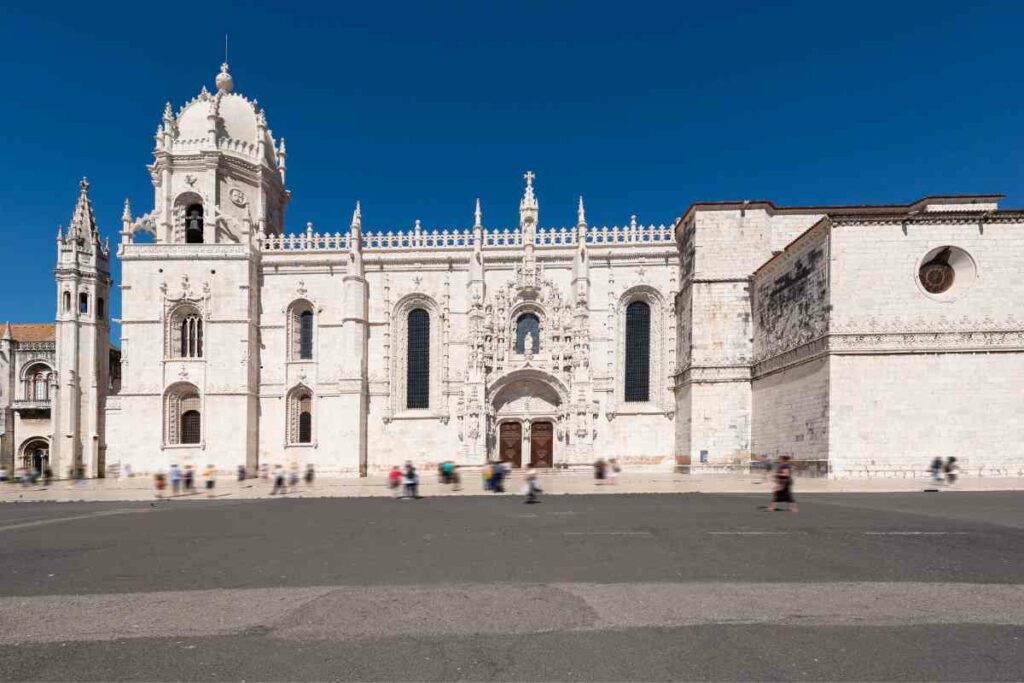
The Romanticist building in Sintra is also quite a beauty to behold. I loved the sight of the Dom Luis Bridge, which stands on the Douro River between Vila Nova de Gaia and Porto.
Spain has some pretty cool landmarks as well. The Aqueduct of Segovia is one of them. It holds the title of being the best-preserved Roman aqueduct in the world.
Other incredible landmarks in Spain include the Moorish city of Cuenca, the Mezquita of Cordoba, and the Alhambra, which was built in 889 AD.
Why Spain Is Better Than Portugal (Personal Opinion)
Both Spain and Portugal are interesting countries to visit. You are guaranteed to have an amazing time.
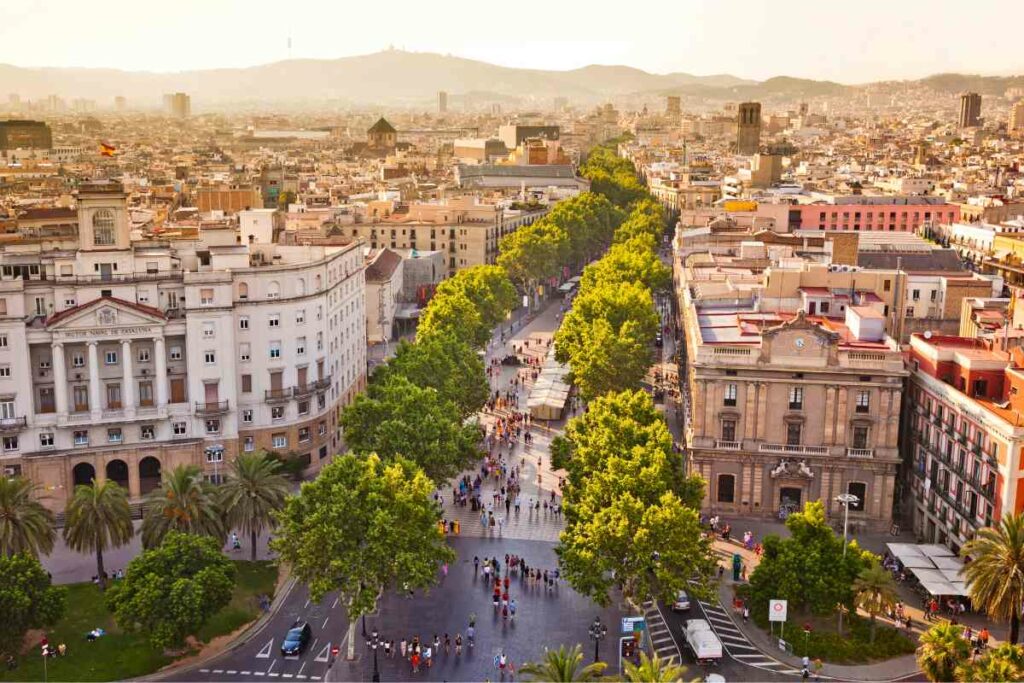
However, personally, I rate Spain as the supreme of the two countries for various reasons.
- First, Spaniards are comparatively friendlier and warmer . While the Portuguese are friendly people, they are quite reserved, and it may be harder to approach them than the Spanish.
- Spain also has better infrastructure . Moving from one place to another is smoother compared to Portugal.
- Also, you get free tapas in Spanish bars and clubs when you order drinks. In Portugal, tapas served are included in the final bill.
- Additionally, Spain has a more successful football heritage . Even though Portugal boasts one of the best footballers in history, Spain has a stronger football culture and a World Cup championship title.
One thing that Portugal has over Spain is affordability. And even then, the difference is not that big, and generally, Spain is one of the more affordable Western European countries.
However, these two countries still have a lot in common. For instance, they both have coastlines on the Mediterranean Sea. As such, their climates are also somewhat similar.
Spain assumes easy superiority over Portugal for various reasons. It is geographically bigger with a more developed economy, health system, and infrastructure. While both countries are interesting tourist destinations, Spain has significantly more to offer, in my opinion.
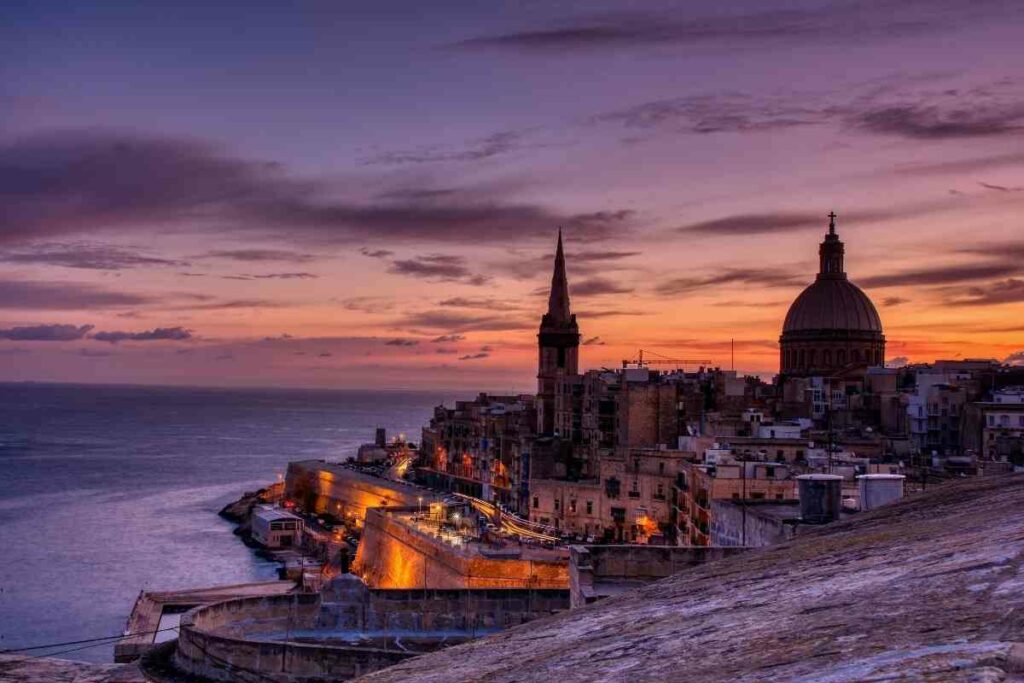
Affiliate Disclaimer
As an affiliate, we may earn a commission from qualifying purchases. We get commissions for purchases made through links on this website from Amazon and other third parties.
Latest posts

Ulanzi U60 RGB Video Light Review: Top Vloggers’ Choice?
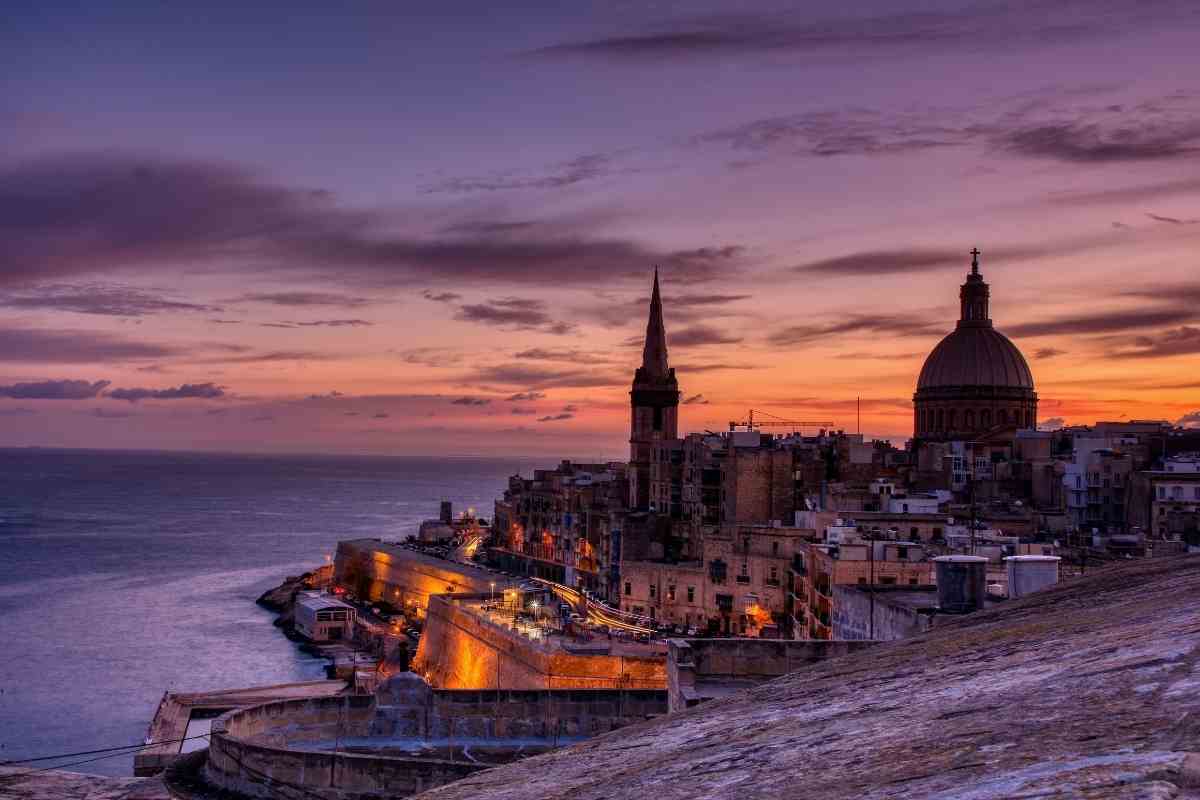
What Is Malta Famous For? Malta Local History and Past Events

Do IndiGo Airlines Provide Headphones? In-Flight Entertainment Explained
- Skip to primary navigation
- Skip to main content
- Skip to primary sidebar

Destinations
Experiences.
- Photography
Plan Your Trip

How to Decide Between Spain and Portugal
October 9, 2023 by Robert Schrader Leave a Comment
After returning from a recent trip to Portugal , I was walking with my father, who has never left North America. “This might be a dumb question,” he began, “but how different could Portugal really be from Spain?”
It wasn’t a dumb question, of course. Spain completely surrounds Portugal, after all, and has for centuries. In the era of the EU, the lack of a real border separating these countries means that they’re more integrated than ever.
At the same time, there are key differences—huge differences—between Spain and Portugal, which I’ll explain in greater detail over the next several paragraphs.
Why Spain and Portugal Get Lumped Together
As I referenced—as my dad referenced—in the introduction to this post, it’s really no wonder that travelers feel twisted in knots when deciding between Portugal or Spain. The two countries get lumped together because they are lumped together, and have been for most of their existences! Even if you neglect the fact that Portugal is effectively an independent “slice” of Spain, you have to consider their intertwined histories.
Then, there’s the linguistic similarities between the two countries—I can’t lie that I often simply speak Spanish in Portugal when I don’t know what to say. Adding in cuisine to the mix ( pesticos are Portugal’s answer to tapas , or perhaps more accurately its answer to Basque -style pintxos ) and…well, it’s even easier to see why you might just throw your hands up while planning an Iberian adventure.
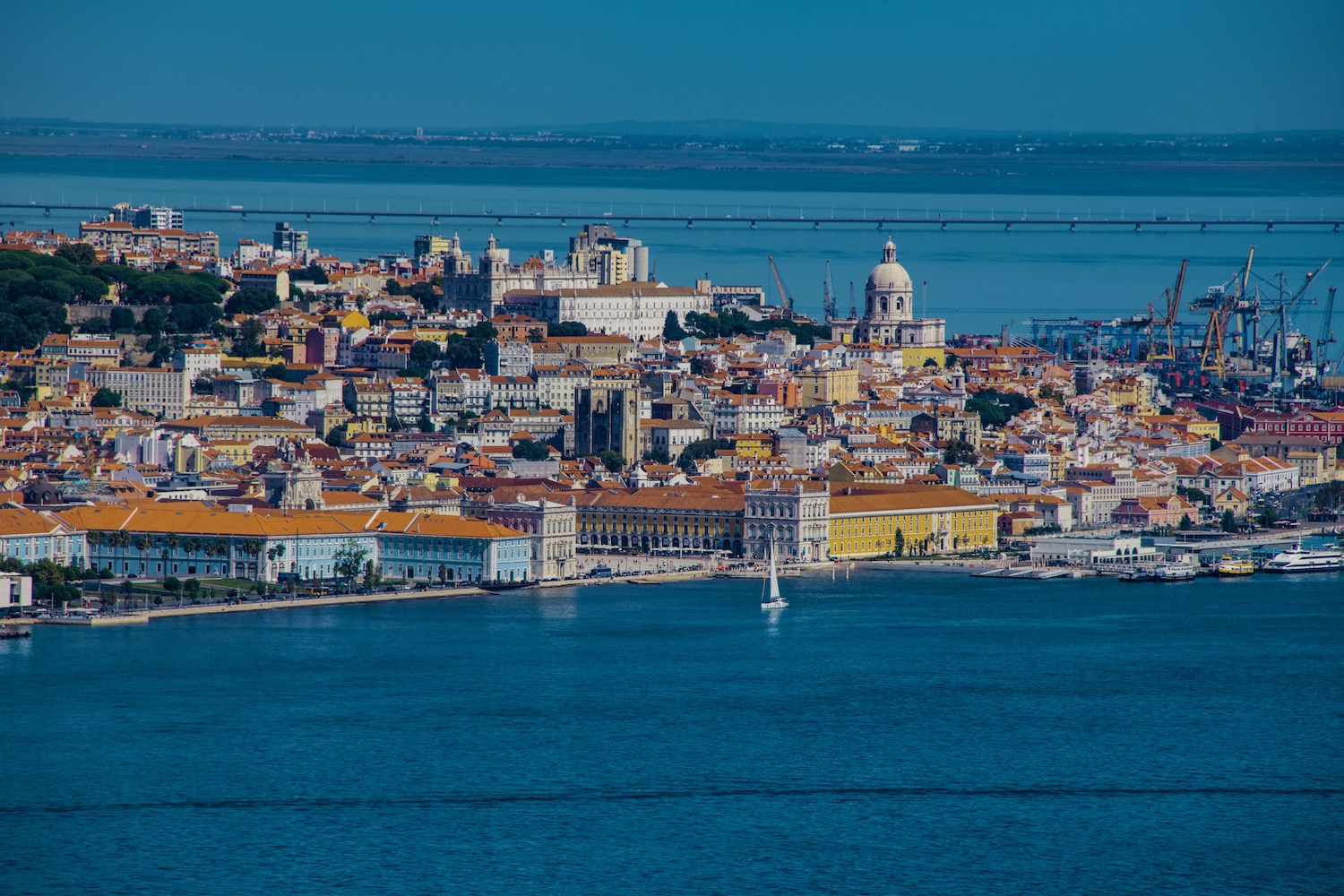
Ways to Compare Spain With Portugal
Spain, not surprisingly, has a wider array of destinations spread across a larger land area. This is compounded by how unique the culture feels in each, especially in autonomous regions like Catalonia and the Basque Country . Portugal, by contrast, has a shorter-list of must-visit destinations ( Lisbon and Porto , plus the Algarve , basically), but all feel somewhat more uniformly Portuguese than places in Spain do Spanish.
Ease of getting around
Another way of comparing Portugal vs Spain is in terms of how easy (or not) it is to explore the country. While Spain’s cities are connected by one of the world’s most extensive high-speed rail networks , getting around Portugal mostly requires much slower trains (albeit across much shorter distances). Anecdotally, I’ve found much more benefit to (and necessity for) renting a car in Portugal than in Spain.
Both Portugal and Spain are much cheaper than most of the rest of Europe, with costs low enough that you can conceivably travel for as little as €100 per person, per day in both countries. I’d say that Spain is probably a bit cheaper these days, simply because so many cities in Spain are still relatively unknown; the years-long “moment” Portugal has been having means that it no longer has much of a beaten path.
Food and drink
I love eating my way through Portugal and Spain on an almost equal basis, although there are some important differences between the country’s foods. Frankly, Portugal doesn’t have a single dish that’s as globally famous as paella or even the tortilla española . Rather, I’d say, the foundation of Portugal’s culinary excellence is more general, centered around fresh and locally-sourced ingredients.
Natural beauty
While it’s difficult to say that Spain is more beautiful than Portugal (or vice-versa), I would say that you can see a greater diversity of landscapes in Portugal, at least compared to its size. When driving from the Algarve up to Lisbon, for example, you go from vermillion beaches, through vast pine forests and finally to the dramatic, Atlantic scenery of the capital, which sits at the mouth of the Tagus River as its spills into the ocean.
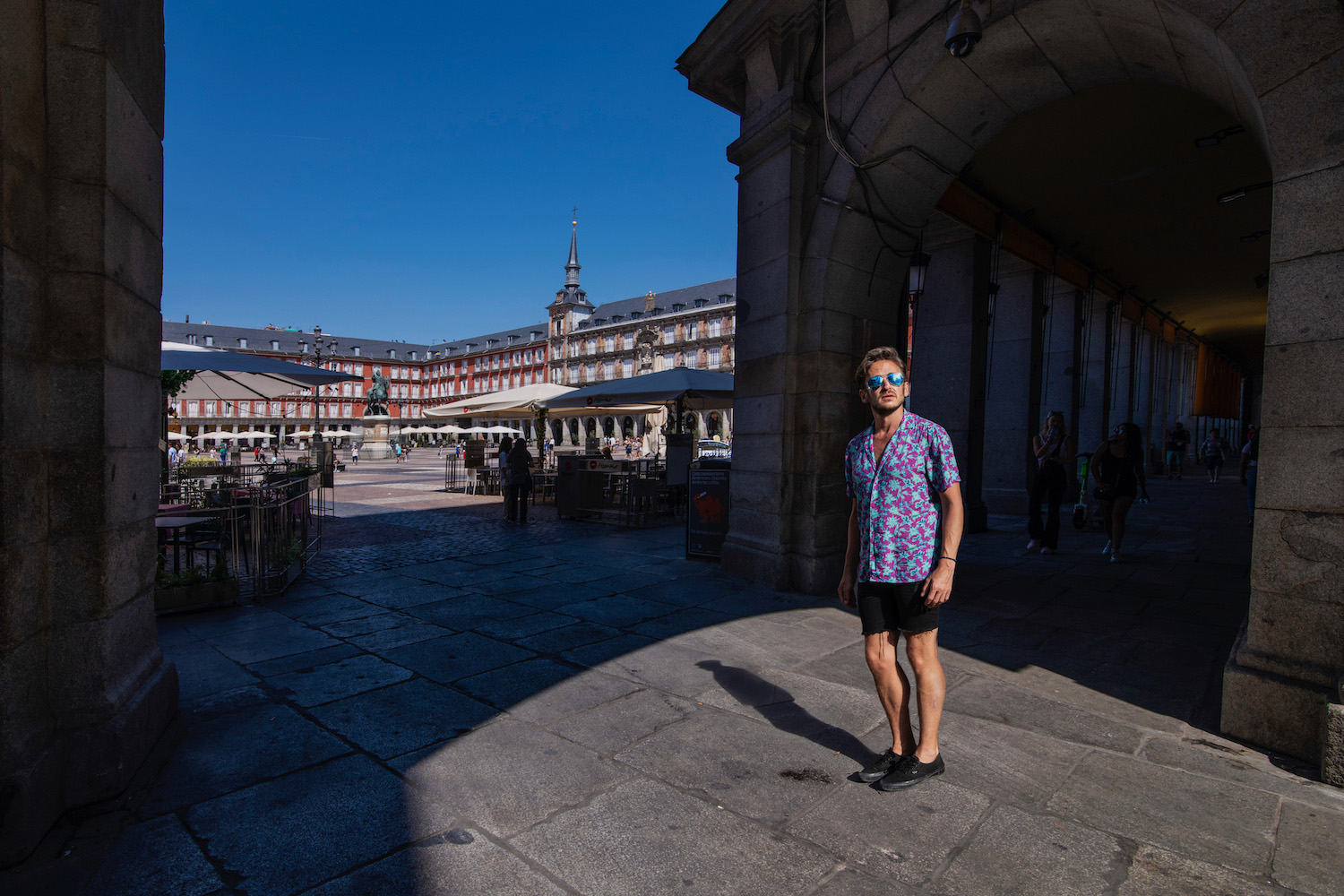
How Long Do You Need in Spain? What About Portugal?
Spain is obviously a much bigger country than Portugal, even factoring in both countries’ outlying islands. As a result, you’ll probably (but not necessarily) need longer in the former than you will in the latter. As a general rule, I recommend spending a minimum of two weeks in Spain, while a shorter trip of 7-10 days tends to get the job done in Portugal.
On the other hand, you could invert this paradigm—Spain, if you cut out most secondary destinations, is possible to enjoy in a week or a week-and-a-half; you can easily protract a shorter Portugal trip into a longer one with more days in each city. Also, keep in mind that whether you visit Spain or Portugal (or both), your first trip to this part of Europe is highly unlikely to be your last.
Other FAQ About Travel to Spain and Portugal
Is it better to travel to portugal or spain.
While Spain is a larger country with language and food that’s more familiar to more travelers, Portugal’s small size makes it easier to take a comprehensive trip with less time and effort. Obviously, I’d recommend that you visit both of these countries if you can, even if that doesn’t happen on the same trip.

Which country has better beaches, Portugal or Spain?
While few beaches in mainland Spain compare to the stark visual beauty of the ones you find in Portugal’s Algarve region, the advantage of hitting the beach in Spain is that so many are convenient to (or even within) large cities like Barcelona , Valencia and Malaga. On the other hand, none of Spain’s beaches really have the same aesthetic as ones on Portugal’s turbulent Atlantic coast.
Should I go to Barcelona or Portugal?
If your choice is between spending time in the city of Barcelona, or being able to explore the country or Portugal, then to me there’s very little up for discussion: Portugal, even if just a few days, is an absolute gold mind for discovery. Barcelona is comfortable and easy, but isn’t very interesting outside the context of the rest of Spain.
The Bottom Line
The Spain vs Portugal is not a new one, but it is an important one. Every time I visit one of these countries, I’m amazed by how different they are from one another, in spite of being literally intertwined, never mind their centuries of shared history. As to which one is a “better” choice for travelers? Well, that’s a complicated question, too. While Spain is larger and has a wider array of destinations and experiences on offer, Portugal punches far above its weight as a very tiny country. One of the best ways to hammer out an amazing Iberian itinerary? Hire me as your Travel Coach!

Subscribe to email updates!
Words, images and design ©2009-2024 Robert Schrader, All rights reserved. Read Privacy Policy or view sitemap .
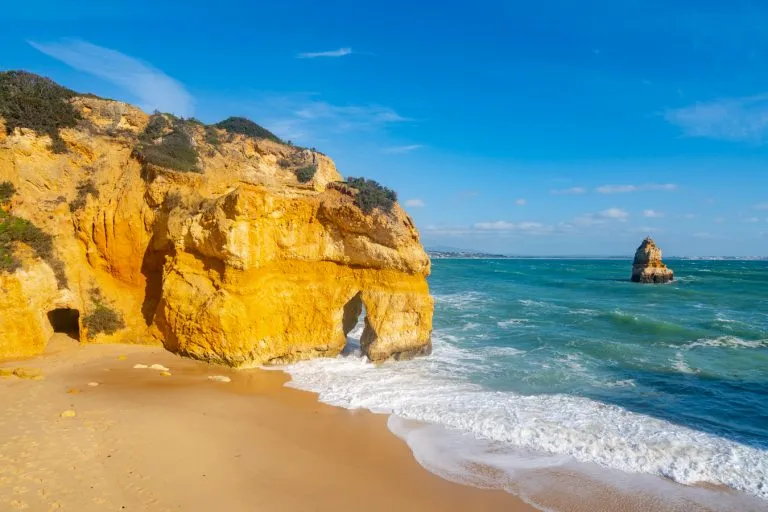
The Perfect 2 Week Spain and Portugal Itinerary (+ Essential Tips!)
Tempted by the cultural charm and natural beauty of the Iberian Peninsula and hoping to plan the perfect 2 week Spain and Portugal itinerary?
If so, we’ve designed this itinerary for Portugal and Spain for you!
Tucked away in the southwest corner of Europe, planning a combined trip to Spain and Portugal over 2 weeks is as invigorating as it is challenging.
After more than a year of living in Lisbon as American ex-pats and more trips to Spain than we can count, we have quite a few opinions about planning the perfect 14 days in Portugal and Spain!
These two countries–both of which feature a list of bucket-list destinations that could take months to see if given the opportunity–are fascinating and engaging places, though with more differences between them than might be immediately apparent on the surface.
If you’re hoping to enjoy a whirlwind, fast-paced, crash-course in what makes traveling in Spain and Portugal special, this itinerary is for you.
Here’s how to make the most of 14 days in Spain and Portugal!
Table of Contents
How We Structured This 2 Week Spain and Portugal Itinerary
Getting around during your 14 days in portugal and spain, the ultimate 2 weeks in spain and portugal itinerary, possible alterations to this 14 day itinerary for spain and portugal, the best time of year to enjoy this portugal and spain itinerary, how to extend your iberian peninsula vacation (+ morocco advice), what to pack for your 2 weeks in portugal and spain, faq about planning a spain and portugal vacation, more portugal and spain travel tips, your 14 day spain and portugal itinerary map.

Some links in this post may be affiliate links. If you make a purchase through one of these links, we may earn a small commission at no extra cost to you. Please see our disclosure policy for more detail.
We structured this 14 day itinerary for Spain and Portugal as a “U” shaped route beginning in Barcelona and ending in Porto.
In addition to those 2 cities, we also cover stops in Seville , Cordoba , Granada, the Algarve, Lisbon , and Sintra .
In other words, this is a very, very fast-paced itinerary!
While very doable, I’ll be perfectly honest: this is a mildly exhausting pace, and if you prefer a more relaxed itinerary, trimming the stop that appeals to you the least is a very reasonable option.
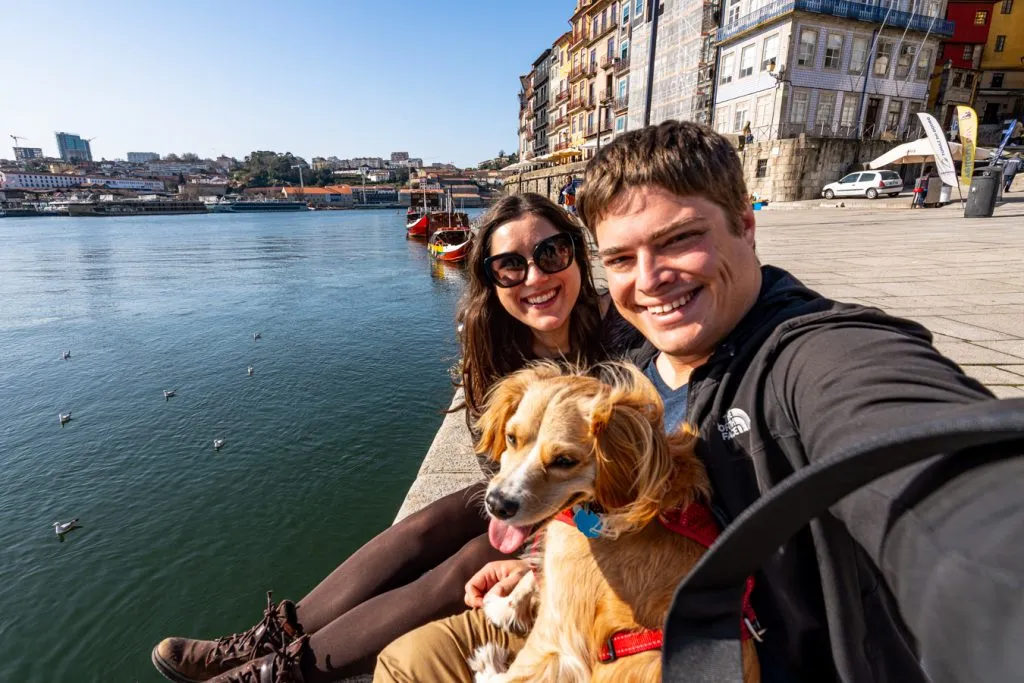
We agonized over what destinations should make the cut (and it took me a long time to come to the conclusion Madrid wasn’t doable on top of everything else, though you could easily swap it for Barcelona or Porto if you prefer), but ultimately, we decided to suggest an ambitious but realistic plan that is as varied as possible.
Major cities, legendary architecture, stunning coastlines, and small towns all feature on this itinerary for Spain and Portugal, and we truly believe that you’ll walk away from this trip with a wonderful snapshot of both destinations.
In order to fit it all in, though, be prepared to lace up your most comfortable shoes, plan your transportation in advance, and squeeze lots of sightseeing into one day!
Oh, and pack as light as you can–trust me, unpacking and re-packing this many times in a row is not a blast.

What About Morocco?
When planning a combined vacation to Spain and Portugal, there’s another country that tends to draw the eye: Morocco, which sits a tantalizingly short ferry trip or plane ride away from the southern edge of the Iberian Peninsula.
We opted not to include Morocco here due to sheer logistics.
The reality is that 14 days is barely enough time to do justice to Spain and Portugal, let alone add on a whole additional country (with a wildly different culture, packing list, and attractions to consider, too).

When you add in the fact that Tangier, the Moroccan port city reachable by ferry from the Iberian Peninsula, isn’t typically the favorite destination of visitors to Morocco, it simply doesn’t make sense to add it to this route.
Now, that being said, Morocco is unforgettable–we still count our time there camping in the Sahara Desert as one of our favorite travel memories of all time.
If you have 3 weeks to work with instead of 2, you might consider adding a Morocco leg onto your trip.
We wouldn’t recommend a day trip, though: about 5 days, enough to see the Sahara Desert overnight as well as Marrakech and/or Fes, is enough to give you a solid taste of the country (though of course, 7-14 days would be even better).
With more time, the Blue City of Chefchaouen and the coastal city of Essaouira offer wonderful experiences.

This itinerary for visiting Spain and Portugal in 2 weeks is best accomplished with a mix of transportation.
Between each Spanish city, the best way to get around is typically via high-speed train, though a flight is an option on one route.
In order to pull this itinerary off effectively, you’ll want to purchase tickets in advance and make sure you’re using the most direct routes!
Spain’s high-speed AVE trains, like many high-speed trains around Europe, use dynamic pricing–in other words, you should lock down your fares as soon as you can commit to dates.
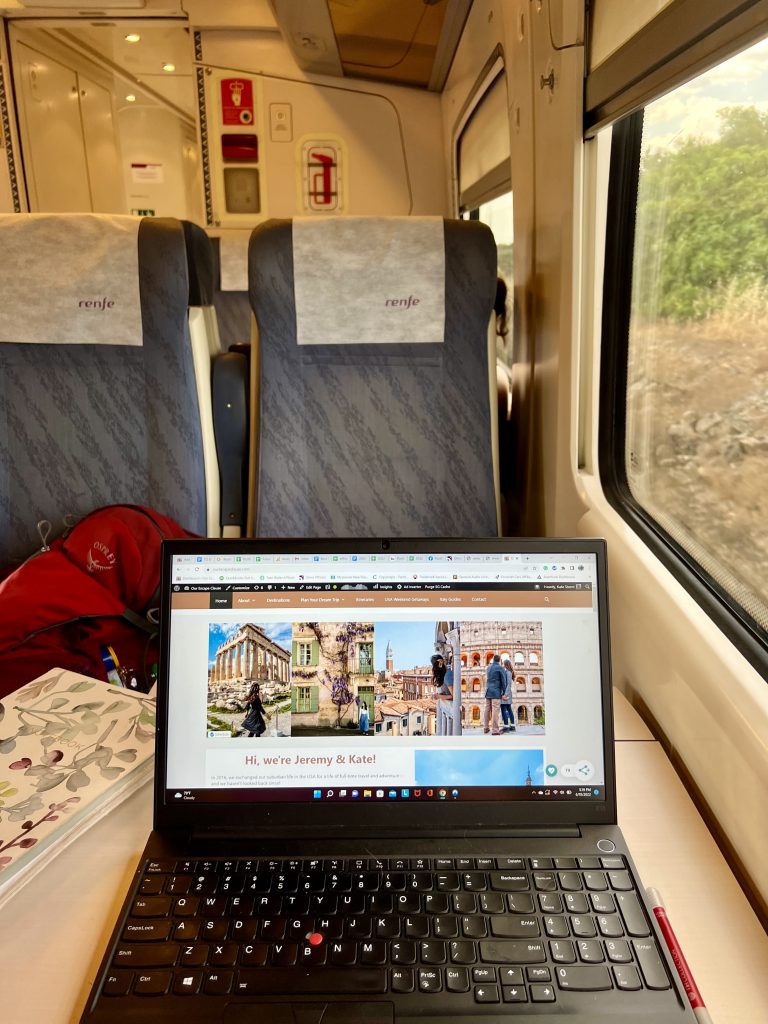
(Be sure to show up early, too, as high-speed train routes in Spain require a security check before boarding).
We use and recommend Omio , a ground transportation aggregate that is popular for traveling in Europe, for checking timetables and purchasing tickets.
For traveling between Spain and Portugal, which in this itinerary means traveling from Seville to Lagos, you’ll want to book a bus ( you can also do this through Omio , and the journey takes around 5 hours).
While it is possible to rent a car for this part of the route too, one-way drop-off fees between countries are generally astronomical.

Once you’re in Portugal, depending on your travel style, you might prefer to rent a car for the Algarve portion of your trip and then drive the car to Lisbon, or to do without and take the train to Lisbon.
Taking the train between Lisbon and Porto is very simple, but if you’d rather step off the beaten path and visit somewhere like Óbidos , the Alcobaca Monastery, or Tomar along the way, driving can also be fun!
This guide for traveling between Lisbon and Porto breaks down your options in detail.
Shop rental cars and train tickets for your 2 weeks in Spain and Portugal today!

Here on Our Escape Clause, we have written (and continue to write) extensively about traveling to Spain and Portugal.
Those guides include (but are far from limited to) standalone trip itineraries for Spain , Portugal , and Andalucia , as well as detailed itineraries for most cities covered in this itinerary (for example, here are our suggestions for Madrid , Seville , and Lisbon ).
For that reason, I’ll try to keep the descriptions of each day semi-brief, as this Portugal and Spain travel guide will no doubt be extremely long regardless!
For more detailed day-to-day advice, I’ll continue to link to additional relevant guides throughout the itinerary, and you can also peruse all of our Portugal blog posts here and/or Spain blog posts here .
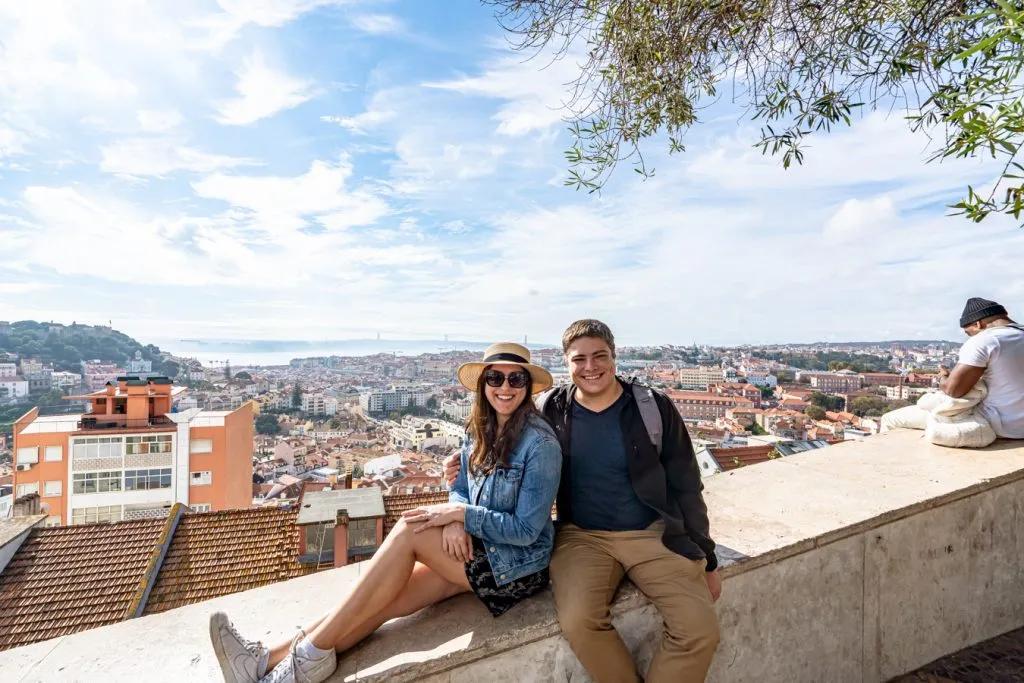
Day 1: Arrive in Barcelona and hit the ground running.
For the purposes of this 2 week Spain and Portugal itinerary, we’ll assume you arrive in Barcelona in the morning, jet-lagged but excited to start exploring!
(This is an extremely common schedule for flights from North America to Spain).
Once you drop off your language at your hotel (most are more than happy to store bags for you until check-in), it’s time to explore Barcelona’s iconic architecture.
On your first day in Barcelona, start with a visit to either Casa Milà or Casa Batlló , two of the most famous homes designed by Gaudi!
They’re fairly close together, but given how much there is to see in Barcelona, we recommend only going inside one and seeing the other from the outside.
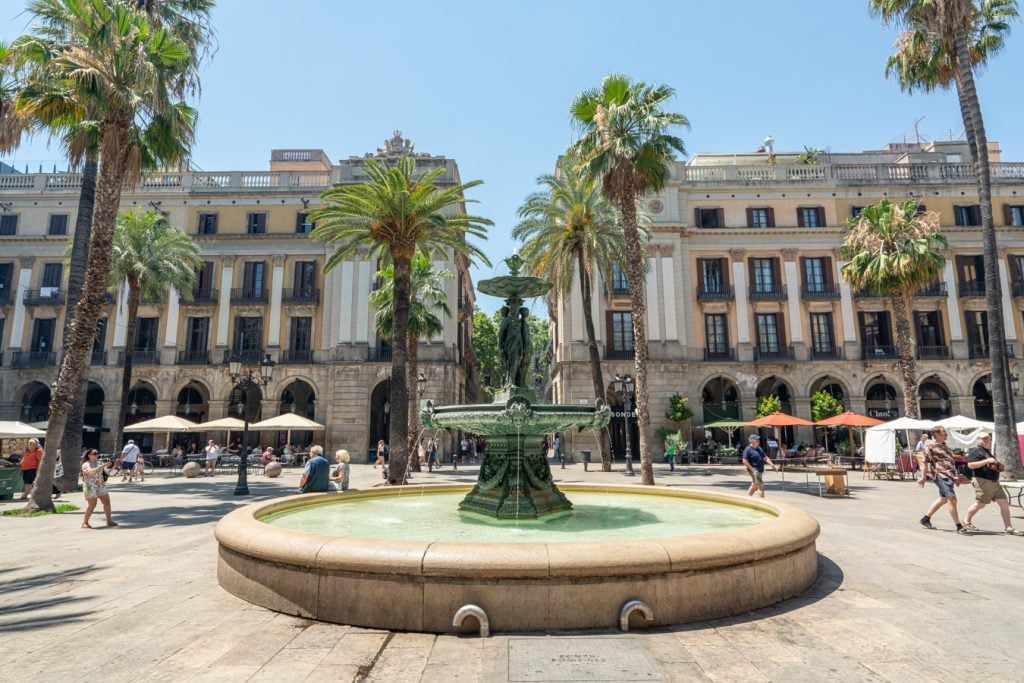
Personally, we recommend pre-booking tickets for Casa Batlló for as early a time in the day as possible.
After hitting up your first major attraction, take some time to explore the Gothic Quarter, including the Barcelona Cathedral, the Santa Caterina Market, the famous Las Ramblas, and Plaça Reia.
If you have time (and energy) Catalunya Plaza and Mercado de la Boqueria are also worth a look.
If you’re excited about all of Barcelona’s Catalan modernism architecture, we can also heartily recommend a visit to Palau de la Música Catalana .
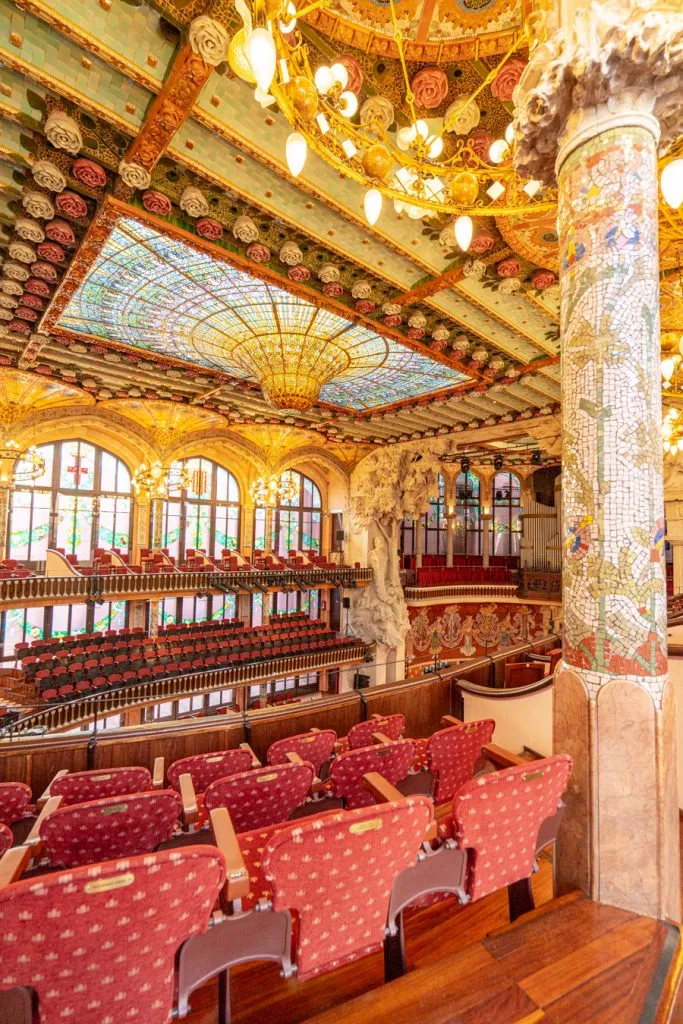
Though not designed by Gaudi, it’s an amazing (and compared to much of Barcelona, uncrowded) example of the style and a memorable place to visit!
Barcelona’s Arc de Triomf is also only a 10-minute walk away, and Ciutadella Park is just beyond it.
From there, depending on your energy, it might be time for a (brief) afternoon nap!
If you can pull together enough energy in the late afternoon or early evening, though, heading down to Barcelona’s coastline and soaking up some sunshine on the beaches (whether that means a swim or just grabbing a bench and enjoying the environment) is a memorable way to close out your first day on the Iberian Peninsula.
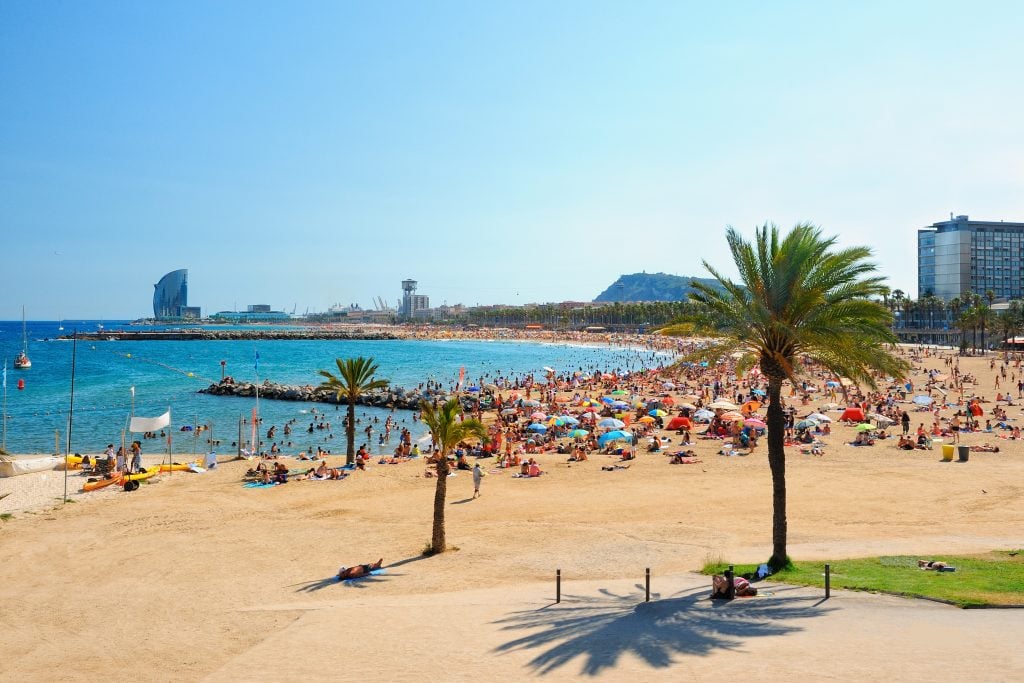
Where to Stay in Barcelona, Spain
When deciding where to stay in Barcelona, it’s important to keep in mind that this sprawling city requires some effort to move around.
In other words, there’s no way to stay near all the best things to see in Barcelona, but it’s best to stay by some of them!
We recently stayed at Citadines Ramblas Barcelona and were extremely satisfied–to the point that we may just keep going back on additional trips.
Our room was spacious, complete with a kitchenette, and extremely quiet despite the hotel being located in a prime spot right along Las Ramblas.
The view of the Barcelona Cathedral from the rooftop deck of the Colón Hotel Barcelona is pretty incredible too, though, and we have it bookmarked for a possible future trip.
If you’re traveling on a bit more of a budget, Hotel Nouvel also gets excellent reviews and is in a wonderful location.
Check rates & book your stay in Barcelona today!
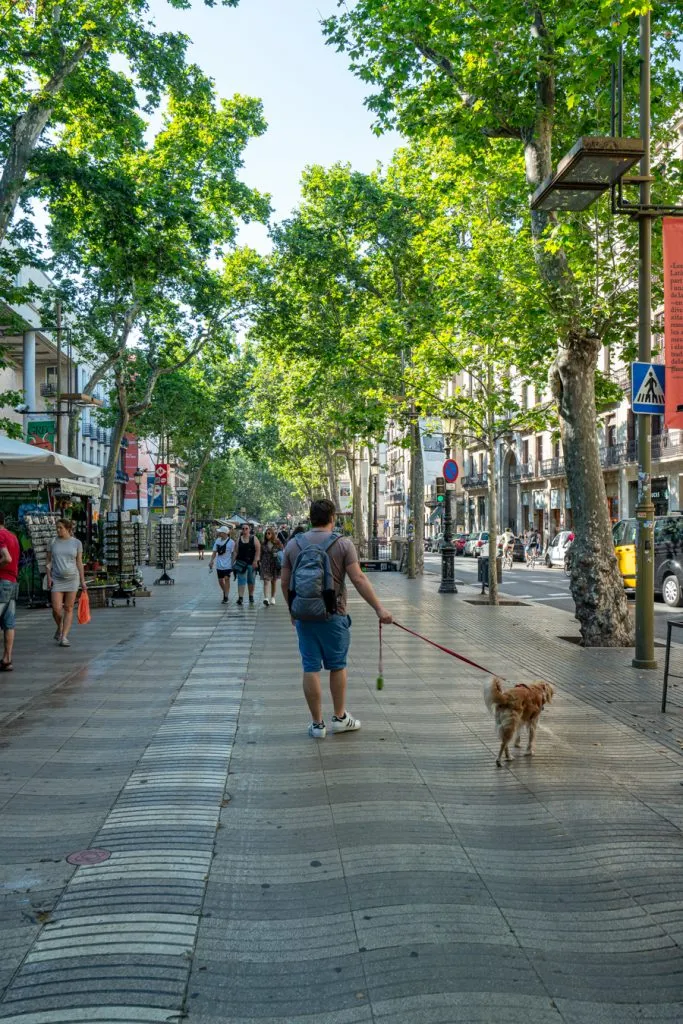
Day 2: Dive deeper into Barcelona.
After your first full day of exploring, it’s time to dive even deeper into Barcelona!
Today, plan to head further afield, starting with a visit to Park Güell and/or Tibidabo for one of the best views over sprawling Barcelona!
(Keep in mind that these are a bit of a trek from the city center, especially Tibidabo, so plan on using a chunk of time for transportation).
Later on, the incredible Picasso Museum (which holds over 4,000 of the artist’s works), is a must-see for art lovers in Barcelona, while Camp Nou is a popular pilgrimage for football lovers.
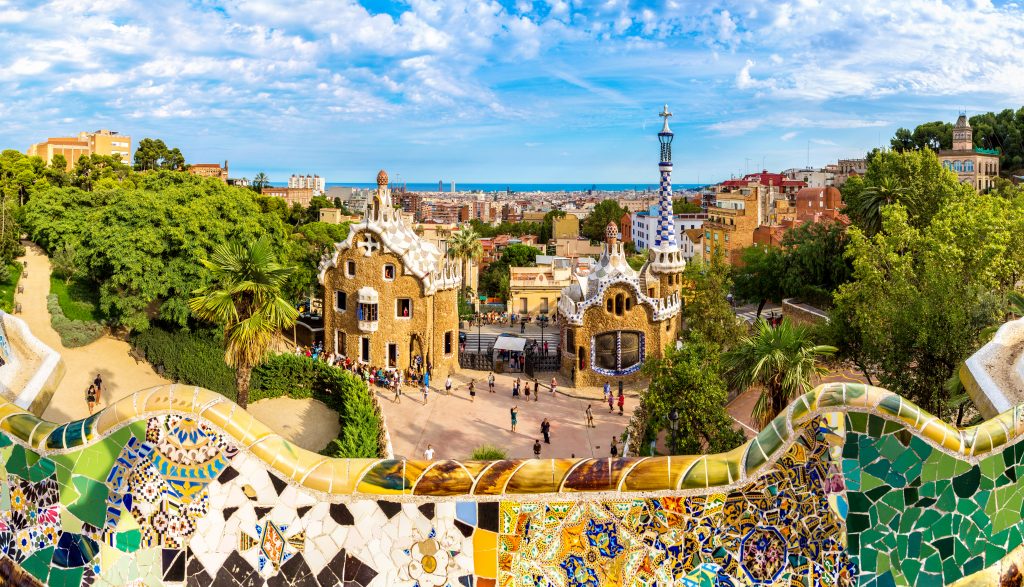
And, of course, we can’t forget the Sagrada Familia : Gaudi’s unfinished masterpiece of a cathedral is an absolute must-see when visiting Barcelona!
We visited in the early evening after hearing that the interior’s light was at its best then, and we were not disappointed–the colors were phenomenal.
If you wrap up at the Sagrada Familia before sunset and would like to enjoy the Mediterranean while in Barcelona, consider wrapping up your evening with a sunset catamaran cruise .
Book skip-the-line tickets to visit the Sagrada Familia today!

Day 3: Enjoy a morning stroll in Barcelona and then head to Seville.
After a last look at Barcelona–perhaps one more pass through the Gothic Quarter, a stroll along the beach, or a leisurely breakfast in a cafe–it’s time to head south to Andalucia!
Seville, the capital of Andalucia and one of the best places to visit in Spain, is a 6+ hour train ride from Barcelona.
Alternatively, it’s about a 2-hour flight between the 2 cities.
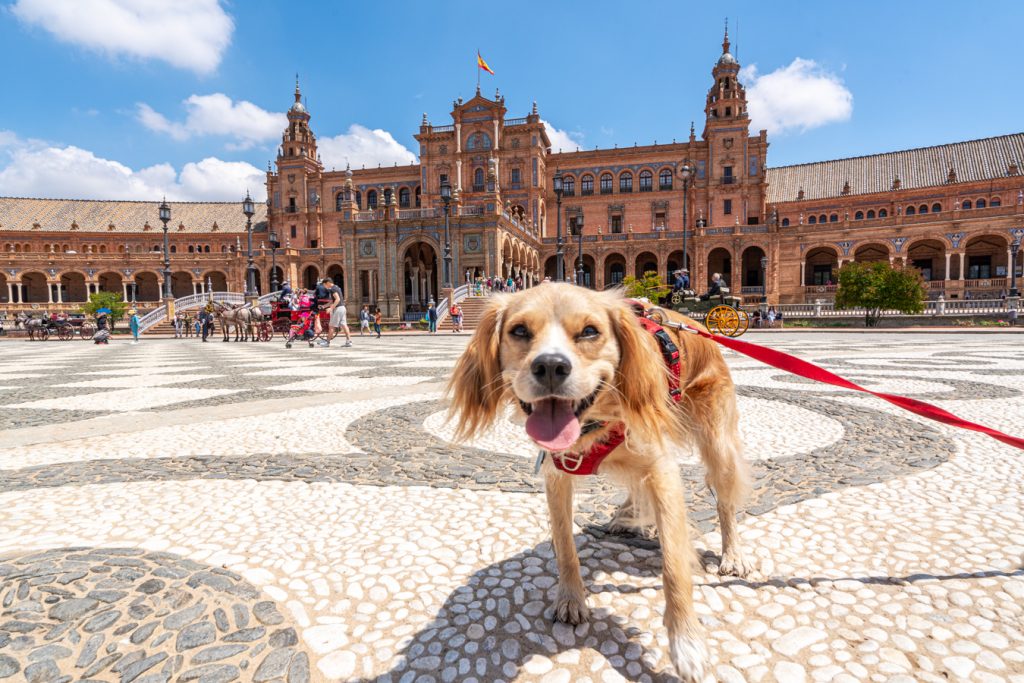
While we personally find the train more comfortable and pleasant (and it saves you the time and hassle of getting to and from the airports), there’s another factor to consider: flying is sometimes cheaper than traveling by train.
We recommend considering and pricing out both options, but either way, most of day 3 will be eaten up with getting to Seville!
Once you arrive, meander through Barrio Santa Cruz, grab dinner (or just a bunch of tapas– this popular tapas crawl is a fun option if you want to find the best spots with ease) and rest up for a full day of sightseeing tomorrow.
Shop train tickets from Barcelona to Seville today!
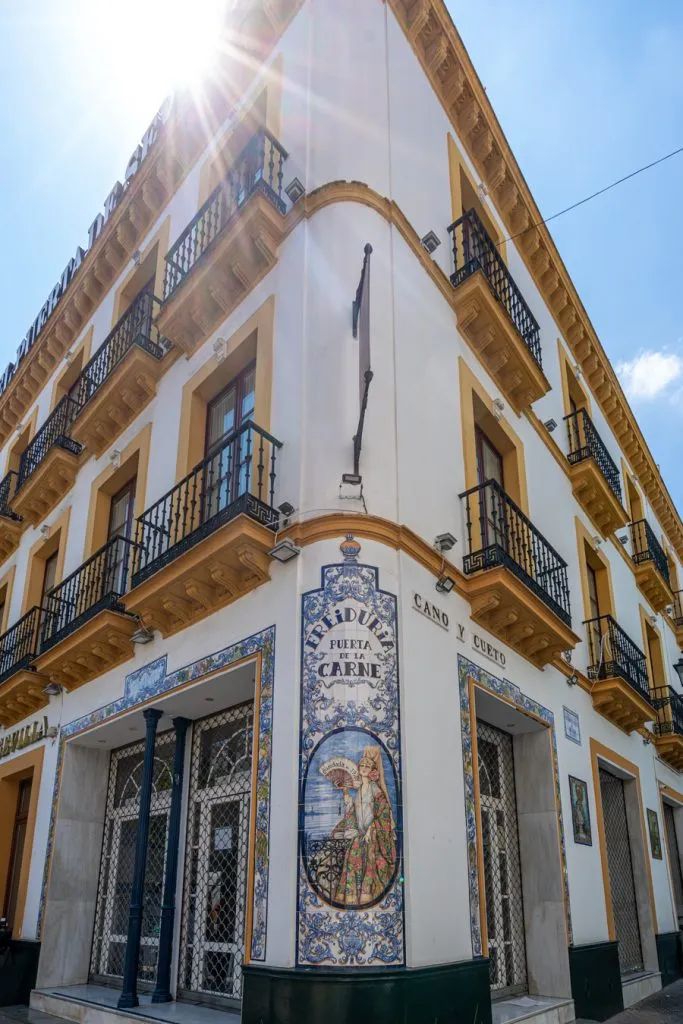
Where to Stay in Seville, Spain
When deciding where to stay in Seville, location is key as ideally, you’ll want to stay within walking distance of Seville’s best attractions.
We had a fantastic experience at Petit Palace Puerta de Triana on our most recent trip to Seville.
The hotel has a fantastic location (central but also quiet–a far-from-guaranteed combination in Spain), a delicious breakfast, and comfortable rooms.
Looking for something a bit different?
The incredibly popular Hotel Rey Alfonso X is an excellent choice, and its rooftop views are sublime!
If you’d like to stick to more of a budget, Hotel America Sevilla gets wonderful reviews and doesn’t sacrifice too much in terms of location.
Meanwhile, for the height of luxury, you can’t beat the absolutely stunning Hotel Alfonso XIII !
Check rates & book your stay in Seville today!
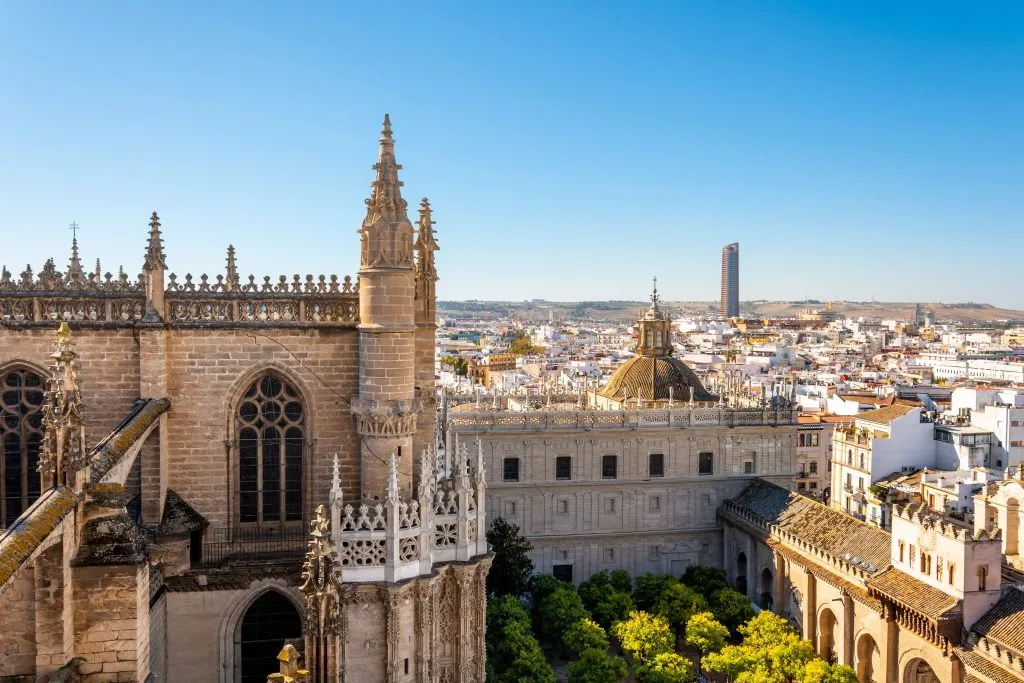
Day 4: See the best of Seville.
Today, it’s all about appreciating the beauty of colorful, vibrant Seville!
Don’t miss the chance to visit the gilded and glamorous Seville Cathedral (with a side of dark history: you’ll find the tomb of Christoper Colombus here).
Climbing the cathedral’s bell tower (Giralda) for incredible views of the city is also incredibly memorable, and included with your ticket for visiting the Seville Cathedral .
The tiled Plaza de Espana, which is one of the most photographed spots in the city, is also a must-see!
One of Seville’s top attractions, the Royal Alcazar of Seville , is definitely worth experiencing–but depending on your sightseeing style, you may prefer to skip it and enjoy relaxing in the city more.

The Alcazar, with its complex of intricate palaces and beautiful gardens, is incredible… but it is outshone by the Alhambra in Granada , which you’ll be seeing in a couple of days when following this itinerary for Spain and Portugal.
If you’re a traveler who likes to leave no stone unturned, we recommend visiting the Alcazar first thing in the morning–otherwise, you have a more leisurely pace to work with.
Regardless of what you decide about the Alcazar, though, we highly recommend ending your evening with this wildly popular flamenco show , which is held in a venue dating to the 15th century and will give you an excellent taste of flamenco culture.
Flamenco is widely associated with Spain as a whole, but it originated in the south of Spain–and, according to some sources, it originated in Seville itself, making this the perfect place to pause for a show!
Book your flamenco show in Seville today!

Day 5: Take a half-day trip to Cordoba.
Less than an hour from Seville by train or car, you’ll find the captivating Andalucian city of Cordoba–which happens to be one of our favorite places in the region!
Once the most powerful city in Islamic Spain, the Cordoba of today is small and manageable, a bite-size tourism destination that nonetheless leaves a big impact on visitors.
Cordoba is most famous for its incredible Mosque-Cathedral –literally a former mosque with a cathedral built into its center–which is one of the most memorable buildings we’ve had a chance to visit anywhere.

The Mosque-Cathedral should absolutely be your top priority when visiting Cordoba, but beyond that, there’s still plenty to see within a short walk!
Snapping photos of the picturesque Calleja de las Flores, relaxing in the Patio de los Naranjos, wandering through the Jewish Quarter, and checking out some of the beautiful patios of Cordoba should also be on your to-do list.
After enjoying the best of Cordoba, head back for a relaxing night in Seville.
You’ll need the rest: tomorrow will be one of the busiest days during your Spain and Portugal vacation!
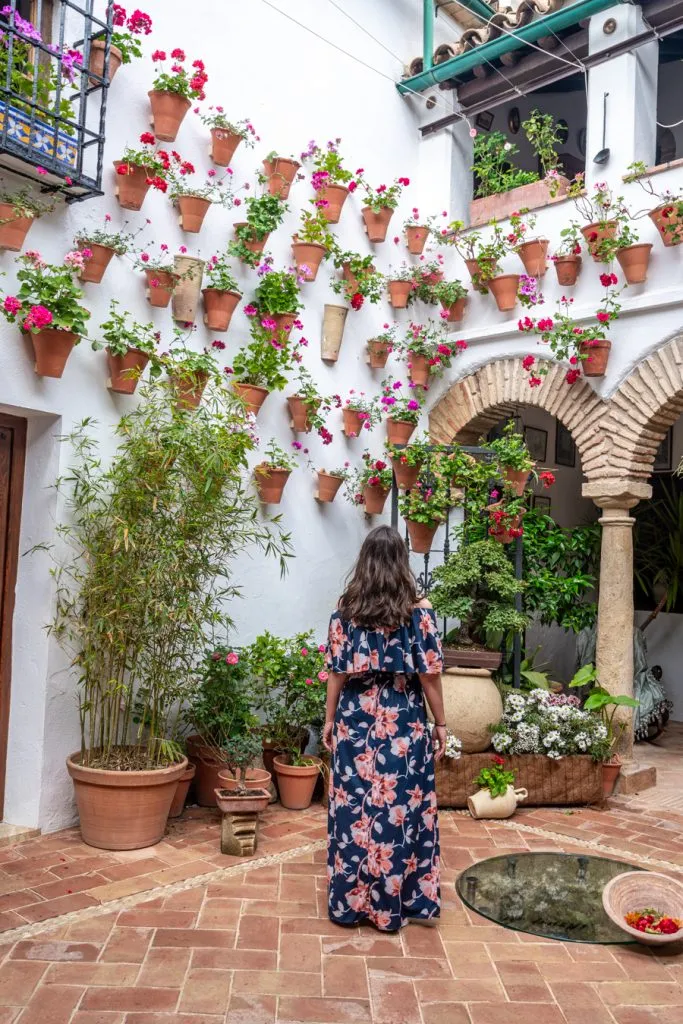
Day 6: Experience the legendary Alhambra.
Today is all about enjoying one of the giants of tourism in Spain: Granada’s legendary Alhambra.
This collection of centuries-old palaces (plus a fort, gardens, ruins of a medina, and more), is one of the most unique groupings of architecture in Europe, and the most-visited tourist attraction in Spain!
We wrote about visiting the Alhambra extensively here , so I’ll try to keep this (kind of) brief, but the long and the short of it is that this is a place you need to plan ahead for.
Tickets often sell out, but coming from Seville for the day, we highly recommend booking an organized day trip (and as a bonus, that means you won’t need to book as far in advance as travelers hoping to score tickets independently).
Why take a tour?

While the Alhambra is absolutely worth seeing–it’s truly one of the most incredible places to visit in Spain, and worth going out of your way for–it’s in Granada, which is 3 hours, each way, from Seville.
Add in getting to and from the Alhambra itself and wanting to leave a small amount of time to sample the rest of Granada (we love this city!), and letting someone else take the lead will make your life much easier.
If that doesn’t appeal, there are two alternatives.
First, you could spend the previous night in Granada ( we stayed here and loved it )–but that will add on hours of travel to your journey to Portugal tomorrow.
Alternatively, you could opt to enjoy the Royal Alcazar in Seville instead, perhaps take a half-day trip to a closer town like Ronda or Setenil de las Bodegas, and save the Alhambra for another trip.

If you don’t expect to be back in Andalucia soon, we believe the Alhambra and Granada are worth the headache–but with only 14 days to visit Spain and Portugal, it’s completely understandable if you’d rather slow down a bit, too.
If you do want to experience the Alhambra, this day trip gets great reviews and covers transportation, the Alhambra (including the essential tickets to the Nasrid Palaces), and time in Granada’s beautiful Albayzin neighborhood.
Don’t miss the view from the Mirador de San Nicholas!
Book your day trip to the Alhambra in Granada today!

Day 7: Say goodbye to Spain and hop over to Lagos, Portugal.
As you hit the halfway point of your Iberian adventure, it’s time to trade Spain for Portugal!
The simplest and most efficient way to travel from Seville to Lagos will be to travel by bus , which takes about 5 hours.
Unfortunately, with no trains between Seville and the Algarve, and no direct flights, there are limited transportation options to work with.
However, the good news is that if you haven’t been on a bus since you were school-aged, these buses are likely much more comfortable than you may think!
Considering driving?
Unfortunately, picking up a rental car in one country and dropping it off in another tends to incur extreme fees–think around 1000 Euro, give or take.

Once you arrive in Lagos, check into your hotel and head to the sea!
If you’re ready to stretch your legs (and have enough time in the day–summer visitors will likely have better luck here than winter ones ), consider hiking the Ponta da Piedade coastal trail to one of Portugal’s most famous viewpoints.
It takes a bit over an hour each way, though you can trim time on the way back by simply hiking along the road instead of the trail (though it’s much less scenic).
Want to enjoy the views from Ponta da Piedade, but without the hike?
Calling a ride share (we tend to use FreeNow in Europe, though Uber works too) will get you there from the historic center of Lagos in just a few minutes.
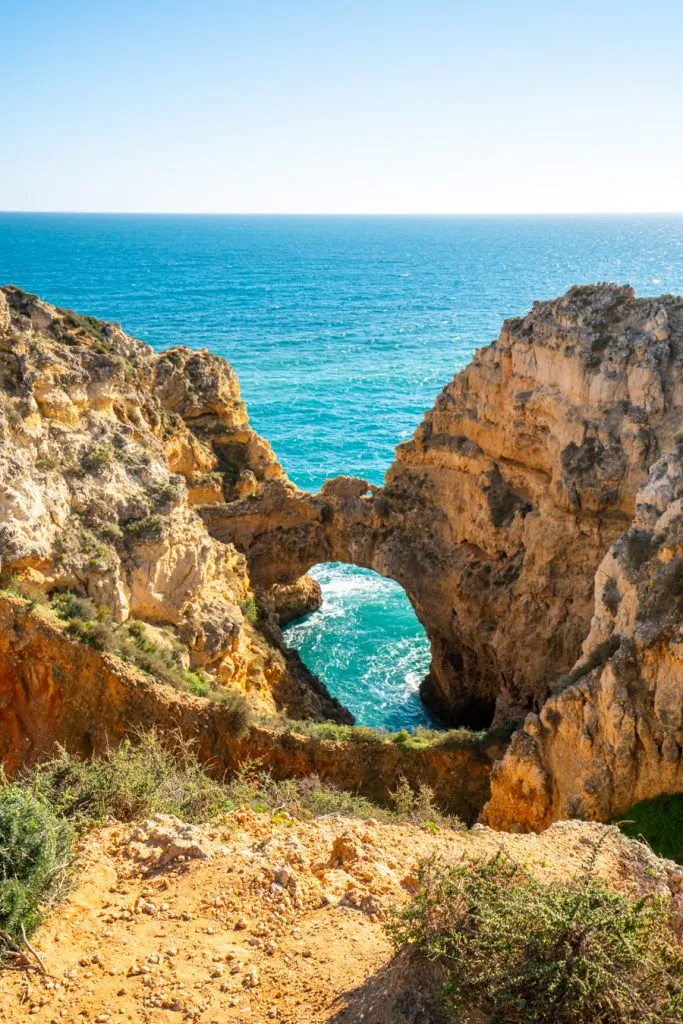
Where to Stay in Lagos, Portugal
Lagos’ central location, beautiful beaches, and convenient town center make it a fantastic place to base yourself during your time in the Algarve!
Each of these properties boasts excellent reviews and a prime location within walking distance of many of the top things to do in Lagos.
For budget travelers, a fantastic included breakfast, private room, and free parking are all waiting for you at Dream Lagos B&B –and as the rave reviews indicate, you won’t be disappointed.
The trade-off is staying a bit further from the town center, though still within walking distance.
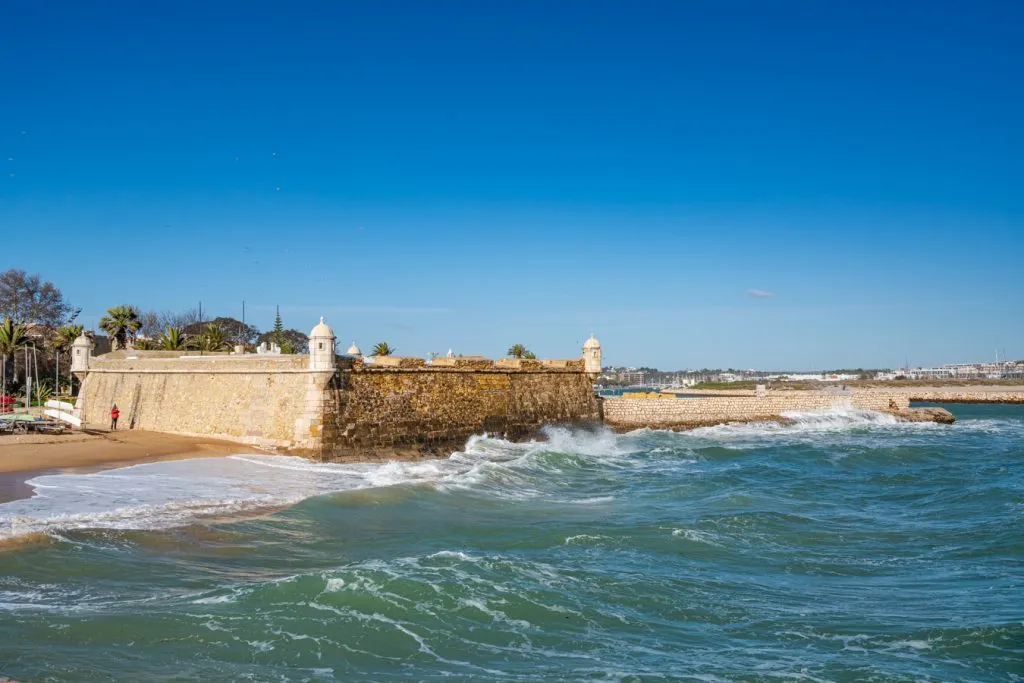
For mid-range travelers, Hotel Lagosmar features excellent reviews and a perfect location right across from the Lagos Marina, plus a rooftop terrace with gorgeous views of the sea and town.
If you’d like to splash out a bit (and by the standards of much of Europe, the Algarve is a very affordable place to do so outside of the peak summer months), Tivoli Lagos makes a wonderful base in Lagos.
We adored our stay at this 4-star resort and would be thrilled to return to enjoy the beautiful property, gorgeous pool, restaurants, and delicious included breakfast again.
With free parking (almost) on-site, comfortable rooms, and incredibly easy access to Lagos’ attractions, Tivoli Lagos is a fantastic place to stay.
Check rates & book your stay in Lagos today!
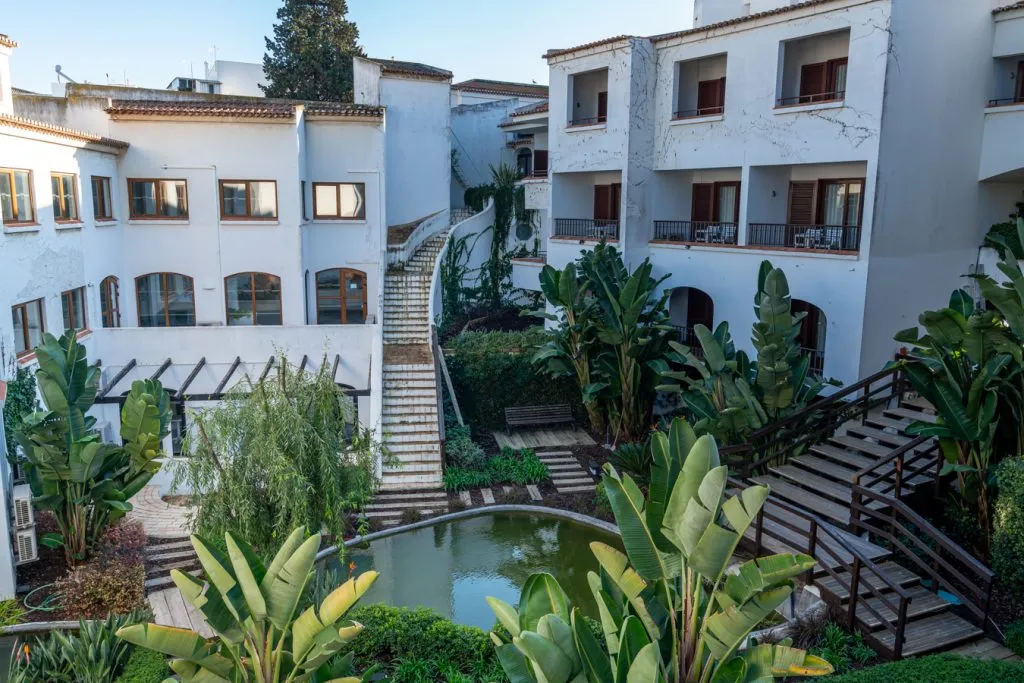
Day 8: Soak up Algarve views.
With one full day to enjoy the Algarve, the best way to spend your time depends on a few factors, including your travel style, the season, your energy levels now that you’re past the halfway point of your 2 week trip through Spain and Portugal, and whether you feel like driving.
First things first, though: want to find a beach and spend all day on it?
You’re in a great place for that (though fair warning for those who grew up in hot climates like us: the water is quite chilly in the Algarve, even in summer).
Praia Meia, Praia do Camilo, Praia dos Estudantes, and Praia do Pinhão are just a handful of the many dreamy beaches in the immediate vicinity of Lagos (some within walking distance) that are excellent places to relax.
Praia do Camilo in particular is so scenic that it’s worth stopping by just to admire it for a minute!
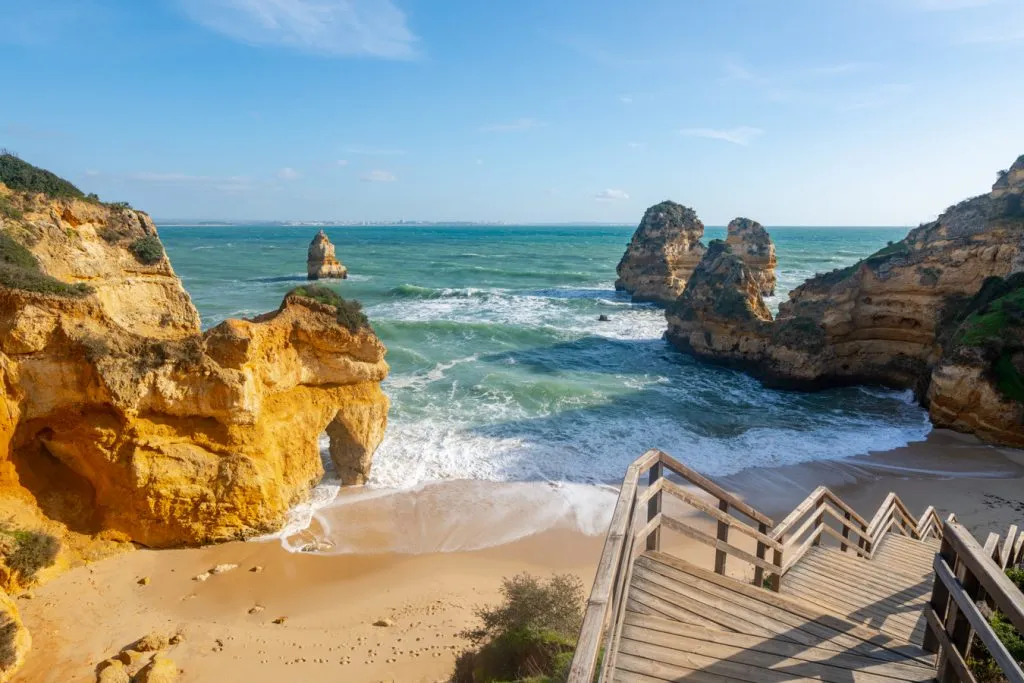
Craving more activity?
Heading back to Ponta da Piedade, this time from the water, is an incredible experience!
Whether you want to kick back and relax on a boat ride or join an adventurous kayaking tour , you’ll be treated to unforgettable coastal views.
With any luck, you may spot a few dolphins, as well (though if that’s your focus, a dolphin spotting cruise might be more your speed).
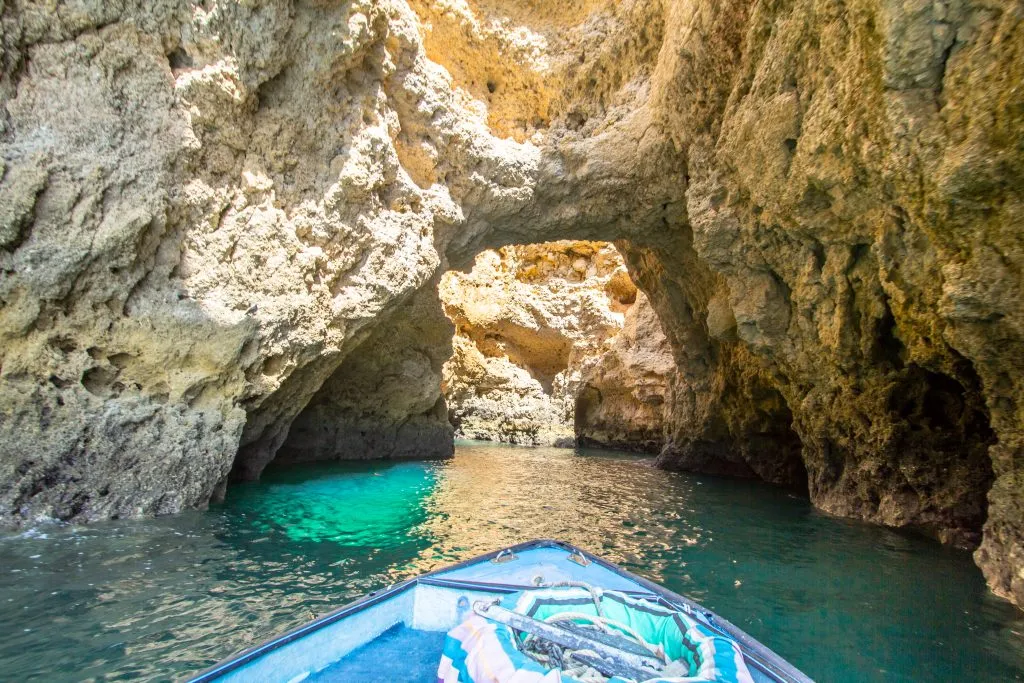
Willing to head 30-45 minutes away from Lagos by taxi, ride-share, or rental car?
The famous Benagil Cave can be visited from the charming town of Carvoeiro, and the magnificent Seven Hanging Valleys Trail and Marinha Beach can also be accessed nearby!
If you want to actually walk inside Benagil Cave, though, prepare to sweat for it: popular boat tours like this can enter the cave but can’t land there.
If you want to land… you’ll need to visit by kayak or SUP (but don’t worry–it’s only a 200m distance or so from the shore).
Book your Benagil Cave kayaking tour or small boat tour today!
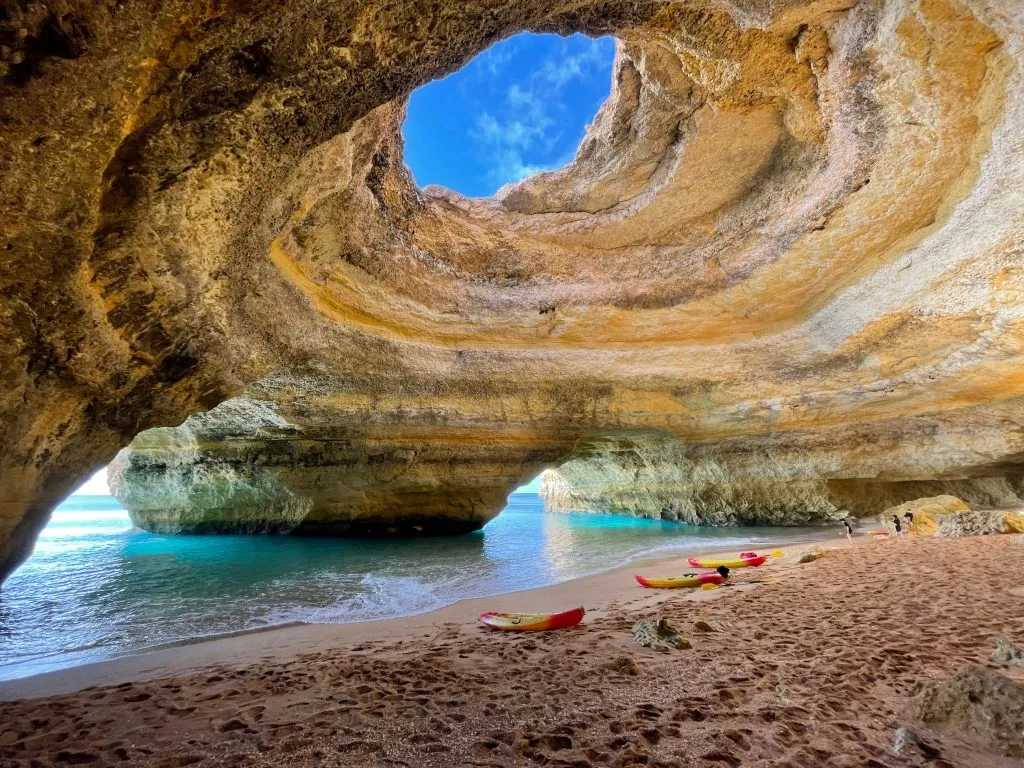
Day 9: Make your way to Lisbon.
After a last breakfast, a local beach stroll, and possibly even a quick morning visit to Ponte da Piedade, it’s time to say goodbye to the Algarve and head north to Lisbon–our former home for more than a year and a downright delightful city to visit.
The fastest way to get to Lisbon from Lagos is to drive, however, since you won’t need a car once you arrive (and you’ll incur a one-way drop-off fee for returning the car to a different city), you’ll likely want to opt for a train or bus instead.
The train is the most comfortable option, but generally takes between 4 and 5 hours and requires you to make a change, as there are no direct routes between Lisbon and Lagos.
The bus, while less comfortable, is cheaper, doesn’t require a change, and is a bit faster.
You can check both train and bus prices and times here.

Once you arrive in Lisbon, it’s time to check into your hotel and then hit the ground running with sightseeing!
We loved this food tour , which starts later in the afternoon, and it is an excellent way to get introduced to the city.
Alternatively (or in addition!), head to the top of Lisbon to enjoy the gorgeous views from the remains of Castelo de São Jorge , and meander through Alfama.
Here, you’ll see many Lisbon postcards come to life, including the views from the Miradouro das Portas do Sol and the Miradouro de Santa Luzia, the famous Tram 28 (though we don’t recommend riding it–just snap photos from outside) and the Lisbon Cathedral.
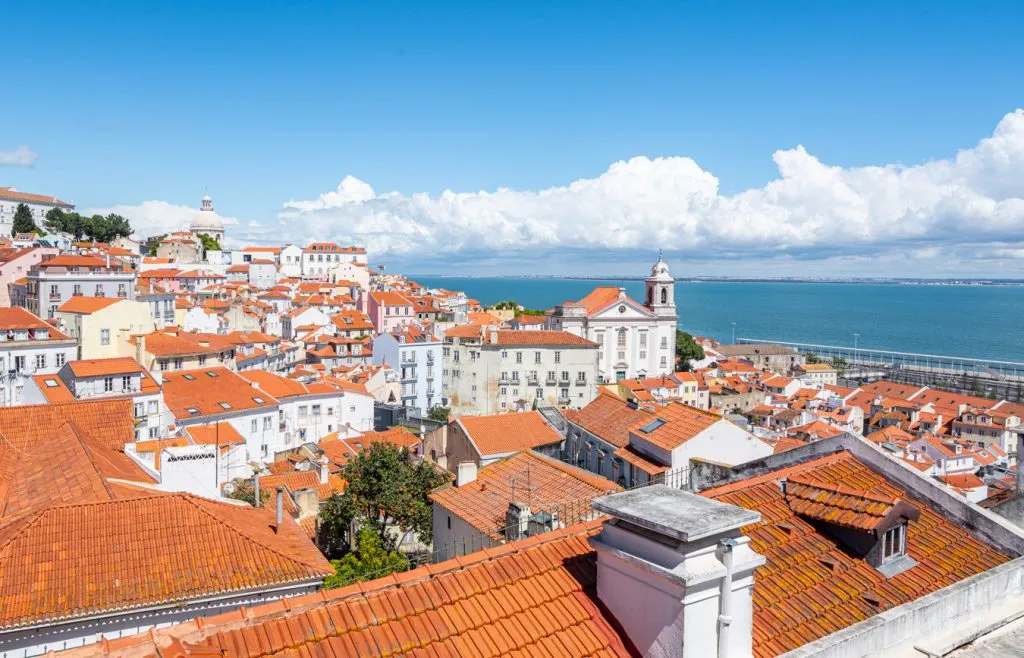
As you head downhill from the heart of Alfama, you’ll reach the riverside neighborhood of Baixa (where the food tour starts).
Be sure to check out Praça do Comércio, Rossio Square, and the Church of São Domingos while there!
If you’re interested in experiencing an evening Fado show in Lisbon, tonight is a great opportunity to do so.
Book your Lisbon food tour today!

Where to Stay in Lisbon, Portugal
While there are plenty of excellent neighborhoods to stay in throughout Lisbon, we recommend picking somewhere central with good transportation connections around the city.
Alfama, Baixa, Chiado, Principe Real, and Barrio Alto are great names to keep an eye out for when browsing places to stay.
For a budget-friendly hostel experience (with private rooms available), the Sunset Destination Hostel is a great, centrally located option.
At a mid-range price tag, you can’t beat the location or rave reviews for Tempo FLH Hotels Lisboa .
Looking for a splurge?
The Lumiares Hotel & Spa is part of the much-acclaimed Small Luxury Hotels of the World Collection, and offers stunning views that you won’t forget anytime soon!
Check rates & book your stay in Lisbon today!
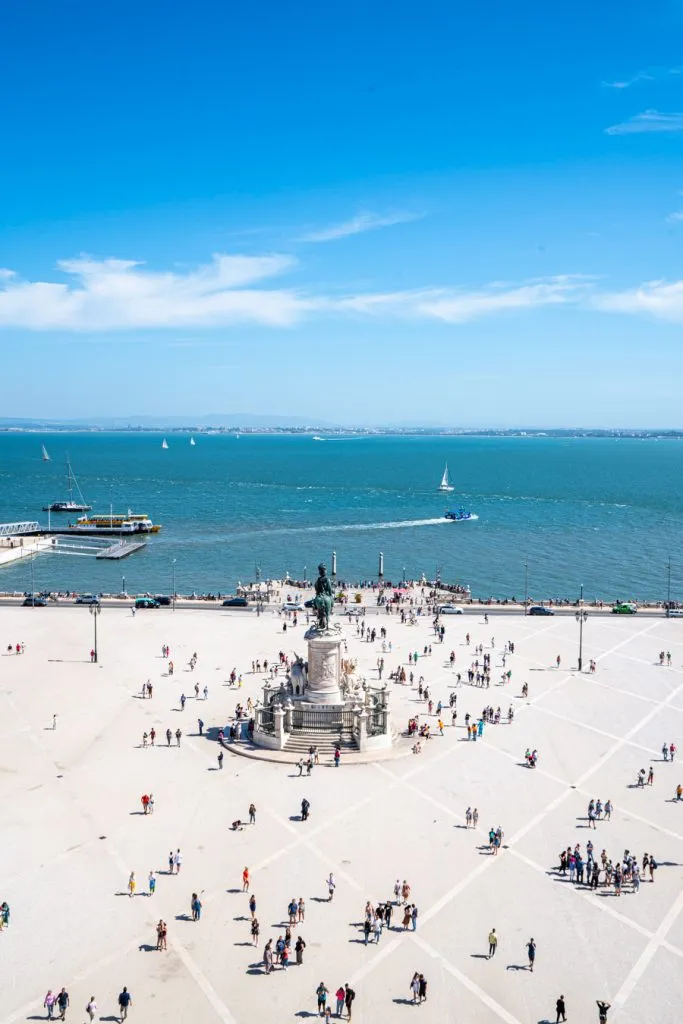
Day 10: Enjoy sightseeing in Lisbon.
Today is all about sightseeing in Lisbon–and wear some comfortable shoes, because it will be a long (and hilly) journey!
First things first: if you didn’t visit Alfama yesterday, take a quick stroll through there and the neighborhood of Castelo (and stop for some pasteis de nata at Pastelaria Santo António while you’re at it).
If you’ve already visited Alfama, start your morning in Lisbon’s Bairro Alto (high town) and Chiado, exploring a corner of the historic center that you didn’t get to see yesterday!
Highlights include the Miradouro de São Pedro de Alcantara, the overwhelming Church of São Roque, the Carmo Convent, and a stop at Livraria Bertrand , the oldest still-operating bookstore in the world.
If you’re a fan of glitzy cafes, consider also grabbing a coffee and pastry at A Brasileira.
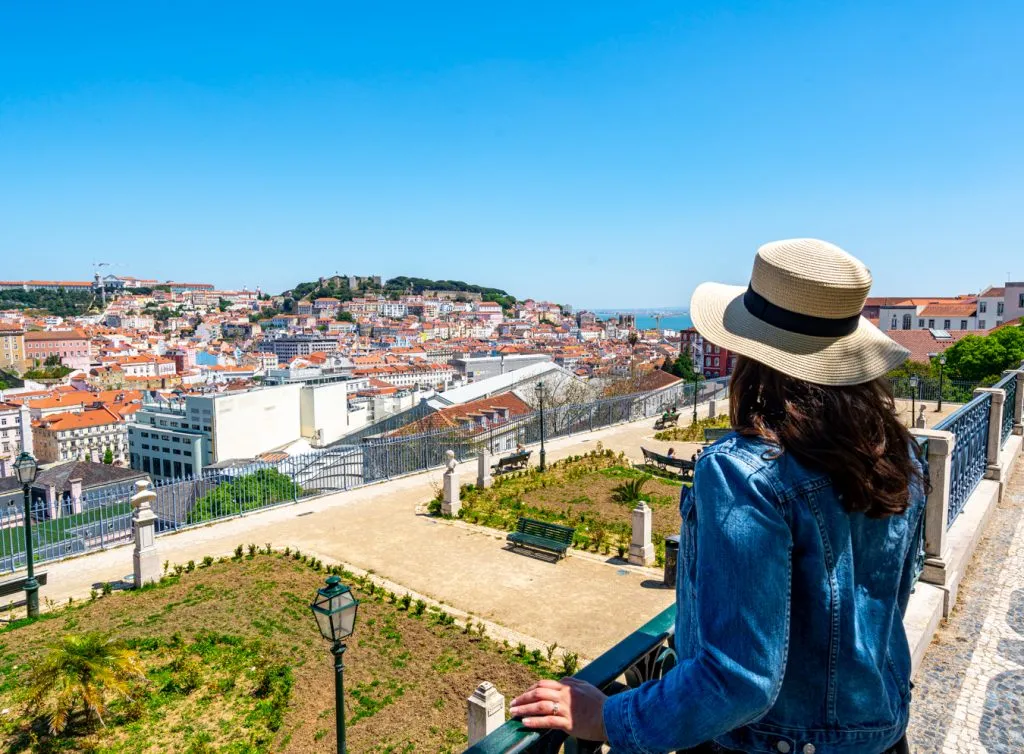
From there it’s time to head over to the popular riverside neighborhood of Belém (taxi or ride share will be the easiest way to get there).
Here, you’ll find the famous Jerónimos Monastery and accompanying church (the church is free to enter, the monastery is not), the gorgeous Belém Tower (you don’t need to go in, but it’s worth seeing the exterior), the Monument of the Discoveries, and stunning views of the Tagus River.
You’ll also find the wildly popular Pastéis de Belém, which serves up the original pastéis de nata.
Yes, they are worth the long line (hint: the table service line is often much shorter than the takeaway line!), but if standing in line for carbs isn’t your thing, Manteigaria, another popular Lisbon bakery, has a location just down the street.

Meanwhile, the Jerónimos Monastery, while a must-see, is home to some of the longest lines for any tourist attraction in Portugal!
Pre-book your ticket and, since you’re visiting Belém in the afternoon, consider going close to closing time.
In the evening, close out your day with a sunset boat cruise on the Tagus River, soaking in some of the best views of Lisbon, the Tagus, and the Ponte 25 Abril Bridge from the water.
We absolutely loved our sunset cruise experience in Lisbon and highly recommend it–kicking back and relaxing with beautiful views is the perfect way to end a busy sightseeing day.
Book your sunset cruise in Lisbon today!

Day 11: Take a day trip to Sintra.
Set in the hills just outside of Lisbon, the beautiful town of Sintra–complete with several fantastic palaces–is easily among the most popular places to visit in Portugal.
From the beauty of the distinctive yellow-and-red Pena Palace to the quirky Alice in Wonderland vibes of Quinta da Regaleira to the stunning views from the Moorish Castle and beyond, visiting Sintra is incredibly memorable and worth the effort.
… But, its popularity also has another side effect: the palaces of Sintra are among the most crowded places included on this Iberian Peninsula itinerary, so be prepared for that.
With only 2 weeks to cover both Spain and Portugal, you’ll want to visit Sintra on a day trip from Lisbon, and that essentially leaves you 2 options: travel by public transportation, or on a guided day trip like this .
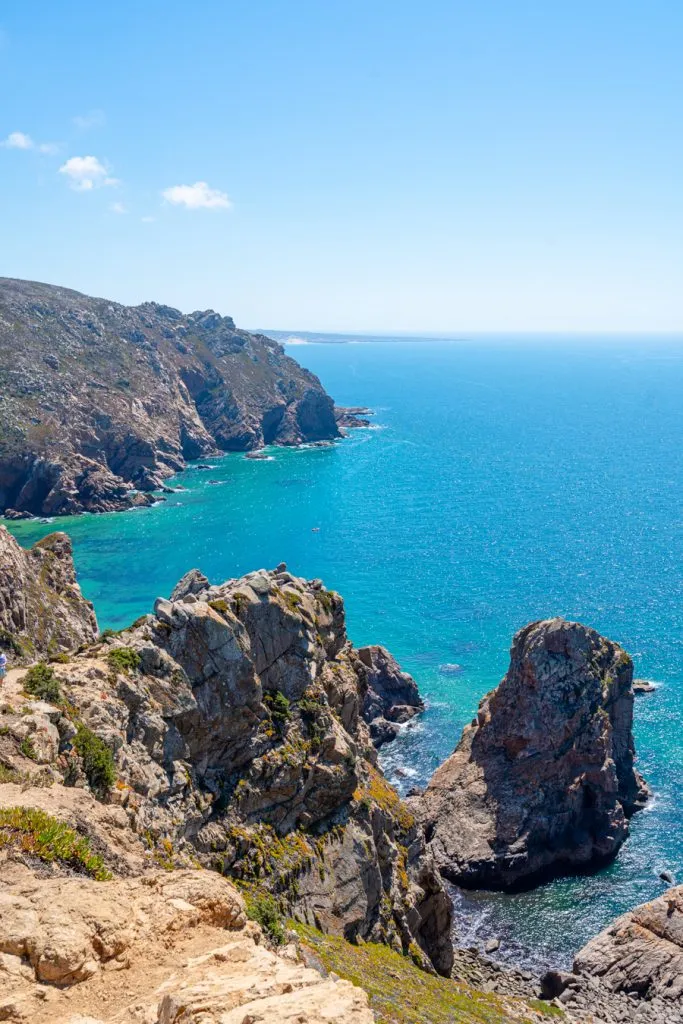
This day trip is one of the most popular tours in Portugal and includes visits to Pena Palace and Quinta da Regaleira as well as Cabo da Roca (long believed to be the westernmost point of mainland Europe, now simply a stunning viewpoint), and a short stop in the resort town of Cascais .
The pros of taking a tour are simple: as the palaces in Sintra are far enough apart that you can’t walk between most of them and parking is very tricky, it saves you time and allows you to see more.
The cons are simple too: with so many stops to make, you won’t have much time to linger.
If you’d rather travel independently, you can absolutely do that as well, though we recommend nabbing your tickets for Pena Palace and other popular places in advance.
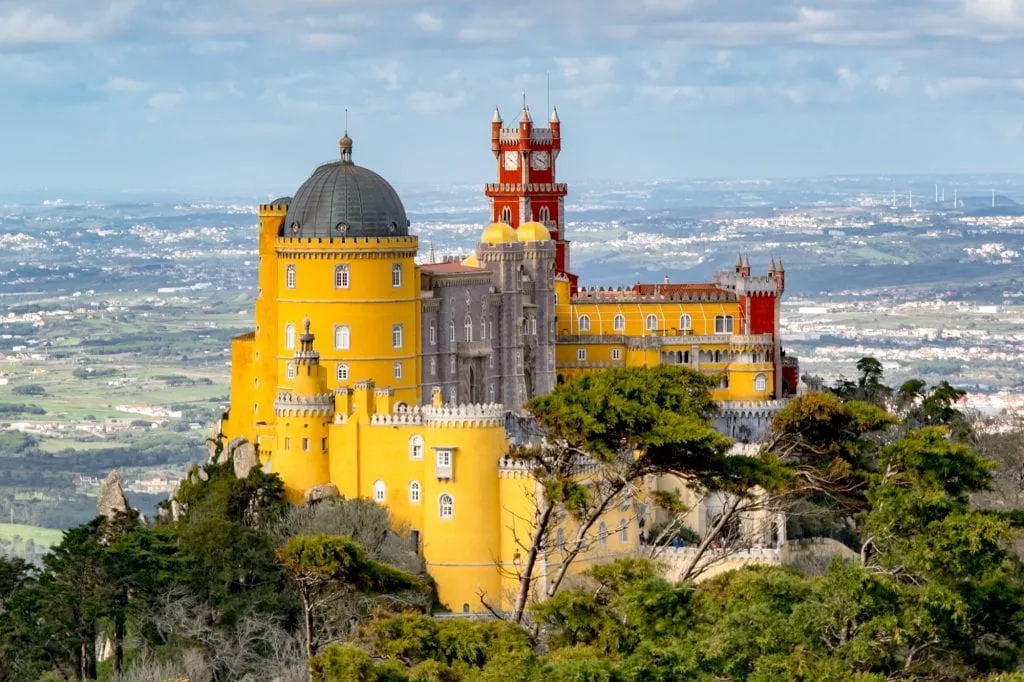
The train takes about 40 minutes from central Lisbon.
Once you arrive in Sintra, you’ll board one of 2 buses that will take you to your first palace, and then (depending on which palaces you choose to see) another to your second and maybe third, depending on how fast you explore.
When you’re finished, you can head back to Lisbon via train or simply call an Uber (which is what we tend to do).
Book your day trip to Sintra today!

Day 12: Make your way from Lisbon to Porto.
All aboard to Porto!
The final destination of this itinerary for 2 weeks in Spain and Portugal, the beautiful city of Porto is compact and memorable, featuring stunning river views, endless port (and if you don’t think you like port… try it here before you commit to that opinion), and oodles of azulejos .
Easy sightseeing and a relaxed vibe make it the perfect final destination of your trip–but first, you need to get there!
The easiest way to travel from Lisbon to Porto is to take the train, which travels directly between the 2 cities and takes about 3.5 hours.
Most trains leave from Lisbon’s Santa Apolonia Station and run consistently throughout the day.
We go into more detail on managing the journey between the 2 cities in this blog post .
We recommend booking your train tickets for the earliest time you feel comfortable with–the sooner you get to Porto, the better!

Once you arrive in Porto, drop your bags off at your hotel (if it’s not time for check-in yet, they should be able to hold them in the lobby for you) and get ready to explore!
If you’re looking for a quick lunch, the roast pork and soft cheese sandwich at Casa Guedes is a great place to start.
From there, we recommend checking out some of Porto’s attractions that are further from the river, such as the Chapel of Souls, the Church of Saint Ildefonso, and Rua Santa Catarina.
If you have time, head over to the Church of Carmo, as and soak up the view from Miradouro da Vitória (and if you don’t have time to visit the Church of Carmo today, add it to your list for tomorrow).
And, of course, you can’t forget the very first attraction you’ll see as you arrive in Porto: the interior of the São Bento train station is magnificent!

Where to Stay in Porto, Portugal
We’ve visited Porto several times now, and have made a habit of staying at Pestana Porto – A Brasileira or NH Hotel Porto Batalha during our visits.
Both hotels are beautiful, with excellent customer service and incredibly central locations that both make it easy to explore Porto on foot and easy to check in when arriving by train.
(They both also welcome Ranger, a must for us).
If you’re traveling Spain and Portugal on a budget, the Zero Box Lodge Porto gets excellent reviews.
Check rates & book your stay in Porto today!
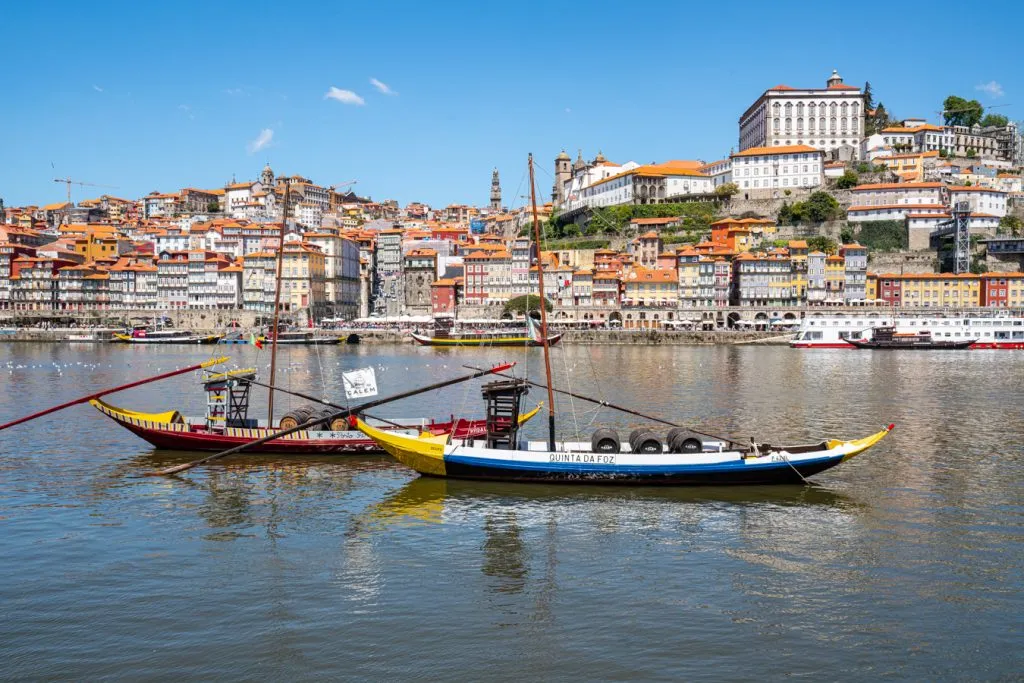
Day 13: Get to know Porto (and Vila Nova de Gaia).
After a leisurely brunch (we can heartily recommend Floresta Cafe and Esquires Coffee, both of which we’ve eaten at many times), make your way to Clerigos Tower to enjoy one of the most stunning views of Porto!
From there, check out the Porto Cathedral–while the church is free to enter, it’s well worth forking over a few Euro to explore the cloisters and attached museum, too.
Meander down toward the gorgeous Bolsa Palace (if you want to go inside, you’ll need to book a 30-minute guided tour ) and the Church of San Francisco, which is home to a downright stunning interior!

At this point, you’ll be very close to Porto’s vibrant, famous, and colorful riverside, also known as the Ribeira District.
Once the haunt of fishermen and sailors, and now the haunt of tourists, the Ribeira district is a beautiful place to relax and enjoy views of Porto.
Like many picturesque neighborhoods around the world, the restaurants here tend toward being expensive and mediocre, but you can find occasional gems (we enjoyed our meal at Grupo Desportivo Infante D. Henrique, which has a great view but is a bit out of the hustle and bustle).
From Ribeira, make your way across the (lower level of the) Dom Luis I Bridge, to Vila Nova de Gaia.
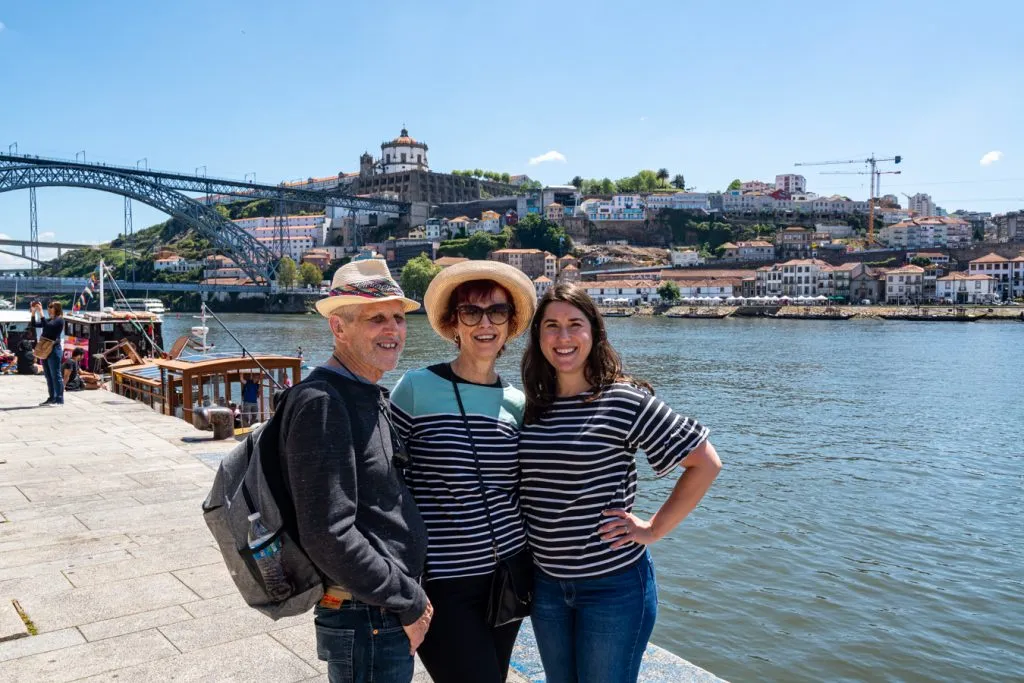
This charming riverfront destination is technically a separate city from Porto, but it’s also home to all of the port lodges, and no trip to Porto is complete without a port tasting!
This port cellar tour and tasting will give you a good idea of what to expect from a typical tasting, and you can either opt for an organized tour or a build-your-own adventure experience ( Quinta dos Corvos is a personal favorite lodge of ours).
This is also where you can hop on a 6 Bridges Cruise to experience Porto from the water for an hour–a delightful experience in and of itself.
Once you wrap up exploring Vila Nova de Gaia, ride the cable car back up to the top of the Dom Luis I Bridge, where you’ll be treated to gorgeous views over the city and an easy walk back to your hotel.
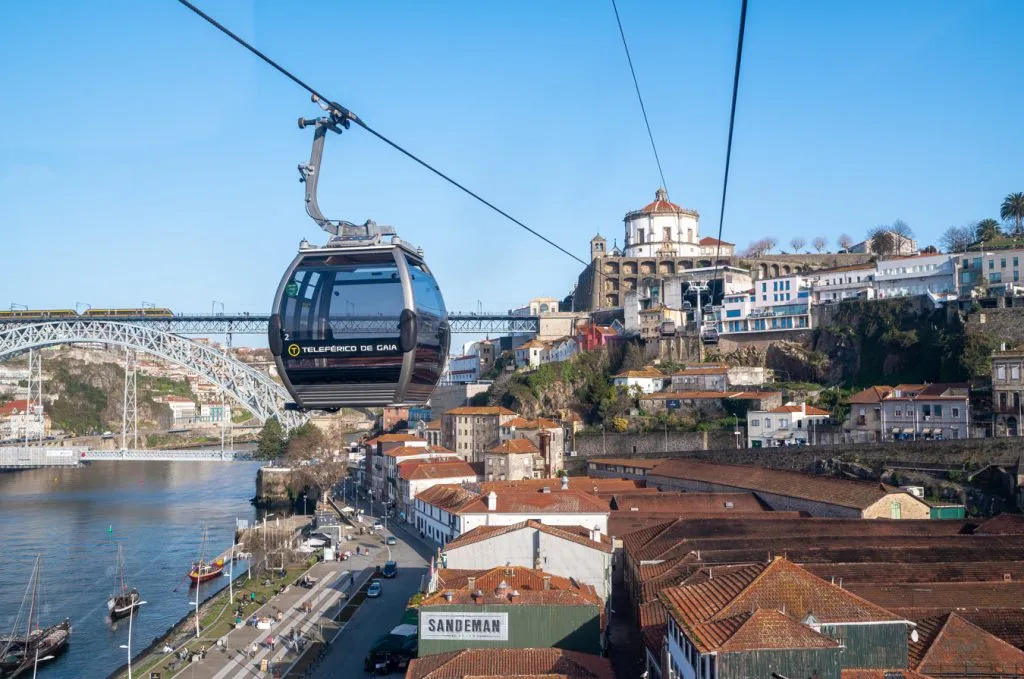
Day 14: Say goodbye to the Iberian Peninsula and head home.
As you come to the close of 14 (hopefully) perfect days spent exploring Portugal and Spain, there’s one more challenge ahead: getting home!
By far the simplest method for closing out this itinerary is to fly out of Porto, however, for many North Americans, there’s a chance that will be a less ideal option due to scheduling, price, or both (Porto’s airport is much smaller than Lisbon’s).
It’s worth considering, but most likely, you’ll want to head back to Lisbon either the night of day 13 or this morning in order to catch a flight home.
However you say goodbye, be sure to make time for at least one more pastel de nata as you bid adios and adeus to the Iberian Peninsula!

I mentioned this above, but it bears repeating here: while realistic, this itinerary is jam-packed, and one of the fastest-paced itineraries that we’ve published here on Our Escape Clause.
If you’re a traveler who loves to move fast, doesn’t mind changing hotels, and is hoping to see as much variety as possible on their Spain and Portugal vacation, you’ll love it (and be very excited to get home to your own bed afterward).
If you prefer a slower pace, or are enjoying 2 weeks in Spain and Portugal as part of an even longer adventure, you’ll likely want to slow it down a bit.
Here are a few good options for personalizing this itinerary.
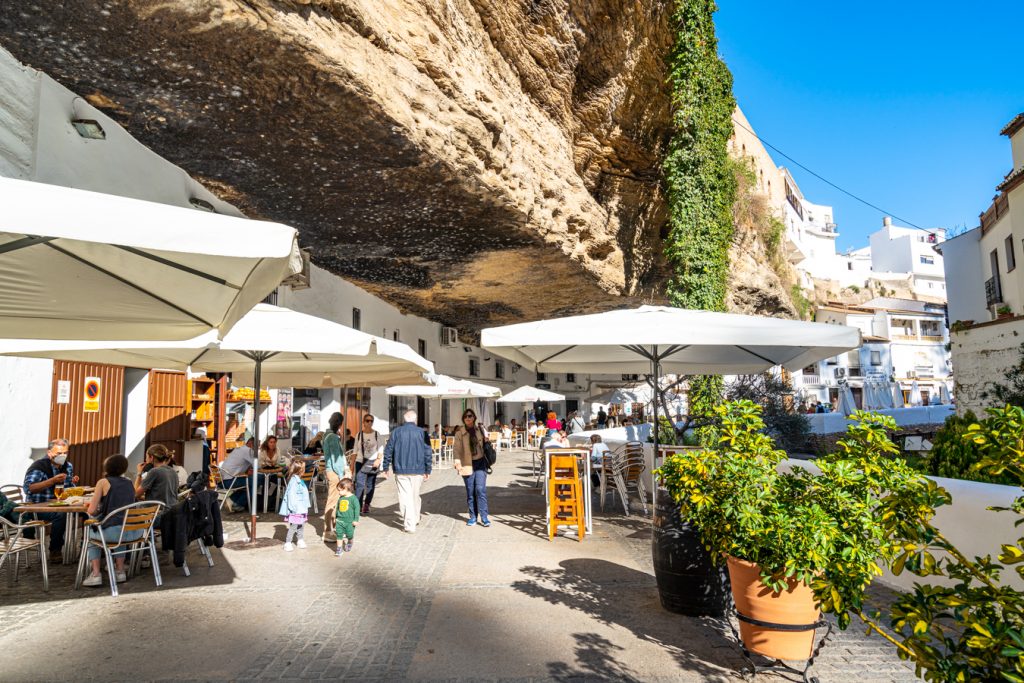
Skip Porto to spend longer in Lisbon and the Algarve.
I debated for a long time whether or not to include Porto in the original itinerary above, as it adds quite a bit of travel time!
However, Porto is a small city that can be thoroughly sampled in a day, and it’s a very different city from the other cities featured on this itinerary.
Plus, port!
However, while we definitely consider Porto well worth a visit, if you’re flying out of Lisbon and want to limit your train time toward the end of the trip (it’s about 3 hours each way by train), skipping northern Portugal is definitely a valid option.
If you decide to spend longer in Lisbon, you might even want to add on an easy additional day trip to see a different side of Portugal, such as to Cascais or Óbidos ( here are the best day trips from Lisbon ).
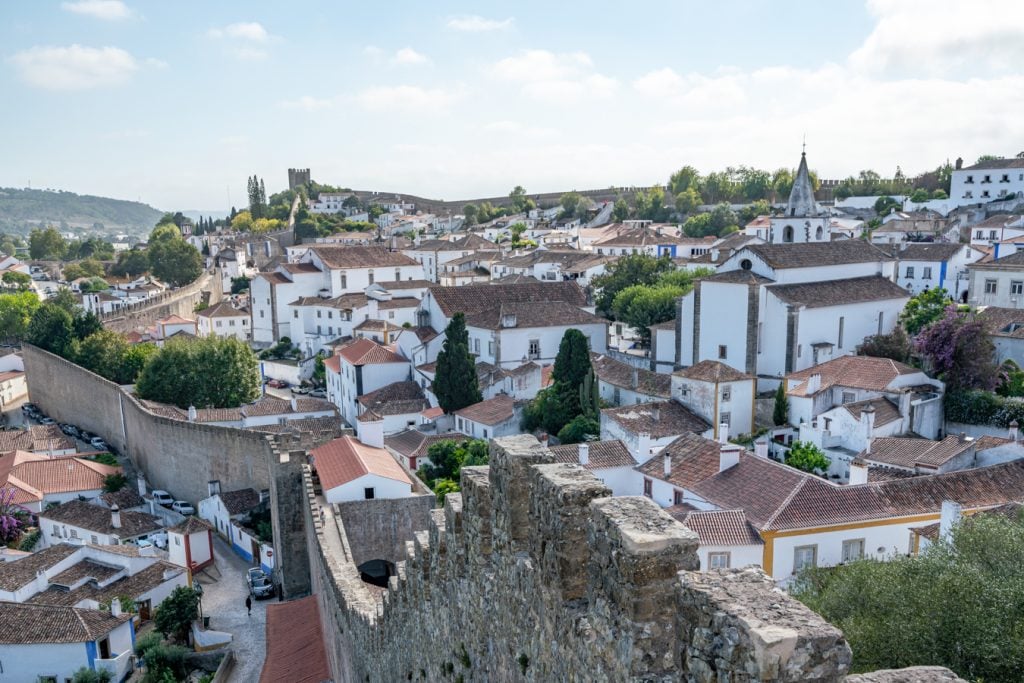
Start your itinerary in Seville.
While Barcelona is wonderful, there’s no doubt that you can cut your travel time significantly by flying straight to Seville to start your trip!
The downside of this route is that you’ll only see one region of Spain ( Andalucia ), but the upside is, you’ll move at a much slower pace.

Skip the Algarve and head right to Lisbon.
We decided to include the Algarve in this 14 day itinerary as it is not only beautiful and an incredibly fun place to visit, but a great change of pace from the more city-sightseeing-and-history-focused stops that make up most of the itinerary.
However, while swapping city streets for sandy beaches and seaside hikes is a wonderful addition to this trip, you can definitely save time by heading right from Seville to Lisbon.
If you’re more interested in cities than coastlines, or the weather isn’t cooperating for your trip, this might be a great option.
Visiting Cabo da Roca from Lisbon as part of your day trip to Sintra, or taking a day trip to Cascais , will also give you a small chance to appreciate the beauty of the Portuguese coastline offers without leaving the Lisbon area.
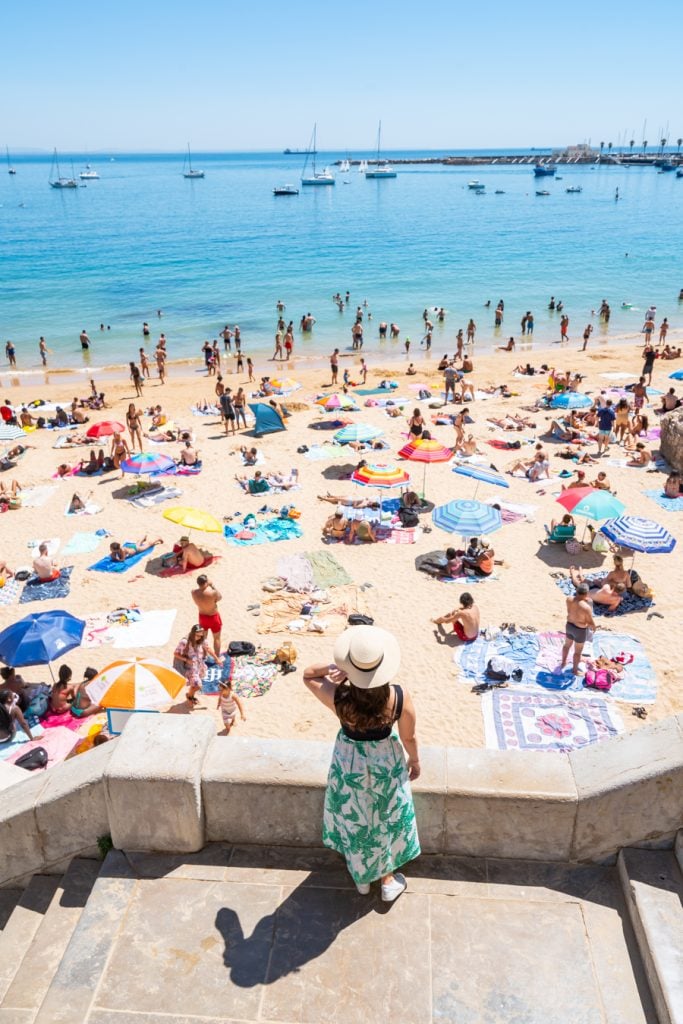
Swap Barcelona for Madrid.
This change isn’t a matter of timing, but of taste (and flight schedules).
We included Barcelona in this itinerary over Madrid as there’s only room for one of Spain’s two most famous cities, and Barcelona is both the most popular and arguably the most unique.
However, while Barcelona’s Gaudi architecture, Catalan culture, and seaside location are phenomenal, Madrid also has a lot to offer!
If you’re a big fan of art museums and royal palaces, you might prefer the Spanish capital ( our recommended Madrid itinerary is a great guide to what to expect).
Not sure which you’d prefer?
Let flight deals dictate which city you visit!

Spain and Portugal are both the definitions of year-round destinations, and that includes this Spain and Portugal itinerary!
That being said, though, if you have flexible dates and are trying to pinpoint the ideal time to travel Portugal and Spain, we recommend enjoying this itinerary in the spring or fall.
Summer in Spain in particular, especially in Andalucia, can be brutally hot (we shudder to think of visiting the Alhambra at noon in July).
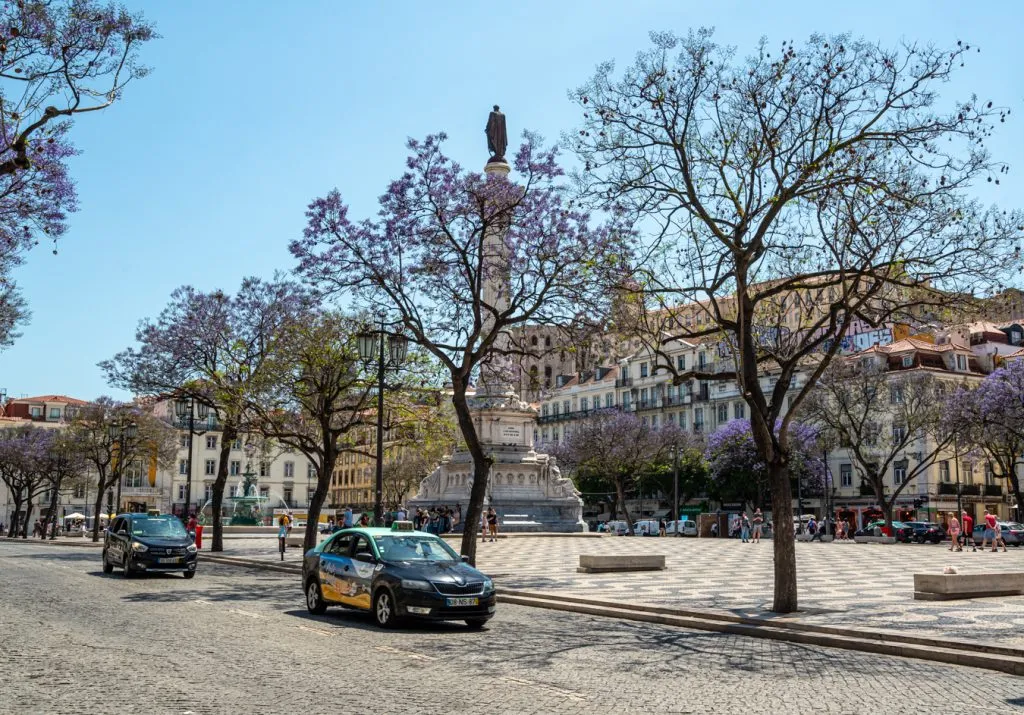
Winter is perfectly doable, but the weather can be rainy and less predictable than in spring or summer (it is, however, a fantastic time to go hiking in the Algarve, as long as you don’t mind skipping the swimming).
On the plus side for winter, though, you’ll experience few crowds, low prices, and still have a decent chance at soaking up some sunshine, albeit with a jacket at hand.
The sweet spot for this 14 day Spain and Portugal itinerary, though, which travels across a decent swath of both countries and therefore needs to take multiple climates into account, is the spring and fall.
We have spent time in both Portugal and Spain in every season, and while each trip was a delight, we have a special place in our hearts for the spring and fall!
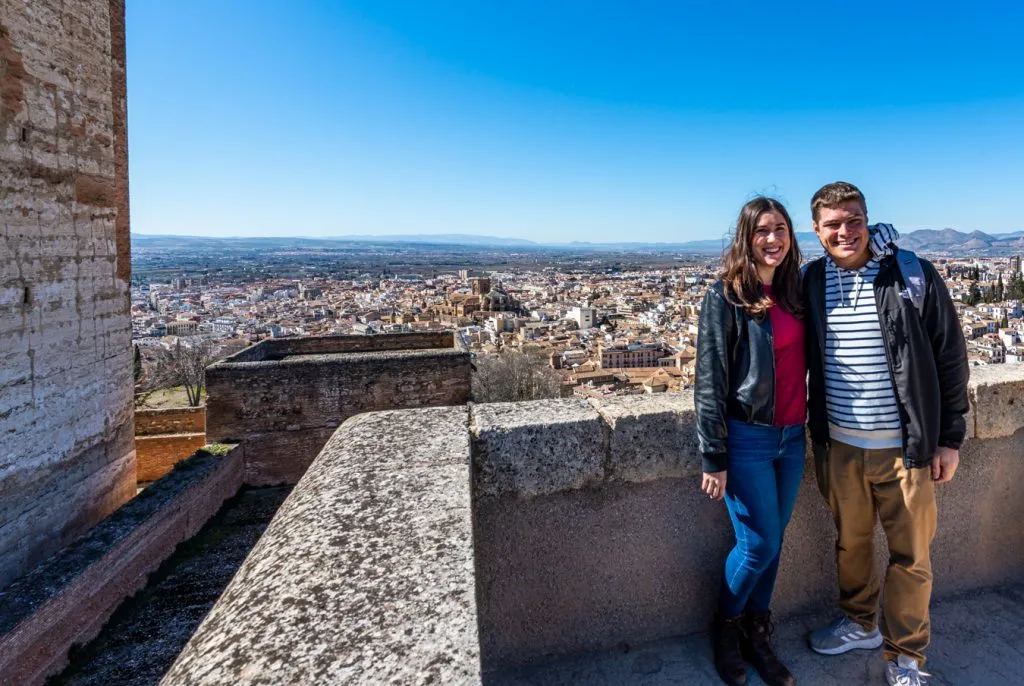
If you’re lucky enough to have more than 2 weeks in Spain and Portugal, you have a chance to do two things: first, add Madrid to this itinerary (it was very hard leaving it off!).
And, second, slow down as much as you can: every one of the destinations included in this itinerary has plenty more to see, and also boasts far more incredible day trip options than there is time to cover in 2 weeks.
A day trip to Toledo from Madrid , to Monserrat from Barcelona, to Ronda from Seville, to Cascais from Lisbon , or to the Douro Valley from Porto, just barely scratches the surface of the options out there!
For even more ideas, here are the best day trips from Lisbon , and here are the best day trips from Barcelona .
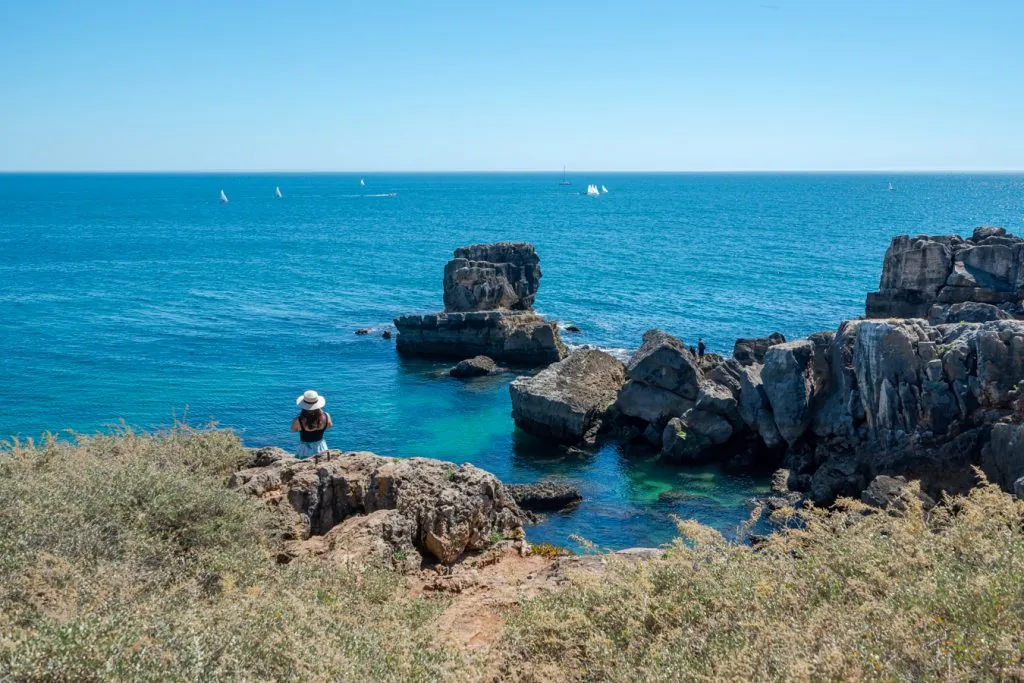
By adding day trips instead of overnights, you’ll be able to slow down the pace of travel and enjoy your trip even more.
If you have close to 3 weeks on the Iberian Peninsula, that’s when I would start to potentially consider adding on a Morocco leg, if that’s something you’re interested in.
As I mentioned at the beginning of the post, we’d recommend concentrating on the Sahara Desert , Marrakech and/or Fes, and if you have time, Chefchaouen and/or Essaouira.
Taking the ferry from Spain or Portugal to Tangier, Morocco, is a cool experience (though if you have a tendency toward seasickness like me–fair warning, it was also a nauseating experience), but Tangier is quite far from the most popular places to visit in Morocco.
Unless you’re particularly interested in traveling overland for its own sake, flying will likely make more sense, and there are tons of budget airline routes between Spain, Portugal, and Morocco.

Our detailed packing lists for visiting Europe in the spring , summer , fall , and winter cover just about everything you’ll need to bring on your 14 day Spain and Portugal vacation!
To get you started on your list, though, here are a few essentials to add to your packing list:
Travel Adaptors for Spain and Portugal — If you’re coming from outside of mainland Europe, you’ll definitely need adaptors for your electronics!
Spain and Portugal use the same plugs/voltage, so you won’t need anything different when moving between them.
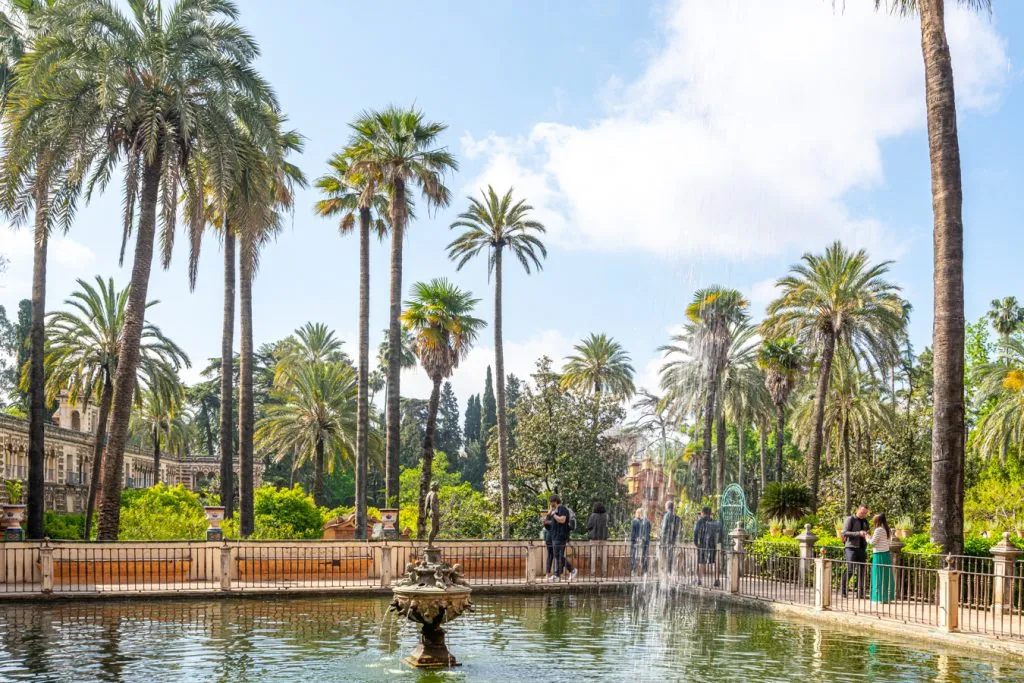
Travel Insurance — No one like to think about the possibility of canceled or interrupted trips, let alone accidents on the road.
Anything can happen while traveling, though–and that’s where travel insurance can help.
Check travel insurance policy inclusions and prices with Safety Wing for your trip here.
Camera — We completely adore our Sony a7R III , but whatever camera you’re comfortable with works–just make sure you have something with you to preserve your memories!
Comfortable Day Bag — We currently use Pacsafe’s sleek anti-theft backpack and love it, but if you don’t want to shell out the cash for this trip, that’s totally understandable.
Just aim for something comfortable to wear, not flashy, and medium-sized–we used a Northface Jester backpack for years and loved it as well.
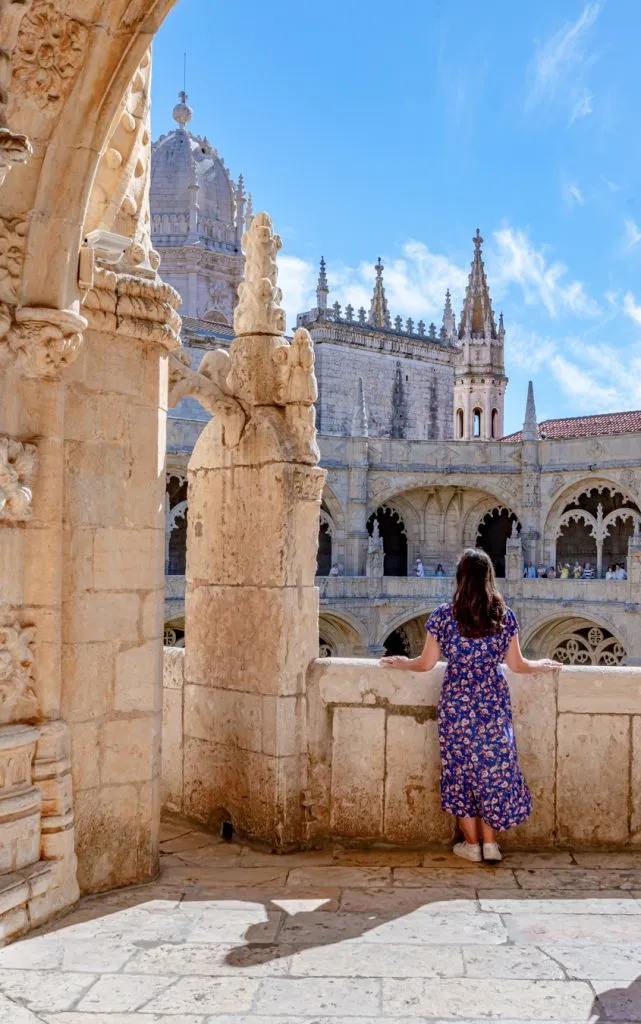
Sunglasses — The sun in Spain and Portugal is famous for a reason!
I find myself regularly reaching for sunglasses even in the winter when on the Iberian Peninsula.
Apple Air Tags — Air Tags are a relatively new addition to our packing list, but we’ve absolutely loved having the extra security when checking our luggage!
They’ll be coming with us from now on.
Reusable Water Bottle — Save both money and plastic during your 14 days in Spain and Portugal and add a reusable water bottle to your packing list for Europe! I love this metal one .
Portable USB Charger — Don’t stress about your phone dying while you’re sightseeing in Portugal and Spain: bring a USB charger along for the ride.

How many days do you need for Portugal and Spain?
Personally, we recommend visiting for a minimum of 2 weeks if you want to have a solid overview of both Spain and Portugal.
If you have less time to work with, consider sticking with fewer destinations, and perhaps sampling one city in each country instead.
Can you do Spain and Portugal on the same trip?
Yes, you can absolutely visit both Spain and Portugal on the same trip!
As next-door neighbors located in the far southwestern corner of Europe, Portugal and Spain make a great combination when planning a European vacation .

Is it possible to visit Spain and Portugal in 7 days?
Yes, you can visit both Spain and Portugal in 7 days–but don’t expect (or try) to see everything!
If you have a week in Spain and Portugal, we recommend picking one city in each country to focus on, with a possible day trip from each.
You’ll likely want to fly between the two countries in this scenario as well unless you happen to pick Lisbon and Seville, which are fairly close together (about 4.5 hours by car).
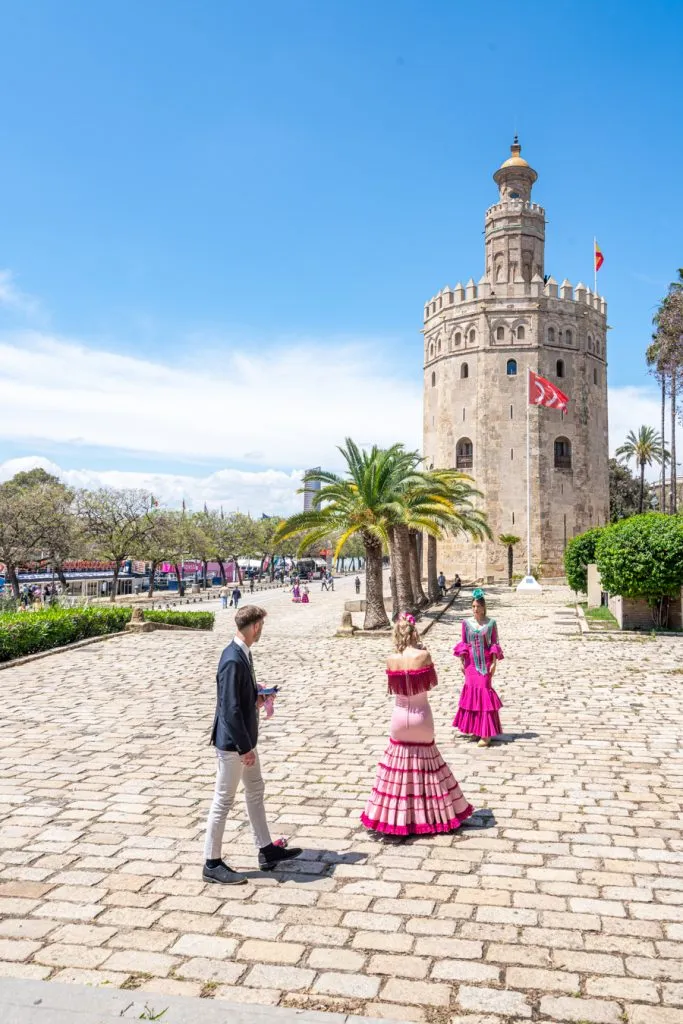
Can you drive a rental car from Spain to Portugal?
Typically, yes, you can drive rental cars between Spain and Portugal.
Be sure to confirm with your rental car company, though, and as always, make sure you tell them you plan to cross borders!
Can you rent a car in Spain and return it in Portugal (or vice versa)?
Yes, it’s technically possible to rent a car in one EU country and return it to another, but be prepared for an eye-watering fee for doing so!
One-way rental fees are almost always a bit pricey, but when it comes to crossing borders, it can get very expensive: we’ve been quoted around 1000 Euro (not a typo) more than once for the privilege.
If you plan to rent a car for your trip to Spain and Portugal, be sure to build extra fees into your budget… or just plan on returning it to the same country you picked it up in.
Check prices and shop rental cars for your Spain and Portugal road trip today!

Which is cheaper to visit, Spain or Portugal?
We go into this in a bit more detail in our Spain vs Portugal comparison post , but the basic answer is that while online resources and blog posts tend to state that Portugal is cheaper to visit than Spain, the reality on the ground is a bit more complex.
The cost of travel in Spain (and Portugal, for that matter) varies dramatically based on where you visit.
Barcelona, for example, clocks in as a pricey destination on par with Paris or Milan , while other regions like Andalucia can be far less expensive–including less expensive than popular places in Portugal’s Algarve.
Overall, from the perspective of planning a vacation, I would say that the Spain leg of this trip and the Portugal leg probably cost about the same, with the most expensive destination (Barcelona) being balanced out by Andalucia being among the more affordable stops.
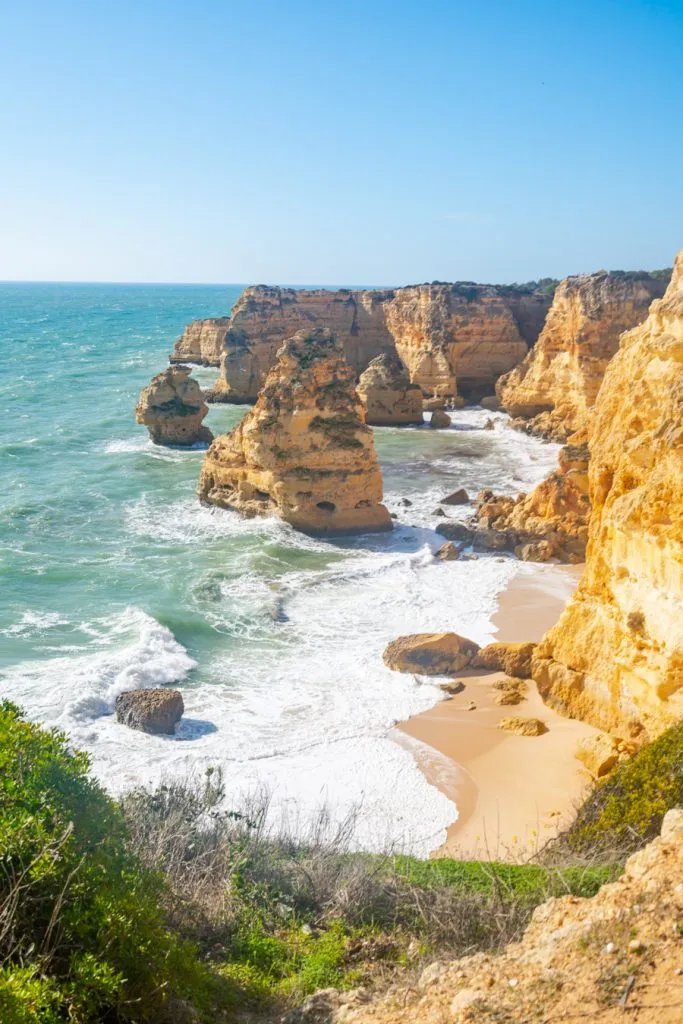
Can you take the train between Spain and Portugal?
Technically, you can take trains between Spain and Portugal… but for this trip, you probably won’t want to.
Spain and Portugal are not well-connected by train, and doing so requires going out of your way from most major tourist destinations (there’s a train from Porto to Vigo in the north, and alternatively, with multiple stops, you can cobble together a very long route through the center of Portugal into Spain).
Lisbon and Madrid used to be connected via a night train, but that was discontinued in 2020 and talk of bringing it back (or installing a high-speed rail) is stalled at rumor level indefinitely.
There are no trains connecting the Algarve to Andalucia.

Looking for more tips for visiting Spain and Portugal?
We’ve written about both countries extensively, with many more blog posts to come in the future!
You can scroll through all of our Portugal articles here , our Spain articles here , or check out these guides:
- The Ultimate 3 Days in Lisbon Itinerary
- Visiting the Alhambra in Granada: 21 Important Tips (FAQ + Tour Info!)
- 17 Best Things to Do in Lagos, Portugal (+ Nearby!)
- The Ultimate 3 Days in Madrid Itinerary
- How to Travel From Lisbon to Porto (By Train, Car, or Bus!)
- 19 Best Day Trips from Barcelona (+ How to Get There!)
Take This Map With You! Click each highlight to pull up the name of the destination. To save this map to “Your Places” on Google Maps, click the star to the right of the title. You’ll then be able to find it under the Maps tab of your Google Maps account! To open the map in a new window, click the button on the top right of the map.
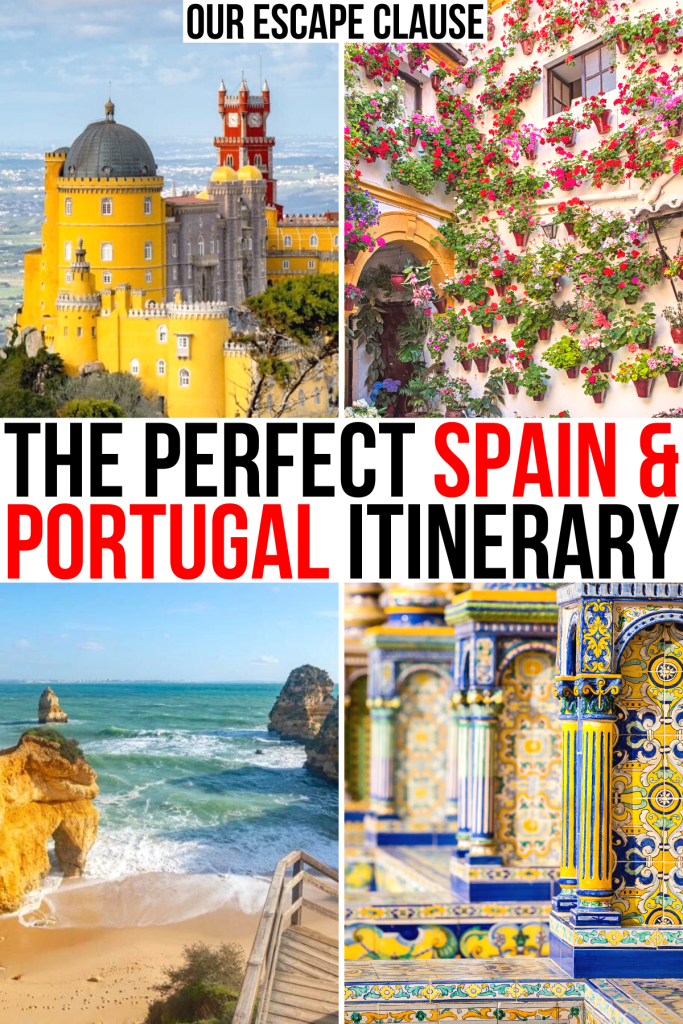
About Kate Storm

In May 2016, I left my suburban life in the USA and became a full-time traveler. Since then, I have visited 50+ countries on 5 continents and lived in Portugal, developing a special love of traveling in Europe (especially Italy) along the way. Today, along with my husband Jeremy and dog Ranger, I’m working toward my eventual goal of splitting my life between Europe and the USA.
9 thoughts on “The Perfect 2 Week Spain and Portugal Itinerary (+ Essential Tips!)”
This Spain and Portugal itinerary is a fantastic guide for planning my upcoming trip – it covers all the highlights I’ve been dreaming of! 🌍🌟
Thanks so much! Have a great trip. 🙂
Wonderful info in this guide. Planning our Portugal and Spain trip for April/May 2024 including 10 day Portuguese Camino de Santiago walk. I will be using lots of the tips you have included in this itinerary. Thank you.
Thanks so much, Glenda–hope your Camino is wonderful!
Hi. Thanks for the tips & advice. What’s the best way to visit sights in each city? Uber? And did you book your accommodation in each city in advance?
Within each city, a combination of walking, tram/metro, and occasional taxi or Uber is best–it depends on which city and which specific sites you’re trying to visit! We have written detailed itineraries on several of the included cities that break those steps down in more detail. For example, here’s one of our Lisbon itineraries: https://www.ourescapeclause.com/3-days-in-lisbon-itinerary/
We do recommend booking your accommodation in advance. Personally, we never choose to arrive in a city without knowing where we’re staying. 🙂
Any suggestions re: going “counter clockwise” from Barcelona to Lisbon? We’d like to catch San Sebastian/Bilbao and maybe part of the Camino on the way to Porto then head home from Lisbon (2-3 weeks). Thank you for sharing your great insight!
My understanding is that you’re wanting to cover Barcelona, San Sebastian/Bilbao, some of the Camino (we’ll call that 5-7 days), Porto, and Lisbon–but nowhere else on this itinerary.
If so, that’s doable over 3 weeks, though I’d consider trimming one stop (probably the Camino, as it’s a bit of a commitment even when doing a section) if you need to trim the trip down to 2 weeks.
You’ll also be in the lucky position of being able to take the train from Spain to Portugal, which is typically out of the question for most standard itineraries! There is a route from Vigo (you can connect there from Santiago de Compostela in Spain) to Porto that will get you across the border.
Great insight. Thank you!
Leave a Comment Cancel reply
- Travel Planning Guide
A Travel Price Comparison for Families, Couples, and Backpackers Spain vs. Portugal for Resorts, Beaches, Hiking, and Families

- Pros & Cons
- Museums & Attractions
- Culture & History
- Small Towns
- Scuba Diving & Snorkeling
- National Parks
- Adventure & Outdoor Activities
- Watersports
- Outdoor Activities
- Backpackers
- Transportation
- More time in Spain or Portugal?
- Which is Cheaper, Spain or Portugal?
- What are the cheapest places in Spain or Portugal?
- How can you save money in Spain or Portugal?
Should you visit Spain or Portugal?
Which is cheaper to visit which is more expensive for vacation.
Trying to figure out where to travel next? This travel comparison between Spain and Portugal can help. It includes a travel cost comparison in addition to other factors. For many travelers, the cost of a destination is a primary consideration when choosing where to go.
We'll start with a quick overview, and below we will go into all of the details.
Spain and Portugal are not just neighbors, they share a similar culture, history, and geography. Over the centuries they have evolved separately, yet together, as western European nations. Even though many visitors will say that they both have amazing beaches, stunning architecture, delicious Mediterranean cuisine, and warm weather, the discerning visitor will easily see the differences.
Spain is around five times the size of Portugal. So, it's often not fair to compare the two nations from a tourism perspective. Spain has more large cities, mountains, national parks, museums, and historical attractions. Spain also has more routes of the famous Camino de Santiago, more coastline, more tomato-throwing festivals, and more bulls that run after you. But when we take the overall influence that a country has on its visitors, Portugal represents itself well, too. With the charming culture found in the cities of Lisbon and Porto, along with the popular cultural regions of the Algarve and Alentejo, every type of traveler can find a place to explore and relax in this smaller country
Portugal is tied to the sea much more than Spain. As most of Portugal's country is close to the coastline, while Spain has more inland areas, Portugal has traditionally been a seafaring nation. For the modern traveler, this is most noticeably reflected in its cuisine which consists of plenty of seafood. Spain, on the other hand, has more land and agricultural-based food options. The two countries also share similar histories as they were once part of the Roman Empire and then experienced a strong Islamic influence from the Moors, only to be then re-taken by Catholic monarchies with a focus on exploration and imperialistic expansion. All of these cultural influences have left their mark in similar ways on the architecture, cuisine
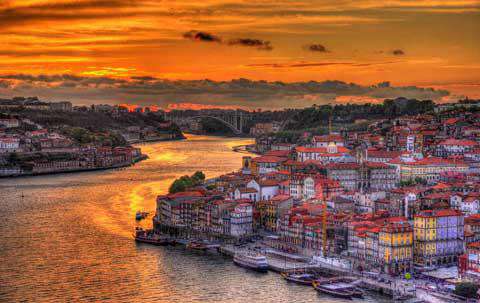
So, which country should you choose, Portugal or Spain? Well, why not both?
It might be easier to look at the practical side of travel to both of these countries to help you make a decision. Flights into Spain might be easier and cheaper simply because there are more options to choose from. Madrid, Barcelona, Seville, Malaga, Valencia, and Bilbao all have major airports with flights that connect to the rest of Europe, the U.S., and other regions of the world. On the other hand, Lisbon and Porto are not as well connected depending on where you live.
Once you're in Spain or Portugal, it's quite easy to get to the other country, too. Buses, trains, and flights from Lisbon to Madrid and back are quick and often very affordable. Flights between the two cities costs around $50 on a budget airline. Buses take around 12 hours, and also cost around the same price as a budget airline. The train can usually be cheaper (around $30), and takes about 10 hours. Keep in mind that if you have a rail pass, the prices for trains can be much cheaper, too.
Furthermore, many tour companies include Spain and Portugal together on their trips, if only because the two countries are next to each other. Many tour companies can give you a full overview of both countries in a week or two. Also, some companies offer specific types of tours, such as adventure tours, tours for those under 35, or culinary and food-focused tours.
G Adventures offers a tour that covers both Spain and Portugal at an affordable price over 10 days, plus longer tours, too.
Contiki specializes in tours for those under 35, and has a tour of both countries for 12 days , as well as other tours that also include Morocco and other European destinations.
If you must choose only one...
If you want a beach vacation where you can explore a small area, then Portugal is probably best for you. However, if you're looking to explore multiple large cities with historical attractions, then Spain might be more of your style. That being said, Spain has plenty of beaches, too. And Portugal has a few large urban areas with plenty of charm. While it's tough to make a final decision, perhaps price out a few options before deciding.
As one of the most popular tourist destinations in Europe, Spain has no shortage of places to explore and comfortable amenities for travelers. It's relatively affordable by Western European standards, but it is more expensive than nearby Portugal. Traveling around Spain is easy and efficient, particularly if you're traveling between major cities. There are train networks with high speed trains that connect most major cities in Spain, so despite it's large size, transportation is usually not a problem.
Spain is also an interesting country to visit because it's not hard to see the Arabic influence in the region. This is unique for a European country. Spain also has a vibrant nightlife scene and many lively festivals. Whether you're looking for a beautiful coastline, a historic town, or a cosmopolitan city with a vibrant nightlife, Spain really has it all.
Portugal is also easy to navigate for travelers. It has grown in popularity and has become a major tourist destination in Europe. The country is slightly more affordable than Spain, and it has a lot to offer all types of travelers. Portugal has a very diverse landscape that includes mountains, beaches, and desert-like settings. The country has vibrant cities like Lisbon and Porto, plus natural areas where you can enjoy a more peaceful setting. Portugal has a lot to offer, whether you're interested in hanging out on the beach, sipping some wine, or playing golf.

Spain is a friendly, diverse, and historic country. You'll find world class beauty here as well. Other popular activities here include museums, theater, adventure travel, and national parks.
From the popular coastlines to the rugged interior, Spain is full of history, natural beauty, vibrant people, amazing cities, unique cuisines, and gorgeous views. While Madrid is the capital, it's by no means the main attraction of a country full of beaches, ancient castles, and cultural diversity. Barcelona is the hub of the Catalan region with its own unique culture, and the southern areas have a deep historic relationship with Moorish culture, too. Visitors will also find epic hikes, world-class food, vineyards and wineries, epic nightlife, famous art, natural wildlife, multiple coastlines, cultural dances and music, friendly smiles, and affordable prices.

Portugal is a vibrant, charming, and captivating country. It's considered by many to be an absolutely beautiful destination, too. It's also popular because of the hiking, mountains, shopping, and museums.
At the western end of Europe, Portugal has a long history of exploration as well as beautiful countryside, gorgeous beaches, and fun cities. Lisbon and Porto are thriving cities with an active nightlife scene, museums, historic cathedrals, and terrific cuisine. And don't forget about the wine which you can enjoy in both the cities as well as in the vineyards of the countryside. In the south, the beautiful Algarve region has a unique coastal landscape with a mix of small towns and resort areas. Inland you'll find beautiful national parks with hiking, camping, and bicycling opportunities. And all along the coastline are small fishing villages along with larger towns rich in history and culture.
Spain and Portugal: Pros and Cons
- Popular museums and historical sights
- Great culture, history, and arts
- Good scuba and snorkeling destination
- Popular beach
- Good for hiking
- Beautiful national parks
- Great road trips
- Family-friendly
- Good for couples and romance
- Good for backpackers and budget travelers
- Impressive beauty
- Less hiking options
- Not as many national parks

How is Spain different from Portugal?
Which is better for a holiday.
Below we will examine the differences and similarities between Spain and Portugal. With this information, you can decide for yourself which place is better for your next trip.
Are the Museums and Historical Sights Better in Spain or Portugal?
You'll find a number of great museums and attractions in both Portugal and Spain .
You'll find a good number of museums and monuments packed into Spain . The major cities of Barcelona, Madrid, Seville, Granada, and others all have world-class museums that cover a variety of topics from history to art to science. Many of them are also family-friendly. In Barcelona, don't miss the Picasso museum dedicated to the famous artist. Casa Batllo is one of Gaudi's famous buildings and worth a tour along with Casa Vicens, too. MNAC is a great place to learn about the local Catalan art and history. And the Joan Miro museum is dedicated to the work and life of this famous artist. In Madrid, you can find plenty of historical places such as the Royal Palace and the National Archaeology Museum. If it's art you seek, make sure to visit the Prado, the Queen Sofia Arts Center, or the Thyssen-Bornemisza Museum, all of which have world-class art from Spain and Europe. In Valencia, kids will love the Oceanografic aquarium and the Bioparc zoo. In Seville, the Real Alcazar has fascinating architecture. and the Flemenco museum showcases Spain's most famous dance. This is just a small sample, as you'll find even more museums in Bilbao, Malaga, Granada, and other cities around the country, too.
Seville : This elegant city is filled with historic buildings and world famous architecture. From the iconic Catedral de Sevilla to the Real Alcázar and Plaza de España, there is an endless supply of world class sights around town.
Cordoba : The city is filled with monuments that reflect its past. The Great Mosque (La Mezquita) is one of the most iconic sights. You can also visit Alcázar de los Reyes Cristianos, Palacio de Viana, and Puente Romano.
Granada : Many visitors head to Granada specifically to visit the famed Alhambra. The palace and fortress complex will not disappoint. The gardens are beautifully maintained and the palace is filled with intricate details. It's easy to spend hours wandering around. In addition to The Alhambra, the Granada Cathedral is also impressive to visit. If you have kids or extra time to fill, head to Parque de las Ciencias, which is the city's Science Park.
Santiago de Compostela : The iconic Cathedral of Santiago has long attracted pilgrims and travelers from around Europe and the world. The spectacular sight includes a museum and the crypt and tomb of Saint James. Another interesting sight in town is the former hostel for pilgrims, the Hostal de los Reyes Católicos. Also make sure you visit Plaza del Obradoiro and the Galician Center of Contemporary Art.
See also Barcelona: The Ultimate Travel Planning Guide .
Visitors can fill many days exploring the museums and attractions around Portugal . The big cities and smaller towns both offer plenty of museums of all types, from art and history to science and family-friendly museums. In Lisbon, don't miss the National Azulejo Museum to see the history and art of these unique glazed tiles. MUDE teaches visitors all about design, while MAAT covers art, architecture, and technology in a way that feels like a modern art museum mixed with modern science. For a local musical experience, check out the Fado Museum, or for international history don't miss the Maritime Museum which is dedicated to the famous Portuguese explorers who set sail across the oceans. Dozens more are found around the city, too. In Porto, don't miss the Serralves Contemporary Art Museum, the Museum of the Holocaust, the Tram Museum, and the World of Wine. This last one is actually 5 different museums focusing on not just wine, but also the agricultural production of wine, cork, and chocolate and their impacts on Portuguese society and history. The Pink Palace is fun for kids and adults alike, as the theme is Rose Wine with a variety of humorous selfie spots. The Chocolate Museum is always a favorite, too. Finally, a variety of port and wine cellars are found on the riverfront which offer museum-like tour experiences to see where and how the wines are made. Elsewhere in Portugal, you should see the astronomical observatory near Monsaraz, the Universo de Memorias Joao Carlos Abreu in Funchal, and the Museu de Portimao.
Lisbon : World renowned landmarks include St. George's Castle, Jerónimos monastery, the Belém Tower, Santa Justa Lift, and countless world class museums.
Is Spain or Portugal Better for Culture, Arts, and History?
Spain and Portugal both offer a fairly similar amount of great history and culture for visitors.
Spain has many famous historic and cultural sights and attractions worth visiting, and is one of the main reasons why poeple come here. The blending of cultures in this region of Europe along with the accessibility of historic sights and cultural traditions make this country an obvious place to visit for history lovers. A long period of Spain's history was influenced by the Moors from the south, and you can see it in the architecture, art, cuisine, and music. Furthermore, the Catalan region in the east has it's own cultural differences. The Roman empire also left its mark, as did visitors from the rest of Europe and northern Africa. Some of the best historic places to see in Spain include the Alhambra palace and fortress in Granada, the huge cathedrals of Seville, Barcelona, and Madrid, El Escorial palace outside of Madrid, Montserrat Monastery near Barcelona, amongst others. Some of the best historical sites are actually the smaller castles and fortresses that are left from the long conflict between the Spanish and Moors that dot the countryside in the southern regions. Furthermore, Spain has made unique contributions of music, theater, and culture to the world stage. Flamenco dancing and Paso Double are just two of the musical art forms that are worth seeing on a smaller, intimate stage during a visit. And don't miss the world-class cuisine, too.
See also Barcelona: Activities, Tickets, and Things to Do , Things to Do in Madrid , and Cheap Tours and Activities in Granada, Spain .
Portugal is a terrific destination to visit for history, arts, and culture, as it has many sights worth visiting. You can see the deep and rich history around every corner, especially along the coastline where historic fishing villages, castles, and famous cities are found. Lisbon and Porto might be the largest cities with museums, fortresses, and historic homes, but plenty of other smaller towns have long history and unique culture, too. Sintra has a gorgeous castle, the Pena National Palace. Coimbra's historic library and university leaves visitors in awe. In Lisbon, check out Belem Tower and St. George’s Castle before wandering the old historic streets of the old town, dotted with churches and quaint viewpoints. Carmo Convent and Jeronimos Monastery are also two very popular sites that draw large crowds because of their beauty and rich history. In Porto, the Luis I bridge provides a great overview of everything before you visit the historic wine cellars, Porto Cathedral, and the narrow, weaving alleyways through the historic city center.
Is Spain or Portugal Better for Big City Activities?
Spain offers more big cities to explore than Portugal.
As Spain has many big cities, visitors will find plenty to do. Madrid and Barcelona are the two largest cities and most popular places to visit. Both have world-class museums, historical attractions, cathedrals, parks, shopping, restaurants and cafes, markets, and unique culture. Some of the other cities in Spain should not be overlooked either, as they also offer plenty of big city activities, museums, and culture. Valencia, Seville, Alicante, and Cadiz are also large and full of terrific activities.
Since Portugal has large cities, you'll find plenty of things to do. Lisbon and Porto are the largest cities in Portugal, and they each offer a unique atmosphere and vibe. Lisbon was built on seven hills, and you can find one of them topped with a castle overlooking the surrounding area. Much of the old town area is a winding path of streets made out of steps. Cathedrals, museums, restaurants, and a great transportation network are also mixed in. Porto is the wine capital and straddles the river Douro with high bridges and colorful houses. Check out the wine cellars and wine museums along with the historical sights.
Is Spain or Portugal Better for Small Towns and Villages?
Spain offers more villages and small towns to explore than Portugal.
Since Spain offers plenty of small towns and villages with a variety of activities, it attracts plenty of visitors, too. A few of the most popular small towns to visit include Ronda with its dramatic cliffs, Besalu and it's bridge and castle-like gate, Cudillero on the northern coast, and Morella with its castle. All around Spain visitors can find small towns that once contained fortified cities, fishing villages, monasteries, and more. Bunol, near Valencia, is the location of the famous annual tomato fight. And Pamplona is home to the running of the bulls every year. Benasque in the Pyrenees sits in a valley and offers plenty of outdoor activities. And don't miss the famous hanging houses of Cuenca. Frigiliana is full of white-washed Andalucian houses, along with other nearby towns worth visiting. Every region of Spain offers something unique and special, so make sure you add some of these places to your itinerary.
Portugal is a great destination to visit small towns and villages just waiting to be explored. In addition to the charming towns inland, almost the entire coastline is dotted with charming small towns, many of which were fishing villages in the past. While some of these costal towns have grown into modern beach resorts, others still have their historical charm with nearby churches, castles, and harbors. Many inland towns in the hills still retain their charm, especially those located in beautiful mountain areas. Some of the best places to visit are Sintra with its castle, Marvão in the Alentejo, Amarante in the north, Monsanto with its castle ruins, and Pinhão in the Douro River valley surrounded by vineyards.
Is Spain or Portugal Better for Theater?
Visitors will find great theaters and performances in Spain and Portugal .
You'll find a nice selection of shows in Spain . In Madrid, you can see plays and musicals at the Theatro Real Theatre and from the National Classical Theatre Company or the National Drama Centre. The Spanish National Ballet and the National Dance Company provide terrific opportunities to see world-class dance productions. Also, you can see Flamenco shows at small, intimate venues around Madrid and other cities, too. For example, in Barcelona you should try to catch a Flemenco show at Tablao Flamenco Cordobes which is one of the best venues in the country. Also in Barcelona, the Gran Teatre del Liceu is a large historic venue with a gorgeous interior that hosts a variety of productions. And don't miss the Palace of Catalan Music where you can listed to music from the region. Many other cities host terrific theater productions from the local culture as well as touring shows.
With some theater and performance venues, you might want to see a show in Portugal . In Lisbon, visitors can see popular Broadway-style plays, operas, musicals, concerts, and more. The most famous theaters include Campo Pequeno, Teatro Nacional Dona Maria II, Teatro Sao Charlos, and Teatro Maria Vitoria, among others. In Porto, you can take in a show or concert at the Casa da Musica and the Theatro Sa da Bandeira. Opera, orchestra concerts, ballet performances, and musicals are some of the most popular shows here, too.
Is the Food Better in Spain or Portugal? Which Country Has the Best Restaurants?
There are opportunities to sample the local cuisine at great restaurants in both Spain and Portugal .
Spain has a number of nationally recognized food spots and restaurants. Tapas are perhaps the most famous Spanish culinary export. These small sharable dishes started as something to snack on while drinking, and have transformed into a style of meal all their own. Typical tapas dishes include potatoes, sausages, stewed meats, calamari, olives, cheese, and more. But tapas are not the only local foods you should try. Chirizo is a special type of smoked sausage, and jamón Iberico is a smoked ham with tons of flavor. Calamares (rings of squid) are also popular around the costal areas, and are cooked with a variety methods. Anchovies and other seafood are popular, too. Paella is also famous. The name comes from the wide pan that the rice dish is served in, usually with seafood or meat and a variety of spices for flavoring. Finally, while in Spain, taste the local olives, bread, cheese, and fruit as they are all usually fresh and delicious.
Madrid : The city has a mix of flavors that come from all of Spain. There are amazing markets where you can grab a meal or snack. There are also many high quality restaurants around town where you're guaranteed a good meal. Local favorites include roast suckling pig, Spanish omelette, and meat and chickpea stew.
Valencia : The city is famous as the birthplace of paella, which is one of Spain's most famous dishes. Beyond the paella, there are a number of other amazing traditional dishes. Fideuà is similar to paella but made with noodles instead of rice. All i pebre is an eel and potato dish and clóchinas are tiny local mussels. For dessert make sure you try the flan de calabaza, which is pumpkin flavored. Many restaurants also have tapas that can be shared. Restaurants in the old town are charming and delicious, but out by the beaches the quality isn't as good.
San Sebastian : It is a famed culinary capital of not just Spain, but the entire world. The city has many Michelin-starred restaurants where you can experience modern or traditional recipes prepared by world class chefs. There are also pintxo bars, food markets, and gourmet food shops, that sell local ingredients and dishes. Much of the cuisine includes seafood, but you'll also find a local twist on traditional tapas. Dining is a true experience in this town.
Almeria : The food is focused on local, fresh ingredients with many traditional recipes that have been passed down for centuries. Popular dishes change with the seasons because they rely so heavily on local produce. Particularly during the winter months you'll find hearty stews like patatas en ajopollo and gurullos con conejo, which is prepared with rabbit. Sardines are also popular year round.
See also Food and Dining in Madrid , Delicious Tapas Tours in Madrid , and The Best Cheap Food Tours in Madrid .
With its innovative style combined with traditional elements, Portugal makes for a great culinary experience. As a coastal nation, seafood here is fantastic, but it's not the only type of cuisine available. Popular traditional dishes begin with the small but famous custard tart known as Pastel de Nata. It's easy to get them at bakeries and street vendors. If fish is what you're after, try the bacalhau (salted cod), or any of the other terrific cod dishes such as a bras where it is mixed in with potatoes and eggs in a casserole. It's also popular to have cod (or other fish) fried, sautéed, or boiled along with potatoes and other veggies. Octopus is another favorite which you should try, as it's usually boiled or steamed and served with olive oil and potatoes. If you seek land food, try the Iberian black pork, the duck rice, or the Francesinha , which is a meat and cheese sandwich with an interesting variety of ham and pork. In addition to the traditional dishes, you'll find plenty of other European cuisines in restaurants around the nation, as well as global dishes. So, there's something for everyone. The local breads and cheeses are terrific, and it's quite easy to grab a breakfast at a local bakery or sit down for an affordable, casual, and delicious meal almost anywhere in Portugal.
Lisbon : There are many local restaurants as well as food tours and cooking classes that you can enjoy. Make sure you try the local favorites like bacalhau à brás, frango no churrasco, and pastel de nata. Given the beautiful climate, outdoor seating is also popular. Head into the less touristy neighborhoods to try some local dishes or hit up a seafood market. There are also many cafes that offer great breakfasts with fresh ingredients.
Porto : The area's cuisine combines the ocean setting with the agriculture of the surrounding area, so you'll enjoy both seafood dishes as well as fresh meats and vegetables. The area is also famous for its Port wines and red wines. There are plenty of cellar tours as well was waterfront seafood restaurants to choose from.
Is Spain or Portugal Better for Nightlife?
Both Spain and Portugal have great vibes after the sun sets.
Spain has a lively atmosphere and nightlife is popular here. Barcelona, Madrid, Granada, Seville, Malaga, Valencia, and many other beach resort towns all have active nightlife scenes, each with their own personality. Barcelona is very popular with all types of bars and dance clubs for locals and travelers alike. Sidecar, Opium, and Pacha are some of the most popular places, and many more can be found in Raval, El Born, and the Gothic Quarter. In Madrid, check out Kapital, Barbara Ann, or Ochoymedio. Along the coast, the nightlife varies from family-friendly restaurants and theaters to more active dance clubs, pubs, and bars for singles and younger couples.
Barcelona : The city offers an amazing nightlife at a much more affordable price than many places in Europe. There are beach parties, boat parties, and bars that stay packed late into the night. The city also hosts many street fiestas and music festivals.
Valencia : Dinner starts late, so you can expect the nightlife to pick up even later. During the summer there are all night terrace parties and year round you'll find nightclubs filled from evening to dawn. If all night raves aren't really your thing, you'll also find plenty of local bars where you can hang out with friends in a more relaxed setting. The nightlife scene really is varied enough that there's something for everyone.
Malaga : The city has some of the most active nightlife in Europe. There are plenty of opportunities to party in Malaga and you'll find the most vibrant nightlife in the Centro Historico.
Palma de Mallorca : Head to Magaluf and Palma for the most popular places.
Marbella : European tourists flock to the town for its beaches and resorts. The town has a glamorous nightlife scene with exclusive clubs and ritzy cocktail bars, particularly in Puerto Banus and along the Golden Mile.
See also Barcelona Nightlife , The Best Nightlife in Madrid , and Party Hostels in Barcelona .
The people in Portugal know how to have a good time. Lisbon and Porto both have very active nightlife scenes. In Lisbon, the city center is full of bars and nightclubs that come alive after the crowds enjoy dinner at a variety of restaurants and cafes. Theater productions are also popular in Lisbon. In Porto, you'll find plenty of activities centered around wine and port, naturally. Also, the city center here has a large number of bars and dance clubs. The downtown area of Porto has seen a significant resurgence of bars and clubs at night in recent years. Other smaller cities, especially around resort areas, can have a vibrant nightlife scene, especially during the busy summer months.
Lisbon : It is a bustling city with a lot of energy late into the night. There are countless bars, clubs, and music venues that cater to every personality type and style. Whether you want a more relaxed vibe or a raging party, there is likely an place for you.
Albufeira : It's probably the most infamous party destination in the Algarve and it won't disappoint. During the peak summer months you'll find the streets around the popular "Strip" filled with tourists and party-goers. There are hen and stag parties, backpackers, and drunken travelers out for a good time. The Strip has become so popular that there are now bars and clubs on the adjacent streets as well. If you're not staying in the area, you'll likely want to take a taxi, as it's a couple kilometers outside of the town center.
See also Lisbon Party Hostels , Beach & Party Hostels in Albufeira, Portugal , and Party Hostels in Peniche, Portugal near the Beach .
Is Spain or Portugal Better for Resorts?
Spain generally brings in more resort visitors than Portugal.
If you're looking for a fantastic resort destination, Spain is a perfect choice. A holiday trip to Spain for many means a trip to one of the beach resorts along the southern coast, or in Ibiza or Majorca. Marbella, Cadiz, Valencia, Sitges, Alicante, and even Barcelona are all popular destinations with a variety of luxury hotels and resorts. Many are very family-friendly, and some are all-inclusive. Generically, the resorts offer terrific beaches and many are close to nearby towns, as well as some historical and cultural attractions. But no matter where you choose to go, the beach resorts in Spain are world-class and draw plenty of visitors every year. Also, keep in mind that Spain offers a handful of ski resorts open in the winter months, as well as some relaxing inland retreats outside of major cities and historical areas.
Almeria : Stretched along the coastline you'll find many high end resorts with pools and nice atmospheres. There are all inclusive resorts as well as family-friendly and romantic options to choose from.
Marbella : From luxury to family-friendly, this area has plenty of resorts to choose from. Popular resorts in the area include Marbella Club Hotel, Puente Romano Marbella, and Don Carlos Resort and Spa.
There are plenty of resorts in Portugal to choose from. With such a long stretch of coastline, beach resorts are very common. Towns in the Algarve such as Portimao and Albufiera have smaller hotels, but if you travel out of the towns along the coastline you'll find larger beach resorts, some of which are all-inclusive. The same can be said for the smaller towns on the Atlantic coast, where historic fishing villages are mingled with larger resort properties. While some of these larger resorts are adult-only, most are family-friendly, and a range of prices and luxury is offered.
Faro : Popular resorts include Vila Vita Parc Resort and Spa, Conrad Algarve, and Tivoli Carvoeiro.
Portimao : The area has all types of resorts, from all-inclusive options to luxury or more family-friendly. Many of the resorts are surprisingly affordable and offer easy access to the beach.
Lagos : As a resort town, you'll find no shortage of places to stay in the area. If you don't have a car, your best options are in the historic center. If transportation isn't a concern, then you'll find plenty of great resorts in the Marina, Meia Praia, Dona Ana Beach, Camilo Beach, and Porto de Mós Beach.
Is Spain or Portugal Better for Scuba Diving and Snorkeling?
Both Spain and Portugal offer great scuba diving or snorkeling.
It's fun to get in the water and check out the local marine life in Spain . While the southern coast of the mainland provides plenty of great dive spots with clear waters and a good selection of marine life, the crown jewels of diving are in the Canary Islands, and the Balearic Islands. Here you'll find even better opportunities to see marine wildlife in more ideal conditions. You can see barracuda, octopus, moray, a variety of large fish species, and more. Also, diving in the Canary islands can be done year-round, where as in the Mediterranean, only during the warmer months. If you're looking for a quicker trip, it's also possible to dive or snorkel off the Costa Brava coastline near Barcelona where a variety of interesting species can be found in the usually clear waters.
Marbella : There are more than 100 dive sights and endless snorkeling opportunities in the area. There are deep offshore reefs that you can explore as well as shallower wrecks and caves.
Grab a mask and fins and explore the underwater scenery in Portugal . The Azores are an island chain to the west of Portugal in the Atlantic, and here visitors will have much better diving and snorkeling experiences. This is generally considered to be one of the best diving regions of Europe. Near Santa Maria Island, for example, divers can see manta rays, tuna, barracudas, and amberjack. The waters are clear and provide excellent visibility. Also, the Madeira Islands are part of Portugal and can be found to the west of Morocco. A number of terrific dive locations can be found here, too, such as those near Funchal. The Algarve coastline offers pretty good visibility in its clear waters, and a variety of dive shops provide boat trips out into the waters during the warmer months. Many spots have wrecks which are worth visiting, too. Some fish and wildlife can be seen in the shallower areas located a bit off of the shoreline. The cities of Lagos, Portimao, and Albufiera have dive centers.
Is Spain or Portugal Better for Beaches?
Both Spain and Portugal are considered to be great beach destinations.
Spain is considered to be a world-class beach destination. The beaches in Spain are world-class, popular, and extensive. With a huge stretch of coastline on the Mediterranean and the Atlantic, as well as famous islands such as Ibiza and Mallorca. The coastline of Andalusia and Valencia are perhaps the most visited, as tourists from all of Europe, and all of the world, come here for holiday beach vacations in Spain. Good food, sunny warm weather, wide sandy beaches, and family-friendly amenities are found up and down the coast. Some areas are more party-oriented, while others offer a calm, relaxing vibe, or family-friendly activities. Some of the best and most popular beach destinations in southern Spain include Tossa de Mar in Costa Brava, Puerto Banus near Marbella, Bogatell in Barcelona, Almunecar in Costa Tropical, and the beaches of Cadiz, amongst others. You can't go wrong with any of them.
Palma de Mallorca : The island is lined with sandy beaches and rocky coves, which have contributed to it becoming one of Europe's most popular beach destinations.
Almeria : Outside of town you'll find kilometers of stunning coastline and beaches. There are pristine natural beaches that still feel undiscovered with beautiful long stretches of sand. One of the biggest resort areas is Roquetas de Mar.
Marbella : The area boasts some of the best beaches in Europe. They are hubs of activity with lots of energy, and there are more than 18 miles of sandy beach in the area. Popular options include Guadalmina Beach, San Pedro de Alcántara Beach, and Nueva Andalucía Beach.
Portugal offers stunning beaches that attract visitors from around the world. With a huge stretch of coastline, you'll find plenty of fantastic beaches both on the Atlantic coast and the southern Algarve coast. Furthermore, the Azores and Madeira Islands are part Portugal, too, and offer even more terrific beach resort areas. The coastal landscapes are diverse and beautiful. The southern coast around Lagos, Portimao, and Albufiera has beautiful sea cliffs with unique beach coves. Along the Atlantic coast you'll find rocky hills and wide sandy beaches, such as in Praia da Adraga near Sintra or Praia de São Bernardino in Peniche. This seafaring nation has so many great beaches and something for everyone.
Portimao : The stunning beaches are a major draw to the area. They are sandy and feature a backdrop of dramatic red cliffs. The most popular beach in town is Praia da Rocha, which can get crowded during the summer months, but it is quite large so you should still be able to find a spot. The strip behind the beach is lined with shops, bars, restaurants, and a casino. If you want to avoid some of the crowds you can make the walk down to Praia do Vau. Families often enjoy Praia de Alvor, which has a boardwalk that leads to Ria de Alvor nature reserve.
Lagos : The beaches are long, flat and sandy with beautifully dramatic rock formations. The largest beach in the area is Meia Praia and arguably one of the best beaches is Praia Dona Ana. For convenience, Praia da Batata is the closest beach to town. Praia de Porto de Mós is one of the more quiet beaches, but it's still along a bus line. For beautiful nature head to either Praia dos Estudantes or Praia dos Pinheiros.
Albufeira : With their golden sands and blue waters, the beaches are world class. The area also has a diversity of beaches that are perfect for all types of vacationers. For water sports, head to Praia dos Alemaes but for relaxation and catching some rays check out Praia da Falesia. You'll find some interesting rock formations at Praia dos Olhos de Agua. One of the most convenient beaches to town is Praia dos Pescadores. For nightlife you'll want to head to Praia da Oura.
See also The 10 Best Algarve Beaches .
Is the Shopping Better in Spain or Portugal?
Shoppers can find a variety of great stores in both Spain and Portugal .
Spain has a variety of shopping areas worth visiting. In Barcelona, visitors can find plenty of great areas with fashion boutiques, local arts and crafts, and souvenirs. Check out Portal De L'Angel in the Gothic Quarter, Paseo de Gràcia with its high-end stores, Avenida Diagonal for its diversity of shops, and the famous Boqueria Market where you'll find fresh food and other surprises. In Madrid, don't miss Gran Via, Calle Preciados, Calle de Fuencarral, or the historic El Rastro flea market where you can find plenty of hidden gems. Elsewhere in Spain, most beach resort areas have shopping streets, and the larger towns such as Valencia, Malaga, and Marbella have multiple shopping neighborhoods. In Granada and Seville, it's also possible to find those special local arts and craft shops for the perfect gift or souvenir.
Madrid : Gran Vía is a main thoroughfare in Madrid that is also popular for shopping. Calle Fuencarral is where you'll find the fashion shops and Calle Preciados is a fun pedestrian area to explore.
Barcelona : Head to Portal De L'Angel, Rambla de Catalunya, or Passeig De Gracia for some of the city's best shopping districts.
Marbella : This area attracts vacationers from around Europe and the shopping is some of the best in Europe.
Portugal is a great destination for shopping. Lisbon and Porto both have a variety of shopping neighborhoods as well as malls and street markets. In Lisbon, you can find plenty of shops on the Avenida da Liberdade and the Chiado area. The Feira da Ladra is the best antique and flea market in the city, and is worth browsing through even if you're not planning to buy anything. In Porto, you'll find plenty of shopping along the streets in the historic center and downtown streets on the north side of the river, and more touristy shops on the south side of the river near the wine cellars. Rua de Santa Catarina has plenty of fashion boutiques, while the Mercado do Bolhão has a mix of food, souviniers, crafts, and more. Elsewhere in Portugal, smaller cities and towns will often have main shopping streets, and the beach resort cities will sometimes have fashion boutiques and local craft shops.
Lisbon : For high end shopping, head to The Avenida da Liberdade. It's lined with designer brands and luxury boutiques.
Is Spain or Portugal Better for Hiking?
Most people pick Spain for the hiking over Portugal.
Many people visit Spain specifically for its hiking. The Camino de Santiago is Spain's most famous hiking route. Also known as the Way of St. James, this historic 500 mile-long pilgrimage route stretches across the entire width of Spain and also has numerous secondary paths. Hikers come from around the world to trek the entire length or just a small portion of the trail which ends at the cathedral in Santiago de Compostela in the northwest. Additionally, you'll find plenty of other hiking opportunities in the Pyrenees mountains, the various national parks, or even in the Canary islands or Mallorca. Also, the Caminito del Rey has amazing trails along cliffs near Malaga. From Barcelona, it's easy to reach the base of Montserrat, where you can hike up to the monastery instead of taking the cable car, or hike on the higher up trails as well. Sierra Nevada national park, near Granada, also offers plenty of hiking trails that are close to a major city. And in the Costa Brava region up the coast from Barcelona, even more gorgeous trails have great views of the landscapes and Mediterranean Sea. Generally, no matter where you visit in this country, you can find some great trails.
Santiago de Compostela : This small city is the culmination point for the famed Camino de Santiago. The 780 kilometer route is followed by pilgrims and travelers who seek enlightenment or adventure. Hikers travel both independently or as part of organized tours.
Tenerife : The island's volcanic landscapes mean that there are dramatic and breathtaking hikes throughout the island. Some of the best hikes are found in the Anaga Rural Park, Teide National Park, and the Teno Mountains.
Portugal offers some nice hiking trails. Hiking trails are found all over the country, along the coastline and in the mountains in the interior. Hiking along the coast in the Algarve is a unique experience, especially along the Seven Hanging Valleys trail where you'll take on the sea cliffs, caves, and the small coves. Near Lisbon in Sintra-Cascais Natural Park, you can't miss the trail from Cabo da Roca to Azenhas do Mar where you'll see gorgeous beaches, old houses on the hills, and beautiful landscapes. The Serra do Topo trail in the Azores takes you through steep green hills overlooking the ocean, and it's breathtaking. Inland, the Covao dos Conchos trail is found in Serra da Estrela natural park, and here you'll experience scenic mountain vistas.
Is Spain or Portugal Better for its National Parks?
Most people pick Spain for its national parks over Portugal.
Many visitors go to Spain to see the national parks. With sixteen national parks and a variety of other natural parks and wilderness protection areas, visitors are offered a diverse set of natural destinations to explore. Some are in the mountains, some at the coast, and others are found in unique ecosystems. Some of the most popular include Cabañeros in the mountains of Toledo, Guadarrama near Madrid, and Illas Atlánticas de Galicia near A Coruna on the northern coast. Several national parks are found on the Canary Islands and make the trip there even more interesting if you have the time. In many of Spain's national parks, you'll find hiking, camping, horseback riding, adventure sports, and beautiful views.
Portugal is a good destination to visit the national parks. While it technically has only one national park, Portugal has a large number of Natural and Nature parks to protect scenic areas and native wildlife. Douro International Natural Park, at the border with Spain, has epic mountainous landscapes as the winding river cuts through deep canyons. On the other hand Ria Formosa Natural Park offers a wide stretch of beautiful coastline to explore. Serra da Estrela is in the mountains, and has hiking trails and great views over the stunning landscapes. Southwest Alentejo and Vicenti Coast is part of the Algarve. It has stunning cliffs, nice beaches, and plenty of outdoor activities. Peneda-Geres National Park is another mountainous park with hiking trails and a unique ecosystem.
Is Spain or Portugal Better for Adventure Travel?
Spain generally offers more adventure travel options for travelers than Portugal.
Spain is an extremely popular destination for those interested in adventure travel. From the mountains to the coastline, visitors can experience bungee jumping, mountain biking, paragliding, zip-lines, ropes courses, rock climbing, canyoning, whitewater rafting, and more. The coast also offers surfing, kite surfing, wind surfing, scuba diving, and boating. It's possible to find these activities all around the country, usually in the countryside not far from major cities.
Portugal has some adventurous travel experiences that often attract visitors. Along the coast, surfing is very popular, as some areas of the Atlantic coast have massive waves. Kite surfing and wind surfing are also popular in many areas, too. Inland, you can find mountain biking trails, zip lines and ropes courses, bungee jumping from high bridges, kayaking in the rivers and along the coast, just to name a few. Rock climbing and canyoning area also popular as the landscape offers plenty of great opportunities. Horseback riding along the coast or in the mountains is also a popular way to see the gorgeous landscapes, too. Adventure seekers can find exciting activities almost anywhere in Portugal.
Is Spain or Portugal Better for Visiting the Mountains?
Both Spain and Portugal have some great mountain areas to explore.
Visiting the mountains in Spain is a very popular activity. The Pyrenees are the largest mountain chain in the country, making a divide between Spain and France. Here you'll find epic views, hiking, camping, wildlife viewing, mountain biking, ski resorts, and more. Elsewhere in Spain you can find plenty of other mountains, as the inland is quite varied. The Sierra Nevada mountains in the south are some of the most beautiful, and are also easily accessible. Across northern Andalusia, you can find even more mountains north of Seville and Cordoba, with several national parks and wilderness areas. In all of these places you'll find natural beauty, wildlife, horseback riding, hiking, camping, and even paragliding. And don't miss the Canary Islands, where you'll find even more great activities. Tenerife is the largest island and offers gorgeous mountain views, native wildlife, and an exotic, tropical atmosphere. Spain absolutely has some gorgeous mountains worth visiting.
Portugal has some beautiful mountain areas that attract visitors. The interior of the country has plenty of mountain ranges for those looking to explore. Many of the natural park areas are found in the mountains as well, and offer hiking, camping, horseback riding, cozy cabins, and more. The Serra da Estrela range is where you'll find the nation's highest peak as well as a unique ecosystem, a large network of trails (Trilhos Verdes), and beautiful valleys. You'll also find quaint mountain villages with hotels and restaurants where you can relax. Other mountain ranges worth visiting include the Montanhas Magicas (Magic Mountains), the Serra da Freita, and the Montemuro range.
Is Spain or Portugal Better for Watersports?
Overall, Portugal is considered to offer more watersports activities and attractions to visitors.
The huge number of watersports activities in Portugal is one of the main reasons people come to visit. Surfing is very popular all along the coast. In some areas of the Atlantic coast, you can find some of the largest waves in the world. Kite surfing and wind surfing are also popular, as is kayaking, canoeing, and boating both on the coast and inland on the rivers. The Algarve region in the south is especially popular with kayakers who wish to explore the unique sea caves and cliffs, such as those at Benegil. Scuba diving and snorkeling is also popular in some areas along the southern coast, too.
The watersports in Spain attract many visitors. With a huge length of coastline both on the southern Mediterranean shore and the northern Atlantic shore, water sports in all forms can be found here. Surfing is very popular on both coasts, as wake boarding, kite surfing, and wind surfing. It's also easy to rent kayaks or canoes both on the coastline or in the rivers and lakes of the interior. Scuba diving and snorkeling are popular along the coast, as well as in the Canary Islands and around Ibiza and Majorca. The beaches and clear waters of these island paradises attract plenty of water bound tourists for a good reason. If you're interested in doing more at the beach than just laying on the sand, Spain is the place for you.
Is Spain or Portugal Better for Outdoor Activities?
Overall, Portugal is considered to offer more outdoor activities and attractions to visitors.
The huge number of outdoor activities in Portugal is one of the main reasons people come to visit. With a mix of coastline and mountains, visitors will find a diverse array of options here. Hiking and camping in the natural parks is very popular because the mountains offer great views, river valleys, and unique ecosystems. Zip-lining and ropes courses are found throughout the country, and rock climbing or bouldering are commonplace, too. Horseback riding through the mountains or on the beach is also a fun activity, especially for couples. For those looking for something more relaxed, you can take a walk through the vineyards or a jeep tour around the mountain regions.
The outdoor activities and experiences of Spain attract many visitors. Popular outdoor activities here include camping, hiking, horseback riding, rock climbing, mountain biking, and more. Canyoning is popular, especially in the Pyrenees. The Sierra de Guara is one of the most popular spots for this, located outside of Zaragoza. Or, try rock climbing in Andalucía where you'll find a variety of spots not far from Malaga, Cordoba, and Granada. For those looking for a hike, trails are everywhere and not just in the national parks. Of course, there's always the famous Camino de Santiago if you're looking for an adventure.
Is Spain or Portugal Better for a Road Trip?
Spain is usually considered to be a better destination to explore on a road trip than Portugal.
Taking a road trip through Spain is very good way to see the countryside and smaller destinations. The roads in Spain are efficient, quick, and well-maintained, making it easy to get around. If you don't have a car, it's also easy and often affordable to rent or hire one at the airport upon arrival. Many visitors take a road trip along the coastlines. The northern coastline in particular is very scenic with epic views and small towns The southern coastline is lined with beaches, more small towns, and larger cities. The Catalan coast north of Barcelona is especially beautiful with small towns, cliffs along the sea, and historical sites. The interior shouldn't be missed either, as you'll find national parks, castles and fortresses, and beautiful cities such as Granada, Ronda, Seville, and Toledo. And since Spain is not too large, the drives won't be too long between destinations.
See also Andalusia Road Trip .
Portugal is a great place to take a road trip. With a long coastline and gorgeous mountain ranges, plenty of opportunities for road trips can be found here. Take a drive from Porto south along the coast to Lisbon, then keep heading south all the way to the Algarve. Or, just focus on one particular stretch of coastline such as the dramatic cliffs along the southern coastline, or the historic towns and castles on the Atlantic. Inland you'll find natural park areas, mountain ranges, small villages, vineyards and wineries, ancient ruins, adventure sports, and cozy cottages.
Is Spain or Portugal Better for Families?
Both Spain and Portugal are great to visit with kids.
Spain is an extremely popular country to visit for families. Beach vacations are one of the first things that come to mind for a family holiday or vacation to Spain. The Mediterranean coast has multiple beach resort towns such as those in Valencia or around Malaga and Marbella. Even Costa Brava and the areas around Barcelona are popular beach spots, too. But don't assume that the beaches are the only thing to see for families, as the big cities and mountains have plenty of activities as well. Madrid has kids tours of the Prado museum, the Mercado de San Miguel, a great zoo, the Warner Brothers Park, a railway museum, and a fantastic natural sciences museum. Barcelona offers the CosmoCaixa science museum, Montjuic and it's fun gondolas, the chocolate museum, a terrific aquarium, and plenty of interesting architecture. Kids also love all of the old castles and fortresses that dot the countryside, especially the Alhambra, the Castillo de Peñíscola, and the Royal Palace of Olite. Furthermore, plenty of cities have a mix of cultural and historical sites combined with modern family attractions such as amusement parks, water parks, and natural park areas. The mountains also have national parks with wide open spaces which are great for family hikes, bike rides, camping, and road trips. You can't go wrong with a family trip to Spain, as there's just so much to do.
Tenerife : The island has many great waterparks for kids, with one of the best being Siam Park. Other family-friendly destinations include Aqualand, Loro Parque, Jungle Park, and Monkey Park. There are whale watching trips, outdoor adventures, and kid-friendly beaches as well.
See also The Ultimate Guide to Madrid .
With a huge array of activities for kids, Portugal is very family-friendly. Just to get started, you'll have a combination of amazing beaches, historical cities, castles, national parks, mountains, and more. Family-friendly beach resorts in the Algarve offer more than just a beach vacation, as you can also explore the cliffs and sea caves as well as old fishing villages, and even take a dolphin watching cruise. Up the Atlantic coast are more beach towns such as Praia da Costa Nova, Figueira da Foz, or Peniche, all with rich cultural and outdoor experiences. Sintra has castles to explore and public gardens, and the big cities of Lisbon and Porto offer family friendly museums, amazing viewpoints, fun trams, tuk tuk tours, and yummy foods. The interior of the country is home to fun national park and wildlife areas with camping, hiking, and scenic viewpoints. You can also tour monasteries, uncover ancient ruins, and explore old castles that dot the landscape. Kids will love every bit of it.
Portimao : Kids will love the wide range of activities available near Portimao. They can kayak through caves, see an underwater world snorkeling, learn to surf, visit waterparks, explore nature parks, and more. There are activities that the whole family can enjoy, making this stretch of coastline the perfect option for those traveling with kids.
Lagos : You can spend days hanging out on the beautiful beaches, but there are so many other activities that the whole family will enjoy. Explore the caves in kayaks, take surfing lessons, head for the zoo, or go dolphin watching. There are also plenty of playgrounds and kid-friendly restaurants around town.
See also Top 10 Kid-friendly things to do in the Algarve .
Is Spain or Portugal Better for Couples?
Both Spain and Portugal are great destinations for a couple's getaway.
Spain is a great country for couples, as it has plenty to offer. In addition to the historical centers of Madrid, Barcelona, Seville, and Valencia which contain plenty of romantic attractions, couples and honeymooners also love Majorca and Ibiza for it's epic beaches, the southern coast of Spain for the beach resorts, and Costa Brava for its charming small towns with fantastic cuisine. Honeymooners could stay in one spot for a week, or spend their entire trip touring the highlights. Or, if you're just looking for a quick weekend getaway, any of the major cities or smaller towns offers plenty of charming activities. Andalucía is a popular destination because it combines the beaches with historic towns, mountain retreats, and fantastic food. The Asturias region on the northern coast is popular for many of the same reasons. No matter where you visit, it's easy to combine all of the best features of Spain into one terrific and romantic trip.
Marbella : The area has luxury resorts, nice beaches, water sports, golf, and water activities that are perfect for a honeymoon or a romantic weekend or a honeymoon.
See also Hostels for Solo Travellers, Female Travellers, & Couples in Madrid , Hostels & Campgrounds in Ibiza for Solo Travellers, Couples, and Groups , and Hostels in Pamplona for Backpackers, Solo Travellers, and Couples .
Portugal is fantastic couple's destination with fun and romantic activities. Whether it's a honeymoon or just a weekend getaway, this country offers so many diverse opportunities for a couple's trip. The beach is always an obvious choice for a romantic destination, and you'll find plenty here. The Algarve region in the south has stunning landscapes along the coast with cliffs forming intimate beach coves, as well as hiking trails, fishing villages, and boat rides. Up the Atlantic coast you'll find more beaches with castles, historic towns to explore such as Sintra and Praia da Costa Nova, along with the cultural centers of Lisbon and Porto. These large cities offer amazing food, nightlife, historical tours, old cathedrals, museums, and epic views. Plenty of luxurious romantic hotels and fine dining options await, as does the fantastic local wine selection. More gorgeous inland areas should also be on a romantic itinerary such as Coimbra, the vineyards of the Douro Valley in the north, the mountains of Serra da Estrela Natural Park, and the Valley of Guadiana. It's hard to find such diverse romantic attractions packed into a small country anywhere else in the world.
Portimao : This beautiful stretch of coastline offers unique beaches and stunning outdoor activities. It makes a wonderful honeymoon destination for couples who enjoy adventure, pampering, and romantic resorts. There are great restaurants as well as places to relax or activities for thrill seekers.
Lagos : The beaches and hotels in the area offer a truly romantic setting for couples, whether you're on a honeymoon or a couple's weekend getaway. Spend some time on the beach or go kayaking through the caves. Get a spa treatment at a luxury hotel or go wine tasting through the countryside. You can also enjoy the beautiful sunsets on a sunset boat cruise while sipping a glass of local wine.
Albufeira : For an active honeymoon or couple's retreat, this resort town has it all. Beautiful beaches, adventure-filled activities, a wild nightlife scene, and excellent resorts and restaurants all make for a memorable couple's getaway.
Is Spain or Portugal Better for Backpackers and Budget Travelers?
Spain and Portugal are both great destinations for backpackers.
Plenty of budget travelers and backpackers visit Spain . Affordable prices, easy transportation, and a wide array of budget accommodation make this country extremely popular for backpackers and budget travelers. Barcelona, Madrid, the costal cities, and small towns all have plenty of hostels, pensions, and guest houses. Barcelona is also known for its nightlife, attracting younger travelers on a budget, and plenty of places cater to them with low-cost accommodations with a party vibe. Also, a huge number of museums and cultural attractions have low-cost or free entry tickets, or provide discounts for anyone under 25. Affordable food is also found everywhere, whether at local restaurants, street vendors, or markets. Transportation is also easy, cheap, and efficient, and serves the entire country. Overall, prices in most spots in Spain tend to be a little more affordable than in the rest of Europe.
Barcelona : There are many hostels around town, each with its own personality. Many of the hostels also organize activities or dinners for guests so it's easy to meet other travelers. Backpackers will also appreciate the young vibe and late night party venues that keep the city fun and entertaining.
Malaga : From an endless supply of hostels to plenty of opportunities to meet other backpackers, this is a very backpacker friendly area.
See also The Best Hostels in Seville , Party Hostels in Barcelona , and Partying at Hostels in Madrid .
Backpackers come from all over to visit Portugal . Fairly affordable by European standards, budget travelers will find plenty of opportunities here to explore the cities and countryside without breaking the bank. Hostels and budget-friendly hotels can be found in the major cities, at the beaches, and in smaller towns. Lisbon and Porto offer plenty of low cost attractions, affordable street food, and cheap transit. The national transportation system makes getting around easy and affordable, too. While some of the attractions have high entry fees, and some of the beach areas have expensive resorts, plenty of alternatives are available if certain spots are beyond your budget.
Lisbon : Hostels are abundant, and you'll have no trouble finding other backpackers to hang out with. Many hostels even organize activities and group meals for travelers. Prices are also reasonable for a large and vibrant city.
Porto : By combining world-class activities with affordability, this city has become a popular stop off for backpackers in the area.
Lagos : The area is a favorite for backpackers who come to hang out on the beaches during the day or party late into the night after the sun goes down. There are plenty of hostels around town and many offer a social vibe where it's easy to meet other travelers.
See also Affordable, Quiet, and Safe Hostels in Lisbon, Portugal , Lisbon Party Hostels , and Lisbon Hostels Near the Train Station .
Is Spain or Portugal Better for Students?
Both Spain and Portugal are great destinations for students.
Plenty of students visit Spain . Other than Barcelona and Madrid, the most popular cities for students include Granada, Seville, Valencia, and Bilbao. Here, you'll find large universities surrounded by student-friendly neighborhoods. Nightlife, bars, affordable restaurants, and fun activities can be found in all of these cities which cater to budget travelers and locals alike. Spain is a popular destination overall for study-abroad students and younger travelers.
Madrid : With several great universities, this city is popular with international and study abroad students. The city also has a diverse population and an active nightlife that appeals to students.
Barcelona : This is a popular study abroad destination and you'll find international students from around the world. It's a beautiful city with plenty to see and do. It's also a lively city, but do expect the price tag to be higher than other Spanish cities.
Valencia : The city is young and vibrant with a lot of culture and beautiful neighborhoods. It's also well connected to the rest of Spain with a convenient central train station.
Seville : It's a top destination for international students who appreciate the many great educational institutions, beautiful year-round weather, and many festivals and evening activities.
Cordoba : It's a top study abroad destination for international students. The university is excellent and the city is easy to navigate. It's a cultural city with a great student-friendly atmosphere.
See also Hostels in Bilbao, Spain for Groups, Students, or Solo Travellers .
Portugal is popular with students. The larger cities of Lisbon and Porto are great for students, as they have major universities along with affordable travel accommodations, an active nightlife scene, and low cost food options. Other smaller university towns include Coimbra, Braga, Aveiro, and Faro. All of these towns are within easy reach to other major destinations in Portugal such as the beaches, big cities, castles, national parks, and more. They also offer nightlife and fun student activities for visitors and locals alike.
See also Hostels in Portugal for Students and Backpackers .
Is Spain or Portugal Easier for Transportation? Which is Easier to Get Around Without a Car?
While Portugal and Spain both offer transportation options, overall the system in Spain is considered to be better.
With a huge network, the transit system in Spain can get you around easily. High speed trains as well as local trains take visitors and residents around all of the cities in Spain fairly quickly. Once in a city, the local transit systems are excellent at reaching most places quickly. And if you choose to drive, you'll find a quality and efficient highway system, too. Buses can fill in the spots where trains don't go, and sometimes buses are a cheaper alternative to trains or flights between cities as well. The most popular airport connections are found in Madrid and Barcelona.
- It's very easy and convenient to travel by train.
- It's fairly easy to travel by bus.
- Traveling on cruise ships and excursions is extremely popular.
- It's quite common to get around if you join an organized tour.
- It's quite common to travel by car.
- It's possible to travel by airplane.
Public transit in Portugal is fairly effecient and thorough. Since Portugal is not too large, getting around is fairly easy. The train system is very effecient and convenient, and connects major cities such as Lisbon and Porto to smaller towns and coastal resort areas on the Algarve coast and elsewhere. The highway system is also terrific, and long distance bus companies can get you to most places in half a day or so. When in cities and larger towns, the public buses and trams are clean, safe, and affordable, too. Getting around this country without a car is quite easy, although you might want your own vehicle if you're planning to visit some of the natural areas in the interior.
- Traveling by train is very common and fairly easy.
- Traveling on cruise ships and excursions is very common and fairly easy.
- It's possible to travel with an organized tour.
- Travel by airplane is possible.
Is Spain or Portugal more Comfortable for a Trip?
Spain and Portugal are both modern and comfortable places to visit.
Spain is a very comfortable and luxurious destination with plenty of hotels, restaurants, and activities. Luxury beach vacations and historical attractions in famous cities usually come to mind when people think of Spain. Rightly so, because this country is modern and offers a wide array of comfortable modes of travel and vacationing. It's easy to find budget-friendly accommodation, but even at the lowest prices, guests can still expect to find modern and comfortable amenities. The roads, trains, and public transit are also clean, safe, and can get visitors anywhere. The tourist infrastructure here is extensive, and anyone can travel comfortably here no matter their budget or price range.
Generally, Portugal is considered to be a comfortable and luxurious place to visit. As a modern and developed European country, it's very easy to find comfortable places to stay along with easy means to travel around. At any price range visitors will have modern comforts, clean and healthy food, affordable and efficient public transit, and more. While luxury hotels are available which provide every comfort available, even the budget-friendly options have modern conveniences that are expected in a developed nation.
Is Spain or Portugal more Touristy?
Spain is considered to be much more touristy than Portugal.
Spain is very touristy. While Madrid and Barcelona are the most popular cities to visit, the beach resort areas in Andalucía and Valencia can also get touristy, especially in the busy summer months. Additionally, other cities such as Toledo, the towns in Catalonia, Granada, and Seville attract many visitors. The summer months are the most busy, and you can expect larger crowds in these destinations as well as at major tourist sites. In some places, entrance queues for museums or attractions can get quite long. The most popular places to visit in Madrid include the Prado museum, the Royal Palace, the Crystal Palace in Retiro park, and sometimes the football museum at the Real Madrid football stadium. In Barcelona, you can expect crowds at the Sagrada Família cathedral, Park Güell, the Magic Fountain of Montjuïc at night when it's lit up, and in the streets of the Gothic Quarter. Despite the crowds, it's never too chaotic or unmanageable, and Spain is absolutely worth the trip in any case.
Portugal is somewhat touristy. Some of the most popular places for tourists can attract large crowds, especially the major sites in Lisbon and Porto, as well as some of the more popular beach resort areas along the coast. Otherwise, most of Portugal is easily visited without dealing with large hordes of other travelers, making it quite enjoyable. In Lisbon, you can often expect large crowds at the castle, in the winding stairs through the old town, and at the museums in Belem. In Portugal, the riverfront area and its wineries can get quite busy as the crowds gather for wine tours, visit the shops, and eat at the restaurants along the riverfront. In the Algarve, some of the town centers can be very busy in the summer months, especially Lagos and Albufeira. However, it's easy to find less crowded beach areas along the coastline. Generally, summer is the busy travel season for the entire country, and visiting in the off-season will let you avoid the crowds, and uncover lower prices, too.
For some great organized tour ideas, see The Best Family-Friendly Tours to Spain , The Best 10-Day Tours in Spain , The Best One Week (7-Day) Tours in Spain , The Best 2-Week Tours in Spain , The Best 3-Week Tours in Spain , The Best Bicycle Tours in Spain , The Best Adventure Tours to Spain , The Best Sightseeing Tours in Spain , The Best Romantic Tours for Couples in Spain , The Best Luxury Tours to Spain , The Best Budget Tours to Spain , The Best Tours for Seniors to Spain , The Best Contiki Tours to Spain , The Best G Adventures Tours to Spain , The Best 3-Day Tours from Madrid , The Best One-Week (7-Day) Tours from Madrid , The Best One-Week (7-Day) Tours from Barcelona , The Best 10-Day Tours from Madrid , The Best 10-Day Tours from Barcelona , The Best 2-Week Tours from Madrid , The Best 2-Week Tours from Barcelona , The Best Family-Friendly Tours to Portugal , The Best 10-Day Tours in Portugal , The Best One Week (7-Day) Tours in Portugal , The Best 2-Week Tours in Portugal , The Best Hiking & Trekking Tours in Portugal , Tours for Outdoor and Nature Lovers in Portugal , The Best Bicycle Tours in Portugal , The Best Coach Bus Tours in Portugal , The Best Adventure Tours to Portugal , The Best Sightseeing Tours in Portugal , The Best Vineyard & Wine Tours in Portugal , The Best Food and Culinary Tours in Portugal , The Best Romantic Tours for Couples in Portugal , The Best Walking Tours in Portugal , The Best Luxury Tours to Portugal , The Best Budget Tours to Portugal , The Best Tours for Seniors to Portugal , The Best G Adventures Tours to Portugal , The Best One-Week (7-Day) Tours from Lisbon , The Best 10-Day Tours from Lisbon , and The Best One-Week (7-Day) Tours from Porto .

Should I spend more time in Portugal or Spain?
How long in spain or portugal.
Spain and Portugal both offer a nice selection of activities for visitors. Many travelers usually spend more of their time in Spain than Portugal because of the number of activities and things to do in the area. Usually, 7-21 days is a good amount of time for Spain, and 3-14 days is enough time in Portugal.
Families should spend more time in Spain than Portugal. Because of the many family-friendly attractions and fun things to do for kids in Spain, it's a great place to visit with the whole family.
Couples should spend more time in Spain than Portugal. You'll find plenty of romantic sights and fun activities in Spain that are great for a weekend getaway or a longer couple's trip.
Backpackers and budget travelers should spend more time in Spain than Portugal if your budget allows for it. With a larger number of budget-friendly sights, good nightlife, and active things to do, anyone traveling on a budget would have a good time in Spain.
- How many days should I spend in Spain or Portugal? Ideal Length of Stay --> Spain 7-21 Portugal 3-14
A weekend in Spain or Portugal?
Spain is a popular place that is full of things to see and experience. Many visitors spend time at the beach while visiting the area. But since there are so many activities, you'll likely want to spend more than a weekend exploring. Take your pick from the many activities offered here.
It's hard to know how much time to spend in Portugal. It's a great spot for a beach vacation. A weekend is usually not enough time for a trip here as there is plenty to do. The length of your ideal trip is an individual decision.
Five days in Spain or Portugal?
Spain is a popular choice for travelers. But since there are so many activities, you'll likely want to spend more than five days exploring. The entire region has so many activities, and you'll want time to do everything.
Portugal is a fun place to experience. In Portugal, many people enjoy the museums, theater, and adventure travel that this destination offers. You'll find plenty of activities on the beach. This would be the perfect place to spend five days, as it has just the right amount of activities.
A week in Spain or Portugal?
Spain is a great place to explore. It is common to spend one week here. It's also known for its adventure travel activities. One week is a great amount of time to relax and see the many things that Spain has to offer. This country offers something for everyone.
In Portugal, many people enjoy the theater, adventure travel, and history and culture that this vibrant destination offers. Plenty of people spend one week in the area when traveling. Most people come for the beaches. Take your pick from the many activities offered here. One week is often enough time to do most activities.
Two weeks in Spain or Portugal?
Spain is a great place to explore. It is common to spend two weeks here. It's also a great beach destination, too. While some people choose to spend more or less time in Spain, two weeks is sufficent for most. This country offers something for everyone.
In Portugal, many people enjoy the theater, adventure travel, and history and culture that this coastal destination offers. Plenty of people spend two weeks in the area when traveling. Most people come for the beaches. Take your pick from the many activities offered here. This would be the perfect place to spend two weeks, as it has just the right amount of activities.
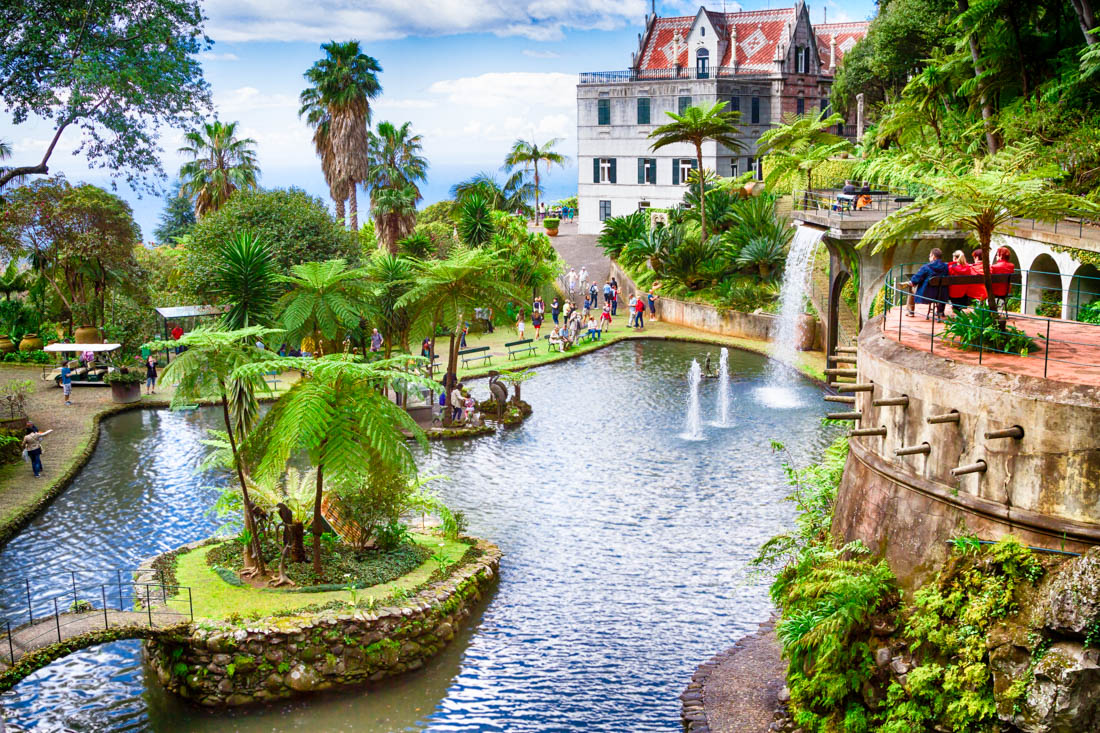
Which country is cheaper, Portugal or Spain?
These are the overall average travel costs for the two destinations.
- Spain Prices Portugal Prices
- Average Daily Cost Per person, per day Spain € 150 Portugal € 136
The average daily cost (per person) in Spain is €150, while the average daily cost in Portugal is €136. These costs include accommodation (assuming double occupancy, so the traveler is sharing the room), food, transportation, and entertainment. While every person is different, these costs are an average of past travelers in each country. What follows is a categorical breakdown of travel costs for Spain and Portugal in more detail.
Accommodation
- Accommodation Hotel or hostel for one person Spain € 67 Portugal € 59
- Accommodation Typical double-occupancy room Spain € 134 Portugal € 118
Compare Hotels in Spain and Portugal
Looking for a hotel in Spain or Portugal? Prices vary by location, date, season, and the level of luxury. See below for options and compare which is best for your budget and travel style.
Hotels in Spain
Hotels in Portugal
Kayak helps you find the best prices for hotels, flights, and rental cars for destinations around the world. Compare prices for multiple destinations when planning your next trip.
Local Transportation
- Local Transportation Taxis, local buses, subway, etc. Spain € 27 Portugal € 27
Typical Local Transportation prices in Spain
Here are some examples of typical transportation prices from actual travelers in Spain:
- Taxi Ride € 26
- 10 Trip Metro Ticket € 7.80
- Airport Bus € 5.00
- Bus Ride € 3.50
- Taxi Ride € 6.80
- Bus Ride € 1.25
- 7 Trip Bus Pass € 5.00
- Metro € 2.10
Hired Cars and Shuttles in Spain
Also for Spain, here are a few examples of actual transportation services:
- Madrid Barajas Airport: Transfer to/from Atocha Bus Station: $7.55
- Girona Airport: Bus Transfer to/from Figueras Station: $8.53
- Barcelona: One-Way Shared Transfer to/from Airport and City: $9.94
- Lanzarote: Puerto del Carmen & Puerto Calero Boat Transfer: $12
- Valencia: One-Way Boat Transfer to/from Port Saplaya: $13
- Barcelona: Roca Village Shopping Mall Transfers: $13
- Mallorca: Shared One-Way Transfer to Palma Airport: $14
- Mallorca: Shared 1-Way Transfer from Airport to Hotel: $14
- Transfer arrival Shuttle Reus Airport to Salou: $15
- Transfer arrival Shuttle Reus Airport to La Pineda: $15
- Transfer arrival Shuttle Reus Airport to Cambrils: $15
- Transfer arrival Shuttle Girona Airport to Santa Susanna: $16
Typical Local Transportation prices in Portugal
Here are some examples of typical transportation prices from actual travelers in Portugal:
- Taxi Ride € 6.50
Hired Cars and Shuttles in Portugal
Some specific examples of transportation prices in Portugal:
- sintra private luxury transfer to or from lisbon airport: $151
- XL Faro Airport Private Transfer Lagos/Albufeira/Vilamoura: $97
- Tuk Tuk Transfer With Sintra Pena Ticket From Meeting Point: $74
- Try find your better than us ! Airport transfer service in Porto HTL-APT (OPO): $33
- Try find your better than us ! Airport transfer service in Lisbon HTL-APT (LIS): $36
- Try find your better than us ! Airport transfer service in Lisbon APT-HTL (LIS): $36
- Try find your better than us ! Airport transfer service in Faro HTL-APT (FAO): $36
- Try find your better than us ! Airport transfer service in Faro APT-HTL (FAO): $36
- Transfers taxi tours golf wedding: $56
- Transfers from/to Lisbon Airport to: Fátima / Nazaré / Alcobaça..: $264
- Transfers from Lisbon airport and to Lisbon Airport: $122
- Transfers and Tours safely and comfortably aboard a Tesla M3: $39
Is it cheaper to fly into Spain or Spain?
Prices for flights to both Portugal and Spain change regularly based on dates and travel demand. We suggest you find the best prices for your next trip on Kayak, because you can compare the cost of flights across multiple airlines for your prefered dates.
- Food Meals for one day Spain € 40 Portugal € 40
Typical Food prices in Spain
For Spain, here are some examples of average food and meal prices for travelers:
- Hot Cocoa & Churro € 4.15
- Sandwich € 1.70
- Baguette & Horchata € 3.80
- Coffee € 2.00
- Lunch € 14
- Fiesta Paella € 8.00
- Soda € 2.50
- Sangria € 2.50
- Sandwich to go € 3.00
- Bocadillo & Drink € 6.25
- Lunch € 9.50
- Ice Cream € 2.30
Food Tours and Cooking Classes in Spain
For Spain, here are some samples of tours and activities related to meals and dining experiences:
- Valencia: Cooking Class of traditional spanish food: $1.08
- Valencia: Flamenco at Toro y La Luna with Drinks or Dinner: $19
- Local cooking class in Cordoba. Hands on: Salmorejo: $22
- Barcelona: Flamenco at El Patio Andaluz with Optional Dinner: $27
- Walking Tour + Flamenco + Tapas Dinner (choose options): $27
- Cordoba: Flamenco Show at Tablao El Jaleo & Optional Dinner: $32
- Torremolinos: Flamenco show with Dinner and Unlimited Drinks: $32
- Malaga: Hard Rock Cafe Entrance with Lunch or Dinner: $32
- Valencia: Hard Rock Cafe Entrance with Lunch or Dinner: $32
- Mallorca: Hard Rock Cafe Entrance with Lunch or Dinner: $32
- Torremolinos: Horse Show, Dinner Option, Drinks, & Flamenco: $32
- Tenerife: Hard Rock Cafe Set Menu Lunch or Dinner & Drink: $34
Typical Food prices in Portugal
Some typical examples of dining costs in Portugal are as follows:
- Pizzaria Lunch (for 2) € 15
- Coffee € 1.40
- Coffee € 2.50
- Lunch for Two € 13
Food Tours and Cooking Classes in Portugal
Also, here are some specific examples of food and dining related activities in Portugal.
- DINNER +PARTY + CITY TOUR of Lisbon : $5.00
- DINNER +PARTY + CITY TOUR of Lisbon : $6.00
- Lisbon: Soirée Rivage - Sunset cruise with dinner and Party: $25
- Private Walking Food Tour Around Funchal: $31
- Morning Food Tour in Ponta Delgada: $33
- Madeira Nights Tour - Dinner and Show: $42
- Lisbon: Tapas Food Tour: $42
- Madeira by Night with Traditional Dinner: $43
- Madeira:TypicalShowFolklore Evening.included.Dinner transpt: $46
- Lisbon: Fado Show and Portuguese Dinner: $49
- Lisbon Riverside Dinner with Tagus View: $49
- A Portuguese Dinner and Cocktail Experience with pick up: $50
Entertainment
- Entertainment Entrance tickets, shows, etc. Spain € 27 Portugal € 22
Typical Entertainment prices in Spain
Below are a few sample prices from actual travelers for Spain's activities, tours, and tickets:
- Picasso Walking Tour and Museum Pass € 42
- Souvenir Gaudi Book € 8.55
- Snorkel € 5.00
- Flamenco Tour € 16
- Entrance to Cathedral € 8.00
- Garden Entrance Fee € 6.00
- Admission to Museo Picasso € 6.00
- Entrance to Castillos € 7.10
- Concert € 31
- Cadiz Sightseeing Tour € 15
- Tower of Hercules € 3.00
- Valle de los Caídos Monument € 6.00
Tours and Activities in Spain
For Spain, here are a few prices for actual activities, tours, and tickets provided by various companies:
- Madrid: Old Town Guided Walking Tour: $1.08
- Madrid Essential: Free Walking City Tour: $1.08
- Sagrada Familia Exterior Free Tour: Stories, Secrets & Symbolism: $1.10
- GROUP walking tour in Vigo: $1.10
- Walking Tour in Pontevedra: $1.10
- Group walking tour in Lugo: $1.10
- Old Town of Santiago de Compostela Walking Tour: $1.11
- San Sebastian : Discovery Stroll and Reading Walking Tour: $2.15
- Parte Vieja San Sebastian : Self-Guided Reading Walking Tour: $2.15
- Tour Retiro Park - Madrid self-guided tour app: $2.16
- Self-Guided Tours Barcelona: 150+ Captivating Audio Stories: $2.16
- SEVILLE in one day: GPS-AutoGuided Audio Tour: $2.16
Tours and Activities in Portugal
Some specific costs of activities, tours, and entrance tickets for Portugal are as follows:
- Óbidos - Nazaré - Mafra (National Palace of Mafra)Private tour from Lisbon: $246
- 2 Hours Surf Lesson Experience in Costa da Caprica: $39
- Algarve Coast & Chapel of Bones ( Private Van Tour ): $53
- Divine Journey : Fatima Full Day Private Tour: $166
- Faro to Benagil Hiking Tour and Marinha beach: $55
- Full Day Private Tour in Silves and Coast Gems: $193
- Full Day Tour Sete Cidades & Lagoa do Fogo with Lunch: $87
- Half Day Private Wine and Traditional Tile Making Tour: $128
- Horse Carriage Tour on the Mountain in Palmela: $167
- Kayak Tours to Benagil & Marine caves - From Benagil Beach: $39
- Lisbon City Half-Day Private Tour : $289
- Lisbon Full Day Small Group City Tour: $72
- Alcohol Drinks for one day Spain € 19 Portugal € 16
Typical Alcohol prices in Spain
Below are a few samples from actual travelers for alcohol and nightlife costs in Spain:
- Beer € 5.00
- A Sangria & a Beer € 6.50
- Bottle of Wine € 5.00
- Wine in Front of Cathedral € 4.00
- Beer € 3.00
- Bottle of Wine € 1.65
- Beer € 1.20
- Celebratory Shots € 5.00
- Beer € 2.80
- 1 Pint Beer € 2.00
- Drinks and Tapas (for 2) € 13
- Coffee € 3.10
Sample the Local Flavors in Spain
Here are a few nightlife and alcohol tours and activities from local tour providers in Spain:
- Pub Crawl Madrid Erasmus & International Meet and Party: $6.05
- Erasmus Madrid Pub Crawl Madrid: $8.88
- Madrid: Original Pub Crawl With VIP Club Entry: $9.72
- Visit and wine tasting at BODEGA PIRINEOS: $11
- Barcelona Pub Crawl by King - Bar & Nightclub Hopping Tour: $13
- Legendary Pub Crawl by I'm Barcelona VIP: $13
- Valencia: Guided Pub Crawl with Free Shots: $13
- Barcelona International Party Pub/Bar Crawl with Free Shots: $13
- Visit winery and wine tasting: $14
- Tenerife: Guided Tour at Casa del Vino & Wine Tasting: $14
- Madrid: Pub Crawl Madrid's Night time: $15
- Barcelona Pub Crawl by KING-Best Party tour & VIP Club Entry: $15
Sample the Local Flavors in Portugal
Here are a few nightlife and alcohol tours and activities from local tour providers in Portugal:
- Algarve: 3 Types of Wine Tastings with Vineyard Views: $15
- Funchal: H.M. Borges Winery Guided Tour with Wine Tasting: $16
- Douro Valley: 1h Solar Boat Experience - Two Wine Tasting: $17
- Lisbon: Port Wine Tasting at Taylor’s Shop and Tasting Room: $17
- Lisbon: Bar Crawl with Unlimited Drinks and VIP Club Entry: $17
- Lisbon: Pub Crawl with Unlimited Drinks and VIP Club Entry: $17
- Lisbon: Pub Crawl with Unlimited Drinks and VIP Club Entry: $18
- Loulé: Quinta da Tôr Winery Guided Tour and Wine Tasting: $18
- Tour & Wine tasting - Authentic Algarve Flavours by Quinta da Tôr: $19
- Pub Crawl Lisbon - 1 Hour of Unlimited Beer and Sangria and more!: $19
- Lisbon: Pub Crawl with Open Bar and VIP Club Entry: $19
- Douro Wine Tasting: $19
When comparing the travel costs between Spain and Portugal, we can see that Spain is more expensive. However, the two cities are actually relatively comparable in price, as the difference is somewhat minimal. Generally, this means that you could travel with generally the same travel style and level of luxury in each place. Since both cities are in Europe, it's no surprise that their costs are relatively close, as many destinations here have somewhat similar travel prices overall.
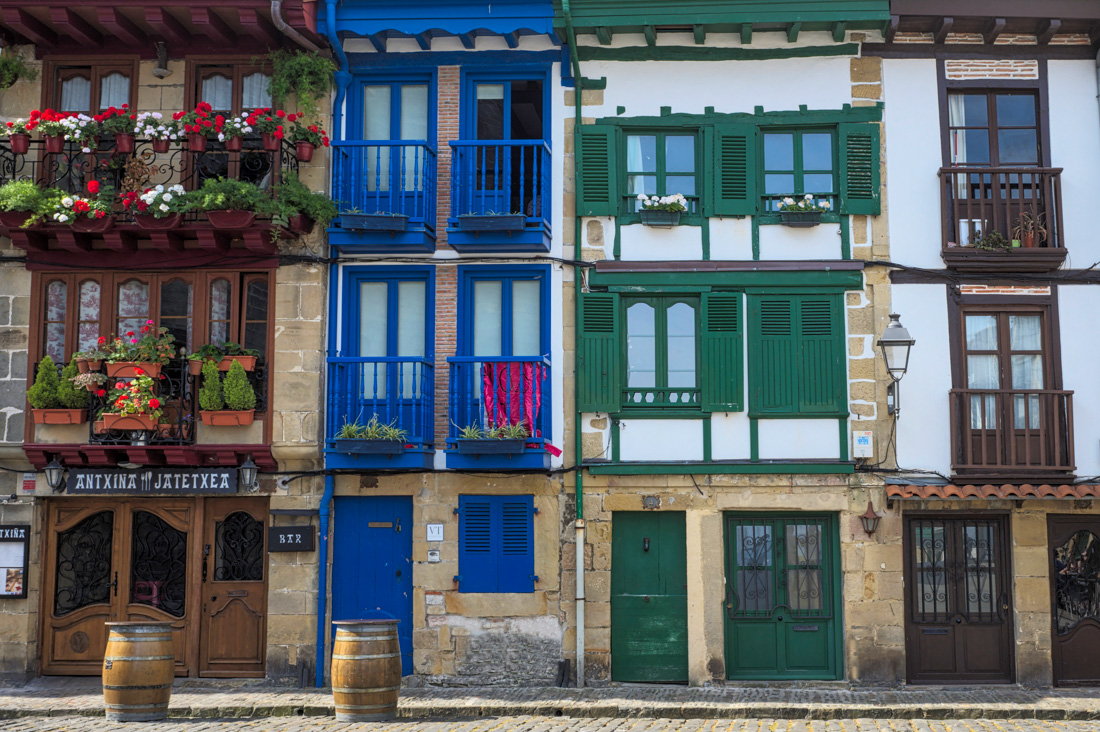
Why is Spain more expensive than Portugal?
Spain and Portugal are generally comparable in price, but Spain tends to be slightly more expensive. The countries have a lower cost of living than some Western European countries, and this translates into slightly more affordable travel costs for visitors. Even so, Spain is a top tourist destination, so don't expect it to be super cheap. Portugal continues to grow in popularity as well, and you can expect prices to go up as this trend continues. If you're traveling on a particularly tight budget, you'll find plenty of budget accommodation options around such as hostels, and affordable guesthouses.
What are the most expensive and cheapest cities and regions in Spain and Portugal?
In general, the most popular tourist destinations tend to also be the most expensive. In Spain, coastal cities and towns can actually be a bit more expensive to visit than the larger cities. The high demand for accommodation drive prices up, particularly during the peak times when most visitors arrive.
In Portugal, Lisbon and the coastal towns are usually the most expensive places to visit.
In both Spain and Portugal, prices are very dependent on the season, so if you're traveling during the peak summer months you'll likely to pay significantly more for a room.
How can you save money while visiting Spain and Portugal?
Prices in both Spain and Portugal are very dependent on the time of year. Travel during the slightly off peak times. Prices inevitably climb during the peak summer months so make sure you visit when the crowds are less during the fall or spring seasons.
Stay flexible. Be willing to change your plans if things aren't going as you expected and don't be afraid to leave a place early or stay longer if you're having a particularly good time.
Spend time just exploring the town you're in. Take at least a day and just let yourself get lost. Don't worry about seeing the specific sights and attractions, but instead soak up the atmosphere and culture of the city.
Buses are almost always cheaper than trains, so look into all of your transportation options before buying tickets.
Eat local. Find the local restaurants that are popular with the residents of the town. Avoid the tourist traps and you're likely to have the best food for a fraction of the cost.
Move slowly. Don't be afraid to slow your travel speed down. Spend more time in less places, and your transportation costs will go down significantly. You'll also experience each location on a whole new level.
Related Articles for Spain
Related articles for portugal.

More Destination Comparisons
Subscribe to our newsletter.
By signing up for our email newsletter, you will receive occasional updates from us with sales and discounts from major travel companies , plus tips and advice from experienced budget travelers!
Share This Page
Pin this page.
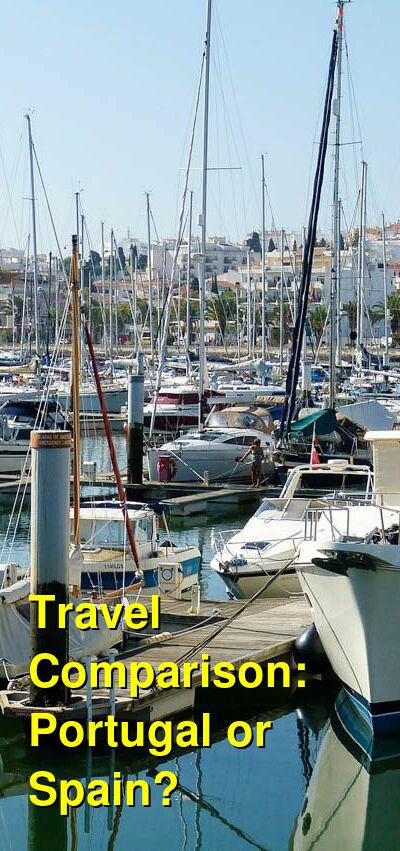
Some of the links on this website are sponsored or affiliate links which help to financially support this site. By clicking the link and making a purchase, we may receive a small commission, but this does not affect the price of your purchase.
- Privacy / Terms of Use
- Activities, Day Trips, Things To Do, and Excursions

- Editor's Picks Europe & UK Landmarks & Icons
Portugal vs Spain: Which Country is Right for Your Western Europe Trip?
- By Aren Bergstrom
- On February 21, 2018
- Read Time 12 mins
Home / UK & Europe / Portugal vs Spain: Which Count…
We’ve tackled Australia vs New Zealand and Italy vs France, and now we’re here to sort out another marquee matchup. When heading on a sunny Western Europe trip , which destination is right for you, Portugal or Spain .
Depending on who you ask, you might get passionate answers for one over the other or shrugged shoulders and admissions that people can’t tell the difference between the two. We get it. Both of these countries share the Iberian Peninsula, have a lot of common history, and occupy a similar headspace for vacationers wanting to get away to sunny climates with good food and friendly people. But that’s where similarities end. Portugal and Spain are very different, and knowing how to choose between the two will help you plan your ideal Western European vacation.
Below we break down the differences between these sunny European nations, focusing on landscape and climate, expenses and infrastructure, landmarks, food and drink, and history and culture. Spoiler alert: we’re not throwing either country under the bus and you should definitely visit both countries if you can commit the time and money to it, but knowing the above will help you prioritize for your Europe trip in the near future.
Landscape and Climate
Since Portugal and Spain share the same peninsula, their landscapes and climate are similar. Geographically, Portugal is defined by its long coastline, making it abound with beaches. The north of the country is mountainous and wet while the south is drier and has rolling plains with many beaches near the Algarve . There is a desert near Alentejo and the country lacks any large natural lakes. Spain is mainly a highland plateau with mountain ranges running through it. As well, there are coastal plains and river valleys crisscrossing the peripheries. The biggest geographic difference between Portugal and Spain is the size; Spain is around five times larger than Portugal.
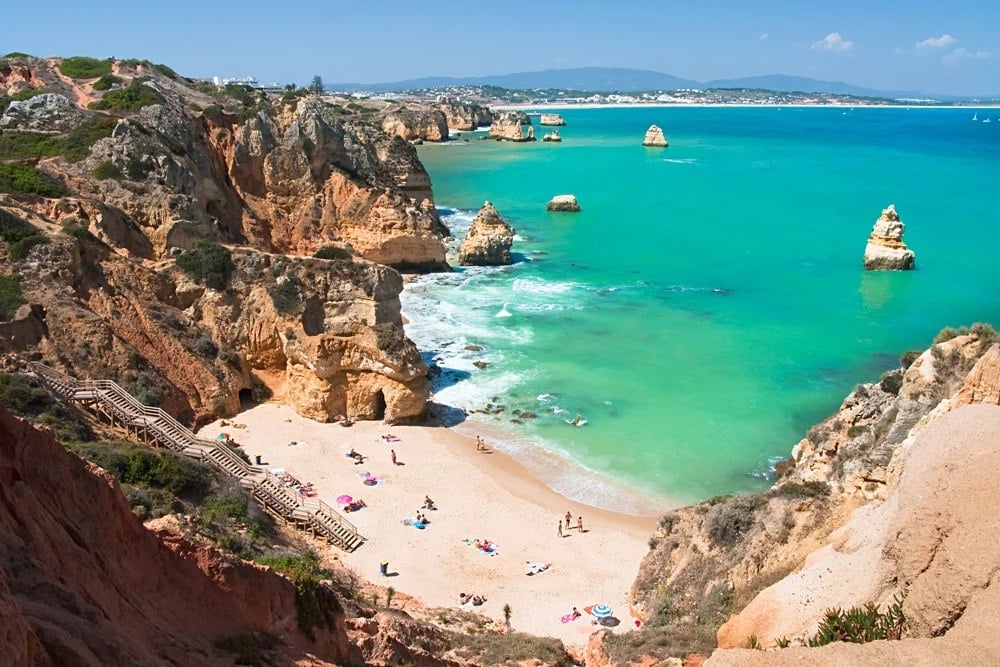
Both countries have Mediterranean climates, meaning they are generally temperate, with warm summers and mild winters. In Portugal, the average temperature in Lisbon is 24°C in July and 11°C in January, and in Spain the average temperature in Barcelona is around the same: 24°C in August and 10°C in January. This similarity makes sense as both nations are known for their beaches and for enticing travellers during the colder months.
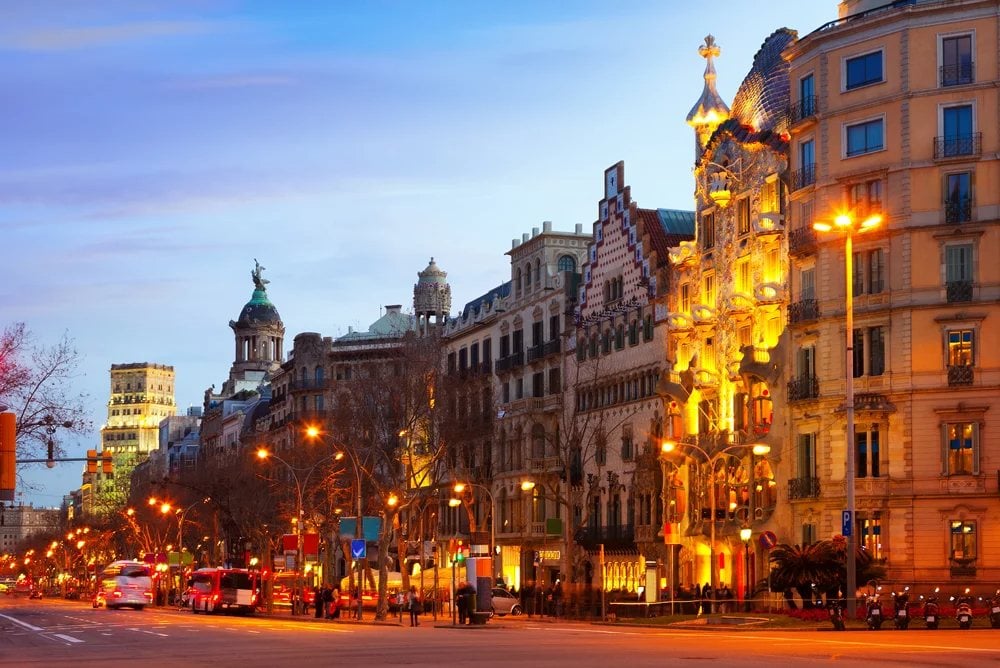
Your choice between the two will likely be determined by the amount of time you can spend on your Europe trip . If you have only a few weeks, you can see more of Portugal than Spain as it’s a smaller country. But if you have around a month to spare, the size is no longer an issue and Spain becomes equally as appealing as Portugal.
Expenses and Infrastructure
Generally speaking, Portugal is cheaper than Spain, although the flight there will likely be the most expensive part of your Portugal vacation . A standard flight from North America to Lisbon in May will cost around $1,200 to $1,300CAD for a round trip. For comparison, a round-trip flight to Barcelona is around $1,200CAD in May. It’s also easier to connect to Spain than Portugal from major North American cities. You’ll find more flight options and lower prices from some airlines as a result.
However, once you’re in the country, you’ll find Portugal remarkably affordable. A 3-star hotel in Lisbon in the middle of May (high season) will set you back around $166CAD on average, while accommodations outside the major centres will be much cheaper. Accommodations are more expensive in Spain than in Portugal, with a 3-star hotel in Barcelona in May costing around $183CAD on average. However, while accommodations are more expensive in Spain, you’ll find that some food and alcohol is cheaper than in Portugal, especially if you’re travelling outside of the high season. Overall, Portugal remains one of Europe’s most appealing budget destinations, although Spain is hardly expensive as far as Western European countries go.

As far as infrastructure goes, both countries are well-developed, although not quite on the level of France or Germany . Portugal has a large train network that is affordable and easy to navigate. Spain also has a large high-speed train network, the AVE Alta Velocidad, which runs between all the major cities. Smaller public transit systems, by train or bus, cover the gaps between the major cities. As for driving, Portugal’s highways have improved in recent years, but overall, Portugal continues to have poor road conditions and a bad reputation for road safety. Highways are in better conditions in Spain than in Portugal, but you should opt for transit unless you’re planning a self-drive on your Europe trip . Just remember that Sundays and public holidays have limited service.

Overall, Portugal will cost less, but Spain has a higher level of infrastructure. It’s a small trade off either way.
Like so many Western European nations, both Portugal and Spain are rich with cultural and historical icons. Portugal’s capital city, Lisbon, has many landmarks that would be the envy of other cities. Perhaps most iconic is Belem Tower, the 16th-century fortified tower that sits on the water, but you’ll also find Sao Jorge Castle and Jeronimos Monastery. In Sintra, you’ll find the Romanticist building, Pena Palace, as well as the medieval Castle of the Moors.
Aside from historical icons, you’ll find the Dom Luis Bridge spanning the Douro River between Porto and Vila Nova de Gaia. For natural wonders, you’ll also find one of the best caves in Europe in Portugal – the Benagil Sea Cave, which has an incredible natural skylight in its ceiling and a secluded beach cut off from the rest of the Algarve. The Algarve as a whole, with its many breathtaking beaches and rocky coastlines, is also as much an icon as any of these historical monuments.

Spain has no shortage of historical sites as well. For ancient wonders, it’s got the Aqueduct of Segovia, which is possibly the best-preserved Roman aqueduct in the world. For the medieval era, you’ll find the Moorish city of Cuenca and the Mezquita of Cordoba, once the Great Mosque of the Iberian Peninsula. Even better is the Alhambra, a grand palace built in 889AD and once home to the Emirate of Granada . The era of the Spanish Empire brought the Royal Palace in Madrid , as well as El Escorial, located in San Lorenzo de El Escorial.
For more modern landmarks and icons, you’ll find the works of Antoni Gaudi in Barcelona , such as the Sagrada Familia. In the Mediterranean Sea, you’ll find the popular party islands of Majorca and Ibiza. For natural icons, in San Sebastian you’ll find the beach of La Concha, which is essentially the Platonic ideal of a beach. And in Pamplona, you’ll find the yearly nine-day festival of the Running of the Bulls.
Related Article: Journey Through Gaudi’s Barcelona in Spain

If you’re simply looking to visit the most famous sites on the Iberian Peninsula on your Europe trip , you should head to Spain, but you’ll be well treated when it comes to icons no matter which nation you visit.
Food and Drink
You’re in for a culinary treat regardless of whether you head on Spain holidays or trips to Portugal. Both Portuguese and Spanish cuisine rely on fresh seafood, fragrant ingredients like olive oil and garlic, and pair well with robust wines. Both countries use rice as a common grain and obsess over the use of the spicy pork sausage, chorizo. While you’ll find cutting edge cuisine in the major cities, the humility and universality of Portuguese and Spanish dishes is what make them so fabulous.

Portuguese food tends to consist of seafood cooked with lots of spice, such as piri piri, black pepper, cinnamon, and saffron. Most dishes are cooked in olive oil and feature copious amounts of garlic. Dishes tend to be light, but they grow heavier the more northerly you get. Likely the most common ingredient in Portuguese cooking is Bacalhau , a dried, salted cod that is eaten everywhere in the country. There’s even a saying that there are 365 ways to cook Bacalhau, one for every day of the year. Other popular Portuguese dishes include Francesinha, Cozido a Portuguesa, and Posta Mirandesa. In terms of wine, Portugal is known for port and dry whites, as well as some full-bodied reds from the Douro Valley.
As with Portugal, in Spain you’ll find more seafood in the south and heartier dishes in the north. The most famous style of Spanish food is tapas, which consists of small savoury dishes, such as patatas bravas, that are shared at dinner and paired with alcoholic beverages. Perhaps the most common Spanish dish is paella, which consists of rice cooked in a broth alongside seafood or chicken, saffron, and green and white beans. However, it’s more particular to the Valencia region than Spain as a whole. Other famous dishes include the cold soup, gazpacho, and tortilla Espanola or frittatas. Spain produces the most wine in the world after France and Italy . Popular vintages include Garnacha and Monastrell, as well as the sparkling wine, Cava. While Sangria has become popular in North America, you’re more likely to find Spaniards drinking Tinto De Verano (red wine and lemonade) when you visit.

Both Portuguese and Spanish cooking share a lot of similarities and have been massively influential on world cuisines, especially the national foods you’ll find in South America . However, the average person will probably find more to enjoy with Spanish cooking. It’s generally more accessible.
History and Culture
Portugal and Spain share a lot of history by virtue of their geography. They were both conquered by the Roman Empire , the Goths , and the Umayyad Caliphate during the past two thousand years and both became world powers during the Age of Discovery , when European colonial powers extended their empires to the edge of the known world. With such opulent heights in their pasts, it’s understandable that both nations have a strong historical pride. The people are proud of their heritage and the cities and towns are alive with history. However, there are key differences between the two cultures.
Portugal can come across as more laidback than other European nations. The coast attracts a lot of surfers and you’ll find plenty of quiet spots throughout the country’s backwaters where people are in no rush at all. Aside from food and football (mention Cristiano Ronaldo and you’re likely to hear a passionate declaration of his greatness and a mention that Portugal has a chance of winning the World Cup), Portugal is also known for Fado , the mournful folk music that you’re likely to hear in country houses across the nation. In terms of what to expect when on a Portugal vacation , don’t assume everyone speaks English, don’t demand that waiters and service professionals rush their work, and don’t expect to get much done on Sundays. Portuguese culture has no time for people who are in a hurry on their Europe trip .

In Spain, you’ll find different cultural specificities depending on which region you visit. Most Spaniards are fiercely regionalist, as we’re seeing in the current Catalonian struggle for independence. In broader terms, Spaniards are proud of food, football, and the arts, while stereotypical cultural elements like bullfighting have fallen by the wayside. Spain has been home to some of the great artists of the world – Antoni Gaudi, Pablo Picasso , and Miguel de Cervantes to name a few – and the culture openly celebrates this artistic heritage. As for general culture tips on Spain holidays , don’t expect people to know English everywhere you go. Also, don’t expect the same kind of service in restaurants and stores as you get in North America; tips aren’t common so servers won’t be overly chipper and hyper-attentive the way you’re used to. Most importantly, remember that Spaniards don’t eat on a North American schedule. Breakfast is at 8am, a massive lunch is at 3pm, and a light dinner is at 10pm. Do not expect restaurants to cater to you if you’re trying to diverge from this schedule.
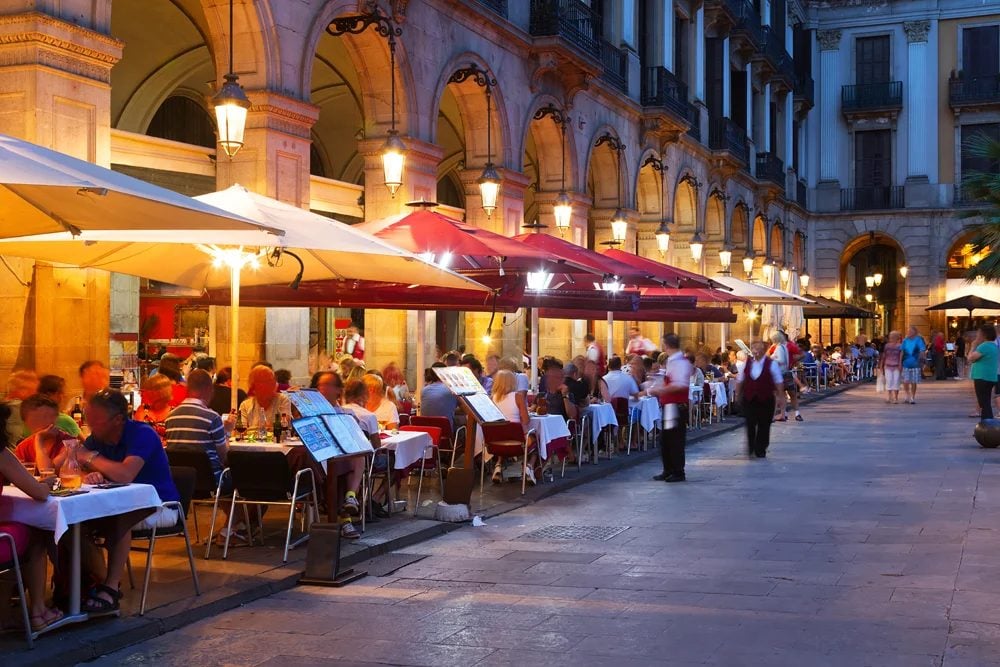
Both Portugal and Spain have long, storied histories and robust cultures that’ll charm you when you visit. If you’re interested in seeing more famous artworks and experiencing the more influential culture, Spain probably edges Portugal out by virtue of its size. But remember that Portugal is no second fiddle.
Which one is right for you?
We’ve gone over the country’s similar landscapes and climates, discussed the costs of visiting, listed the numerous landmarks to be found, and tried to point out some highlights of food, history, and culture. Now you have to decide which country is right for you on your Europe trip .
Ideally, you’d see both nations, but you want to give each a fair shake. In general terms:
- If you want to visit a warm climate with affordable accommodations, lots of great food, and a unique culture that’s been influential on the world despite its size, head to Portugal .
- If you want to explore a large nation with good infrastructure, popular food and drink, and some of the world’s greatest artistic accomplishments, head to Spain .
Portugal and Spain share a lot of similarities, but they’re very different countries that have both had a huge influence on the world at large. No matter which country you choose to visit, you’re in for an unforgettable Western Europe trip .
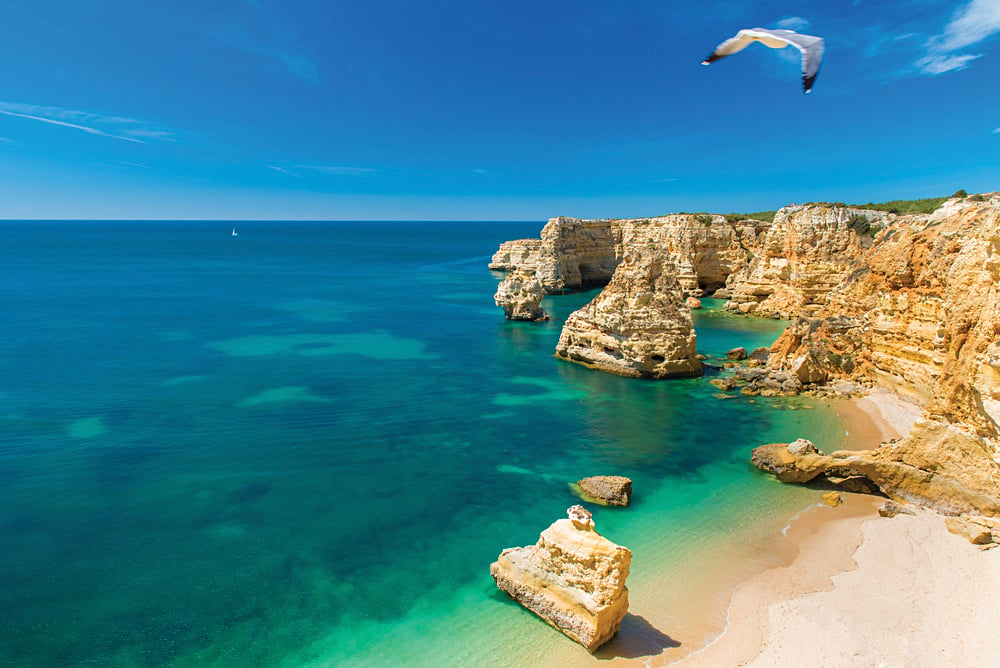
Related Articles:
- Australia vs New Zealand: Which Iconic Destination is Right for You on a South Pacific Vacation?
- France vs Italy: Which Cultural Marvel is the Right European Vacation for You?
Discover Portugal or Spain
When you are a Goway Globetrotter you become part of a special fraternity of travellers about whom we care very much. Our company philosophy is simple – we want you to be more than satisfied with our services.
Looking to travel to Portugal, Spain or both? Get a Free Quote by filling out the form below:
Get more travel inspiration by email.
Aren Bergstrom
Globetrotting Editor - You might say that Aren was destined to become a Globetrotter after his family took him to Germany two times before he was four. If that wasn’t enough, a term spent in Sweden as a young teenager and a trek across Vietnam, Cambodia, and Thailand confirmed that destiny. An independent writer, director, and film critic, Aren has travelled across Asia, Europe, and South America. His favourite travel experience was visiting the major cities of Japan’s largest island, Honshu, but his love for food, drink, and film will take him anywhere that boasts great art and culture.
You might also like

6 Underrated Destinations for Late Summer

A Beginner’s Guide to Birding & Travel

Beauty of the Beast: Scottish Highland Cattle

Top 8 Summer Destinations for 2024

Get the latest travel trends & hear about the best deals on vacations around the world.
If you’re a Globetrotter, these are the newsletters for you!
How to get around in Spain by train, plane, bus or boat
Jun 26, 2023 • 5 min read

The train is a quick and efficient way to travel around in Spain © F.J. Jimenez / Getty Images
Criss-crossing destinations around Spain , whether by land, air or sea, is easy and convenient due to Spain’s efficient multi-modal public transport infrastructure, which has also been upgraded significantly over recent years.
Spain also gets high marks for universally accessible travel . Visitors with reduced mobility can move around fairly easily compared to other European countries. The country’s public transport infrastructure, such as trains, buses and terminals, has been designed for accessibility, offering specially designated spaces and adapted features for people with disabilities and anyone with mobility challenges, young and old alike.

Get around with ease on Spain's train network
RENFE is Spain’s national railway company that runs about 5000 trains each day across the country. The best and fastest way to travel long distances in Spain is by taking the AVE (Alta Velocidad Española) , which uses Madrid as its principal terminal and travels to many of the country’s principal cities.
AVE trains are comfortable, efficient and incredibly fast. Traveling up to 310km (192.6 miles) per hour, it connects Madrid to Barcelona — over 600 kilometers away — in a mere 2.5 hours.
The RENFE Alvia trains, which connect the northern cities and regions to Madrid, are also high-speed trains with stops along the way. The RENFE Avant mid-distance high-speed trains or the Media Distancia (mid-distance) trains are the most time-savvy option for nearer day-trip destinations.
The most recent addition to RENFE’s fleet are the high-speed, low-cost Avlo trains with tickets. This is the best option for passengers with reduced mobility — all entrances to their carriages are at platform level and feature H seats for travelers in wheelchairs, as well as adapted toilets for people with disabilities.

The bus is the best if you're on a budget
For budget-conscious travelers, the bus is the best way to move around Spain if you don’t mind the longer travel times. It’s also the preferred way for locals to get around, given its convenience, economical ticket prices and connections to smaller towns where trains do not pass.
There are several bus service providers in every Spanish city, and many of these fleets offer quite a comfortable ride with reclining seats and wifi on board to make traveling over long distances a smooth and pleasant experience.
While tickets can be directly purchased from the bus driver, it is best to reserve and buy them in advance. Keep in mind that the most popular routes and times tend to get full pretty quickly.
Tip for finding a bus service To find out which bus services are in operation at your departure point, Movelia.es provides the most comprehensive information on available national bus routes (and even international ones), schedules and purchasing, and has multiple language options.
Planes are best for Spain's outlying islands
Flying is the quickest way to travel around Spain, and the best option to get to its outlying archipelagos — and hotspot tourist destinations, the Balearic Islands east of the peninsula or the Canary Islands in the Atlantic. Spain has regular domestic flights operating across its nearly 60 airports; the principal ones are Madrid’s Adolfo Suárez Madrid-Barajas Airport and Barcelona’s El Prat Airport.
Iberia Airlines is Spain’s national carrier that regularly offers reasonably priced tickets if you book in advance. Its low-cost brand Vueling , which regularly codeshares with Iberia, also offers several domestic daily flight options with affordable fares.

Take the slow route – travel around Spain by boat
Many of Spain’s top cities and islands are also important cruise ports, including Barcelona, Cádiz, Valencia, Ibiza, Palma de Mallorca, and Las Palmas (Canary Islands). If time is not an issue, traveling by boat or ferry across from the Peninsula across the Mediterranean or Atlantic waters is a pleasant, albeit drawn-out, travel experience. This is also the best option if you wish to take your car, motorbike or bicycle on board.
Spain’s main shipping lines, Baleària and Trasmediterránea , offer regular trips from main cities in the peninsula as well as hourly connections in the Balearic Islands (between Ibiza, Mallorca, Formentera and Menorca) and the eight main islands of the Canaries. Passengers have the option to book seats or cabins with beds.
Go green with Spain's carpooling services
Car-sharing services are a popular and environmentally-friendly mode of transport for getting around Spain’s cities or regional towns. BlaBla Car is the most popular service that allows you to book car-share rides to several points around Spain. If you’re in the driver’s seat and seeking some company (or wish to share the gas bill), you can also publish your own rides, pick-up points and prices on the BlaBla Car website.
Not only is this a cost-effective way to travel long distances , but it’s also a great way to meet locals (and practice your Spanish!).
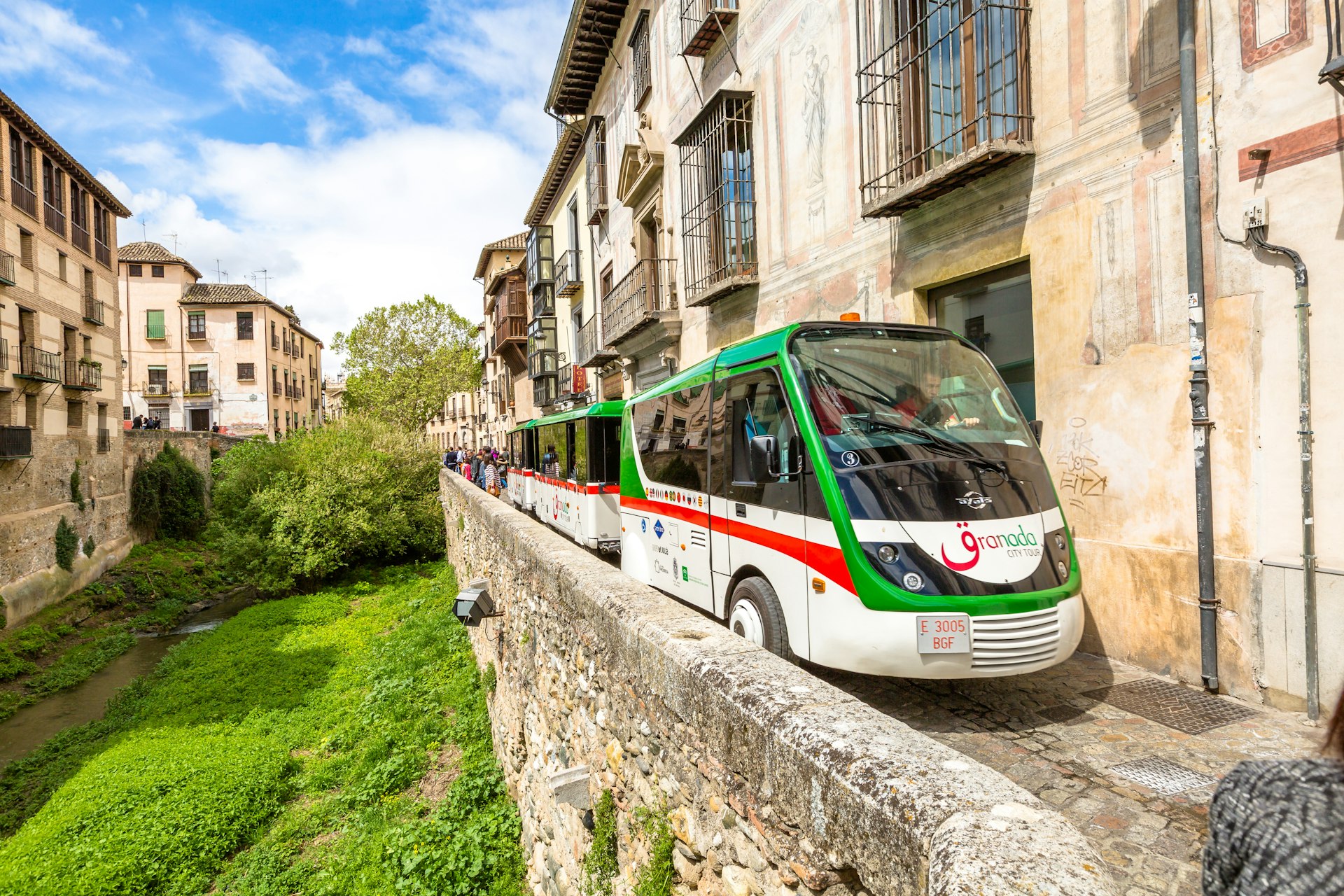
Accessible transport options in Spain
People with reduced mobility will find Spain a highly accessible and inclusive travel destination. All Spanish airports provide passengers with disabilities or reduced mobility free assistance services, from the moment you land to security and border controls and luggage collection. These services can be requested in the AENA (Spain’s state-owned airport operator).
If you are traveling by train, RENFE’s Atendo is a free service that passengers can request assistance in transiting between stations, boarding and disembarking train carriages.
In Spain’s main cities, such as Madrid and Barcelona , terminals and stations are largely designed to give passengers full autonomy. Madrid’s Metro , for example, has installed universal accessibility features in all its stations, with over half of all stations fully accessible with lifts and ramps for wheelchair access. In addition, step edges are reinforced, and elevator signs and handrails have Braille markings.
Barcelona’s entire metro (except for two out of a total of 165 stations) is accessible and has advanced features such as directional devices for blind people and luminous door devices on trains. Local city buses have also been adapted for accessible travel, with tilts, ramps, and reserved spaces for wheelchair users and baby carriages, as well as Braille-embossed stop buttons.
This article was first published Aug 26, 2021 and updated Jun 26, 2023.
Explore related stories

Destination Practicalities
May 30, 2024 • 10 min read
Our first-time guide to Palma de Mallorca gives you a taste of what’s here, but you’re sure to find treasures of your own, too.

May 27, 2024 • 6 min read

May 23, 2024 • 17 min read

May 21, 2024 • 11 min read

May 20, 2024 • 5 min read

May 3, 2024 • 6 min read

Apr 30, 2024 • 4 min read

Apr 19, 2024 • 10 min read

Apr 3, 2024 • 15 min read

Mar 31, 2024 • 6 min read

Modric's Croatia beats Portugal 2-1 in Euro warmup while Ronaldo rests. Spain routs N. Ireland
B ARCELONA, Spain (AP) — Luka Modric scored a penalty to help Croatia beat Portugal 2-1 while Spain thumped Northern Ireland in the run-up to the European Championship on Saturday.
The friendly matches were the last for Spain and Croatia before they open the tournament against one another on June 15 in Berlin. They are in a tough Group B along with Italy and Albania.
Spain fine-tuned its attack with a 5-1 rout of Northern Ireland. Pedri González led the way with his first two goals for his nation.
Portugal has one more friendly — against Ireland on Tuesday — before it starts the competition against the Czech Republic on June 18 in Leipzig. Portugal is the favorite in Group F that also includes Turkey and Georgia.
Cristiano Ronaldo never left Portugal’s bench, with coach Roberto Martínez tapping Gonçalo Ramos to spear his attack.
Ronaldo joined Portugal on Friday after finishing his club campaign with Al-Nassr in Saudi Arabia. The 39-year-old is set to make a record sixth appearance at the European Championship. Men’s soccer all-time leading scorer with 128 goals, Ronaldo helped Portugal win the European title in 2016.
Modric beat goalkeeper Diogo Costa to open the scoring in the eighth minute at Portugal’s National Stadium near Lisbon. The 38-year-old Real Madrid midfielder was sent to the penalty spot after Vitinha fouled Mateo Kovacic in the area.
Halftime substitutes Diogo Jota and Nelson Semedo linked up to equalize for the hosts in the 48th, with Semedo assisting the Liverpool forward to tap in.
Ante Budimir restored Croatia’s advantage in the 56th after the Osasuna striker headed in a rebound of a strike by Mario Pašalić that Costa had done well to push onto the crossbar.
Costa twice denied Nikola Vlašić to save Portugal from a heavier defeat.
Modric was substituted in the 54th. His contract with Madrid is set to expire at the end of the month following a season when he lost his starting role in Carlo Ancelotti’s side. But the former Ballon d’Or winner seemed to indicate he wants to continue playing for the Spanish club when he told its fans in the celebrations of Champions League title No. 15 that he would see them “next season.”
Euro 2024 kicks off on Friday when host Germany plays Scotland.
Northern Ireland’s Daniel Ballard stunned Spain with a second-minute header. But Luis de la Fuente’s team powered past their overmatched opponent in Mallorca.
Pedri scored twice in the first half for his first goals in his 20th appearance for Spain. The Barcelona midfielder, now 21, helped Spain reach the semifinals of Euro 2021 but had not played since the 2022 World Cup due to injury. He made his return in Spain’s 5-0 win over Andorra on Wednesday.
Álvaro Morata, Fabián Ruiz, and Mikel Oyarzabal, who put in three against Andorra, also chipped in with goals.
OTHER FRIENDLIES
Romelu Lukaku scored twice and Arsenal’s Leandro Trossard added a third goal as Belgium brushed aside Luxembourg 3-0.
Belgium is expected to advance from a Group E that includes Ukraine, Slovakia and Romania.
Serbia rolled to a 3-0 win in Sweden thanks to goals by Sergej Milinković-Savić, Aleksandar Mitrović and Dušan Tadić.
England and Serbia open play on June 16 in Group C that also includes Denmark and Slovenia.
Denmark bettered Norway 3-1, with Erling Haaland getting the loser’s only goal. Pierre-Emile Hojbjerg, Jannik Vestergaard, and Yussuf Poulsen found the net for the Danes.
Slovenia needed goalie Jan Oblak to make a stoppage-time save to ensure a 1-1 draw with Bulgaria.
Switzerland and Austria drew 1-1 after Silvan Widmer leveled for the Swiss following an early goal by Christoph Baumgartner.
Austria and France will face off in their opener on June 17. They are in Group D with the Netherlands and Poland.
Switzerland has been drawn in Group A with Germany, Scotland and Hungary, which got a brace from Barnabás Varga to defeat Israel 3-0.
AP soccer: https://apnews.com/hub/soccer


IMAGES
VIDEO
COMMENTS
Portugal vs. Spain: Cost of Travel. I'll use two of the most popular destinations in both countries as a proxy for cost—it does vary between high season and low season, and depending on ...
Book Portugal instead of Spain and you'll be hooked, I swear. You'll be back here in a heartbeat. Spain, for the win. Esme Fox is a Barcelona-based travel writer who has written several books and countless articles on Spain, including the newest Lonely Planet guide to Spain, Experience Spain and the most recent update of the Pocket Bilbao ...
The Iberian neighbors share a temperate Mediterranean climate, historic cobblestone streets and terra cotta rooftops, and many of the same culinary pleasures. (It also doesn't hurt that both destinations are endlessly photogenic.) But there are a few key differences, too. Spain, for one, is five times the size of Portugal, making it difficult ...
Travel to Spain and Portugal are defined by a lot of similar experiences, namely great food, rich history, fascinating culture, and inspiring nature. So, if you're looking for a mind-blowing European destination, these countries will tick all the right boxes. But if you dig a little deeper, you might learn that one country is better suited to ...
The cost of travel in Spain (and Portugal, for that matter) varies dramatically based on where you visit. Barcelona, for example, clocks in as a pricey destination on par with Paris or Milan , while other regions like Andalucia can be far less expensive-including less expensive than popular places in Portugal's Algarve.
Key takeaways. Spain vs. Portugal is a hugely debatable topic, and you will encounter many politically charged opinions when researching.; Portugal is smaller and cheaper (except for Lisbon).Spain is bigger, offers more variety, with many regional differences, feels more international, and has more cultural stuff.; Portugal offers the non-habitual resident (NHR) program, which can ...
Portugal offers a laid-back charm, while Spain is great for architecture enthusiasts and art lovers. Spain has a much larger tourism scene, meaning long lines and crowds during peak season. Cruise ships also dock in Spain, which can bring in even more visitors. Shoulder season helps ease the crowds and long lines.
Costs to Travel in Spain and Portugal. Miradouro das Portas do Sol, Lisbon. Both on the euro, Spain and Portugal are affordable countries, especially when compared to the rest of Western Europe. According to Budget Your Trip, folks should budget about 98 euros for a day in Portugal, and 111 euros per day in Spain. However, you'll also find ...
The 25th April bridge in Lisbon, Portugal. When thinking about your Spain vs Portugal vacation, Portugal is considered safer than Spain. Both countries have low crime rates and travelers are generally safe walking around at night, exploring the coastlines, and even driving through the scenic countryside.
According to Airbnb, the average price per night in Portugal is $180, and the average price per night in Spain is $168 for the same travel date. However, the average tourist will spend more in Spain than in Portugal overall. Spain or Portugal according to price: Portugal is cheaper than Spain, and tourists will likely save a good bit of money ...
The cost of private healthcare in Portugal is generally lower than in Spain, with consultations costing around €50-€100, while visiting a doctor in Spain can cost approximately €70-€150. Health insurance in Portugal can be between €40 and €100 per month, depending on factors like age and pre-existing conditions.
Travel around Spain. However, personally, I rate Spain as the supreme of the two countries for various reasons. First, Spaniards are comparatively friendlier and warmer. While the Portuguese are friendly people, they are quite reserved, and it may be harder to approach them than the Spanish.
Backpacking the many European countries is how many travelers catch the travel bug to begin with. From Paris to London, Europe is full of exciting and drastically different cities, scattered throughout the continent. Spain is a big destination, but its small neighbor to the south, Portugal, can often be overlooked. ... Spain vs Portugal Tourist ...
Cost. Both Portugal and Spain are much cheaper than most of the rest of Europe, with costs low enough that you can conceivably travel for as little as €100 per person, per day in both countries. I'd say that Spain is probably a bit cheaper these days, simply because so many cities in Spain are still relatively unknown; the years-long ...
Day 1: Arrive in Barcelona and hit the ground running. For the purposes of this 2 week Spain and Portugal itinerary, we'll assume you arrive in Barcelona in the morning, jet-lagged but excited to start exploring! (This is an extremely common schedule for flights from North America to Spain). READ NEXT.
Spain generally offers more adventure travel options for travelers than Portugal. Spain is an extremely popular destination for those interested in adventure travel. From the mountains to the coastline, visitors can experience bungee jumping, mountain biking, paragliding, zip-lines, ropes courses, rock climbing, canyoning, whitewater rafting ...
Generally speaking, Portugal is cheaper than Spain, although the flight there will likely be the most expensive part of your Portugal vacation. A standard flight from North America to Lisbon in May will cost around $1,200 to $1,300CAD for a round trip. For comparison, a round-trip flight to Barcelona is around $1,200CAD in May.
Conclusions: In conclusion, even though Spain is a bit more expensive than Portugal, it is easier to reach it by plane, and it offers more diverse places to visit than Portugal. Traveling around Spain is also very easy since the cities are well connected, and transportation networks are quite efficient.
It seems the consensus is that Lisbon is an amazing city for those on a budget that are looking to experience culture in a very real way, while places like Barcelona are quite touristy and expensive as such. Then again, this is merely a comparison between each country's most notable city. I've heard great things about Seville, Granada, and ...
The Algarve and Porto in Portugal are among my favourite places in Europe but overall i would say spain has more to offer (which isn't suprising since it's larger). Barcelona, Sevilla, Granada and Cordoba are all great cities. I didn't like lisbon at all, so when you care about cities spain definitly wins. Reply reply.
There's plenty to see in Portugal - Porto, Sintra and Lisbon are obvious choices. If you like small towns and mountains, consider driving around Serra da Estrela and visiting nearby towns like Monsanto and Piodão. If you like beaches, there's the Algarve where it should still be good weather in October for a swim.
The best and fastest way to travel long distances in Spain is by taking the AVE (Alta Velocidad Española), which uses Madrid as its principal terminal and travels to many of the country's principal cities. AVE trains are comfortable, efficient and incredibly fast. Traveling up to 310km (192.6 miles) per hour, it connects Madrid to Barcelona ...
Spain/Portugal: -Either fly into Lisbon or Barcelona and fly out of the opposite city flown into (Both cities have direct flight options) -Utilizing the train, travel between these two cities and stopping at an additional 3 cities (Valencia, Madrid, Seville- just some examples), giving each city 1-2 days. Possibly traveling the overnight train ...
BARCELONA, Spain (AP) — Luka Modric scored a penalty to help Croatia beat Portugal 2-1 while Spain thumped Northern Ireland in the run-up to the European Championship on Saturday. The friendly ...